Why you can trust Tom's Hardware
As with the RX 6800 XT and RX 6800 review, our second suite of gaming benchmarks includes four newer games from 2020, and it's run on two additional CPUs, the Core i9-10900K and the Ryzen 9 5900X. These are pretty much the three fastest gaming CPUs currently available, and other options (e.g., the Ryzen 9 5950X or Core i9-10850K) wouldn't change the overall picture much. Actually, outside of a few games, the CPU doesn't really matter too much. Core i9-9900K remains plenty powerful, so if your primary focus is gaming and you already have a fast Intel 8th or 9th gen Core i7 or better — or an AMD Ryzen 5 3600 or better — you won't miss much.
We're going to group all three resolutions into each gallery this time to keep things from becoming too bloated. Just swipe through the galleries to check out the 1440p and 4K results, as well as the fps percentile line charts. Note once more that the RAM configuration isn't identical on the three platforms, so there's a bit of variation in how each CPU performs. We'll provide individual game commentary this time, as there's a lot more going on.
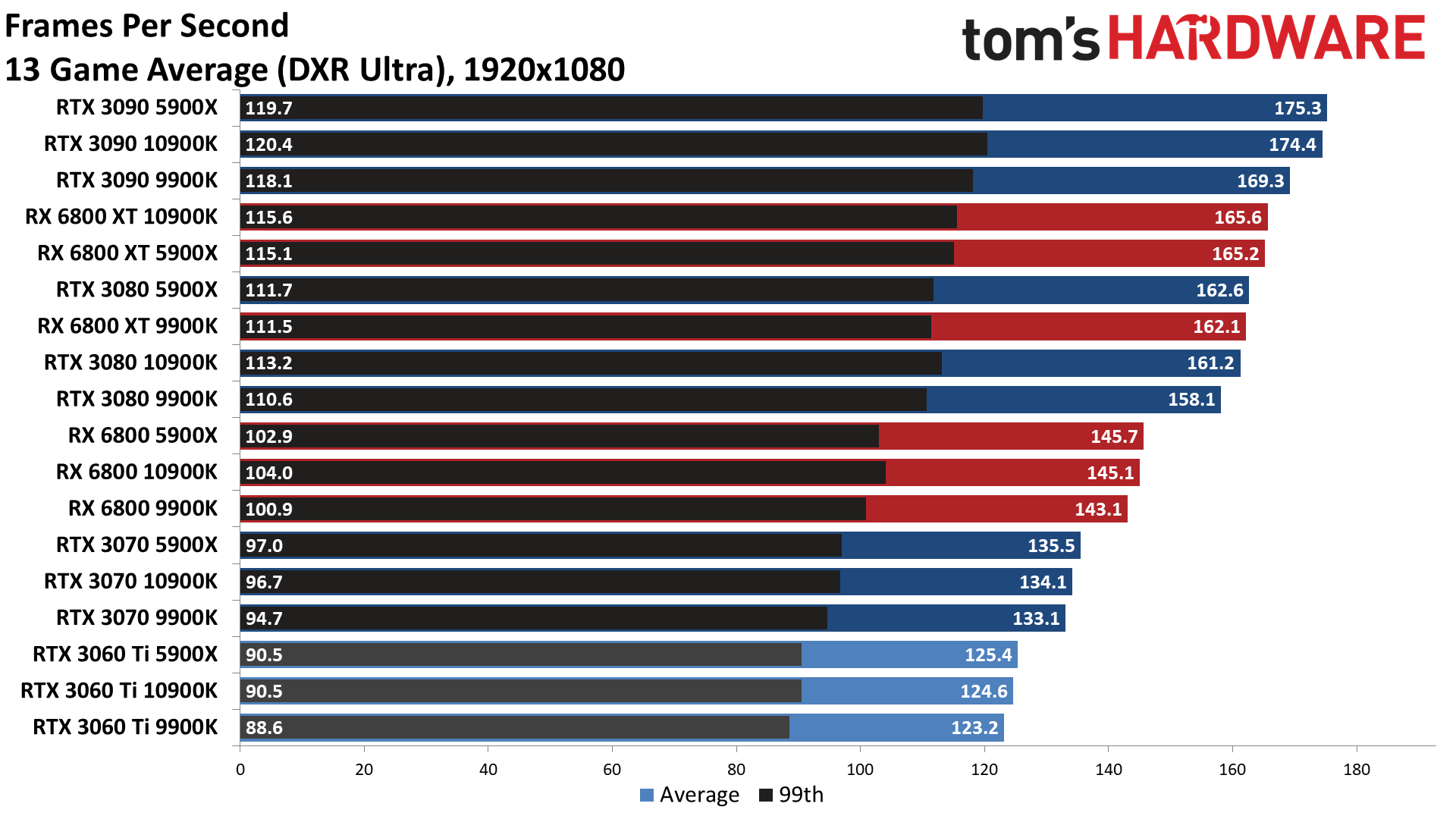
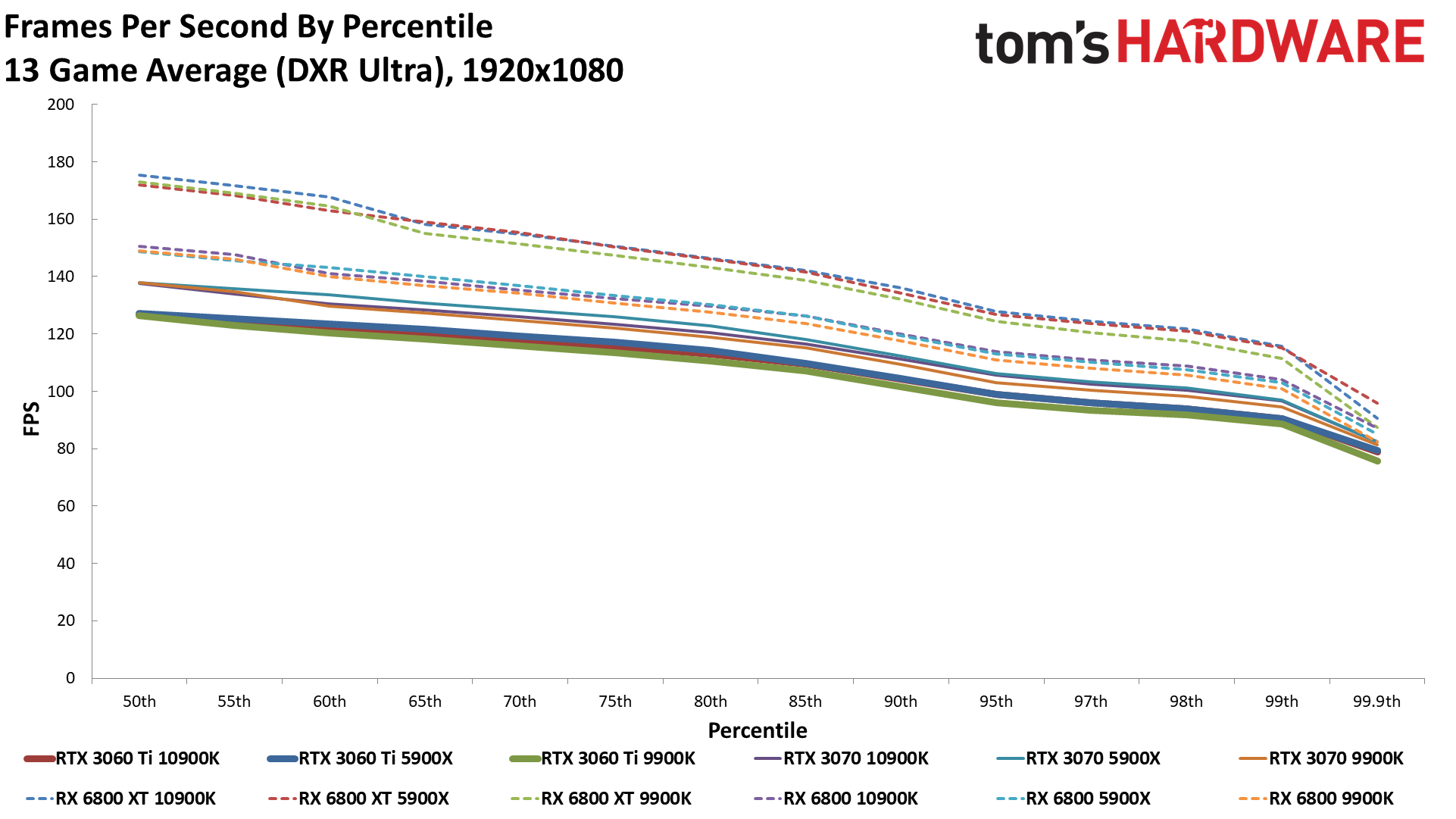
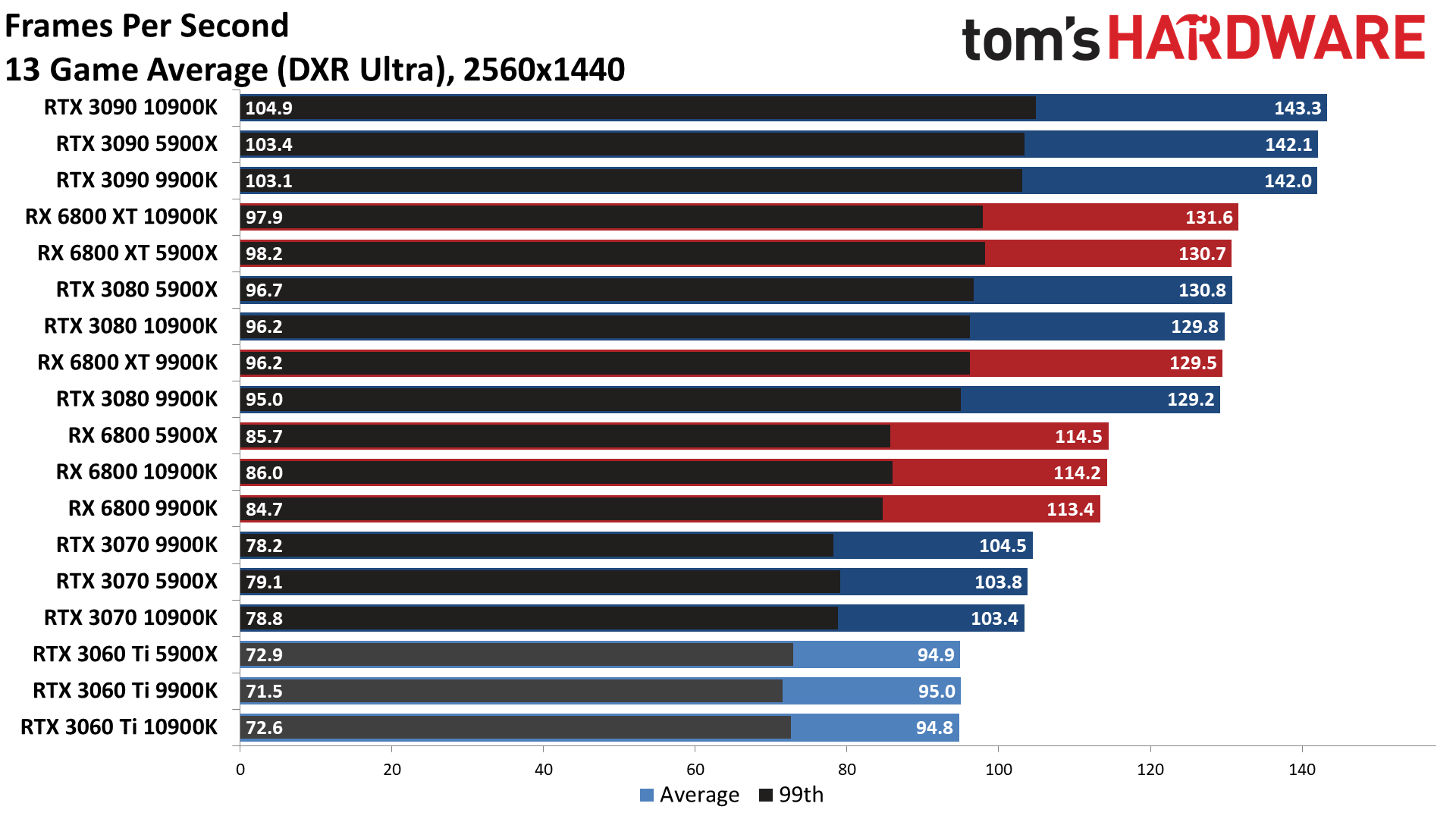
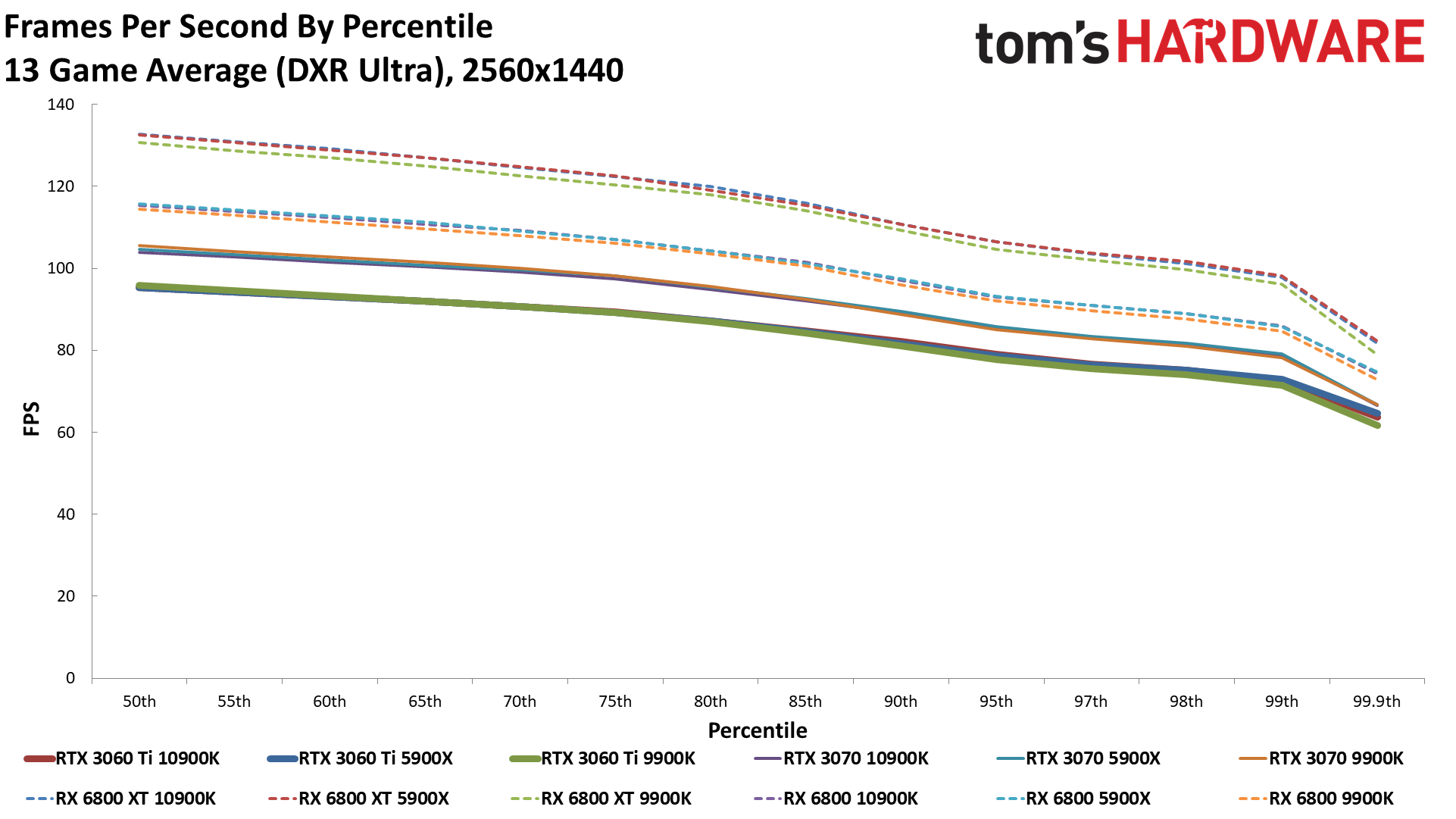
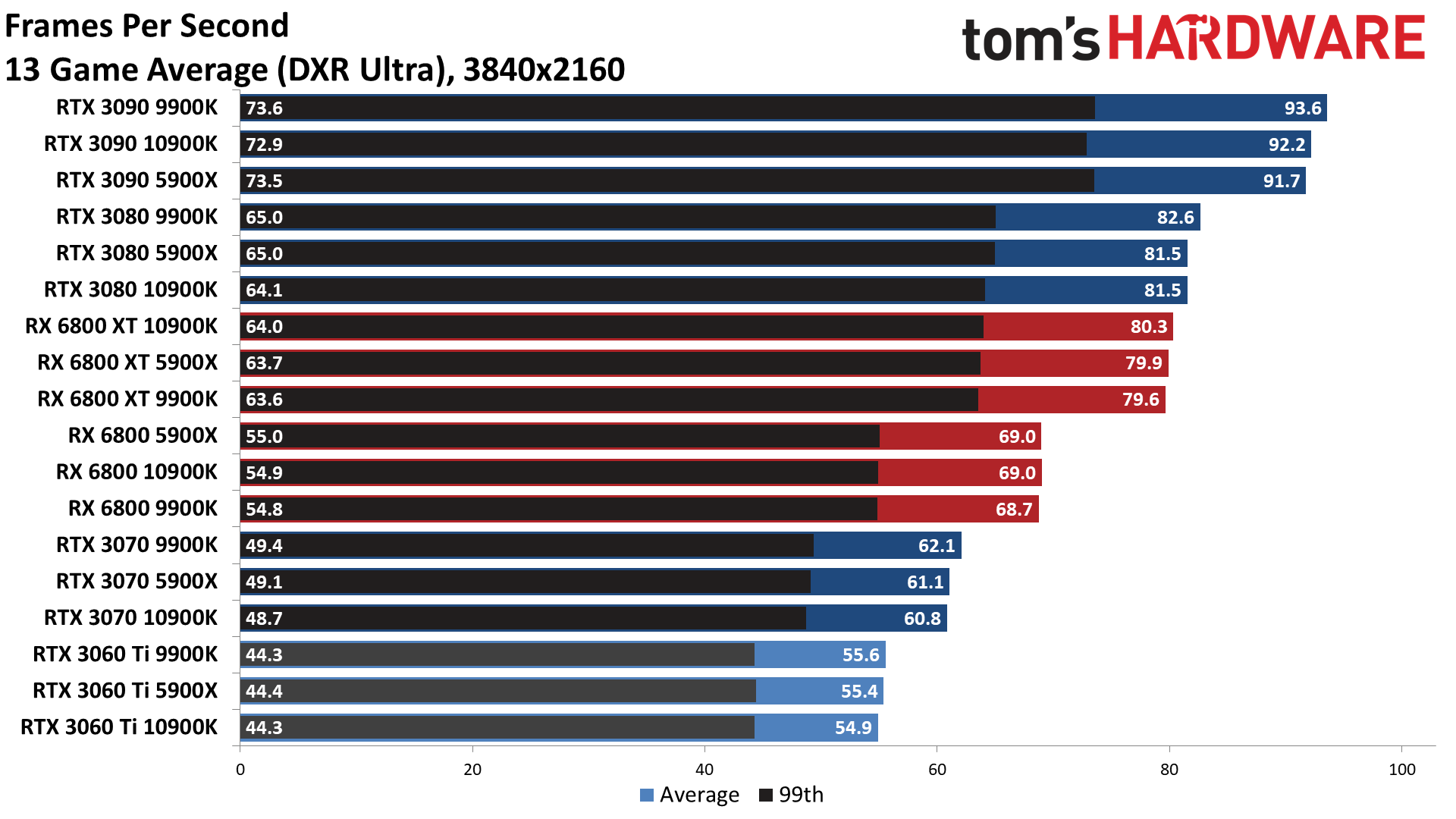
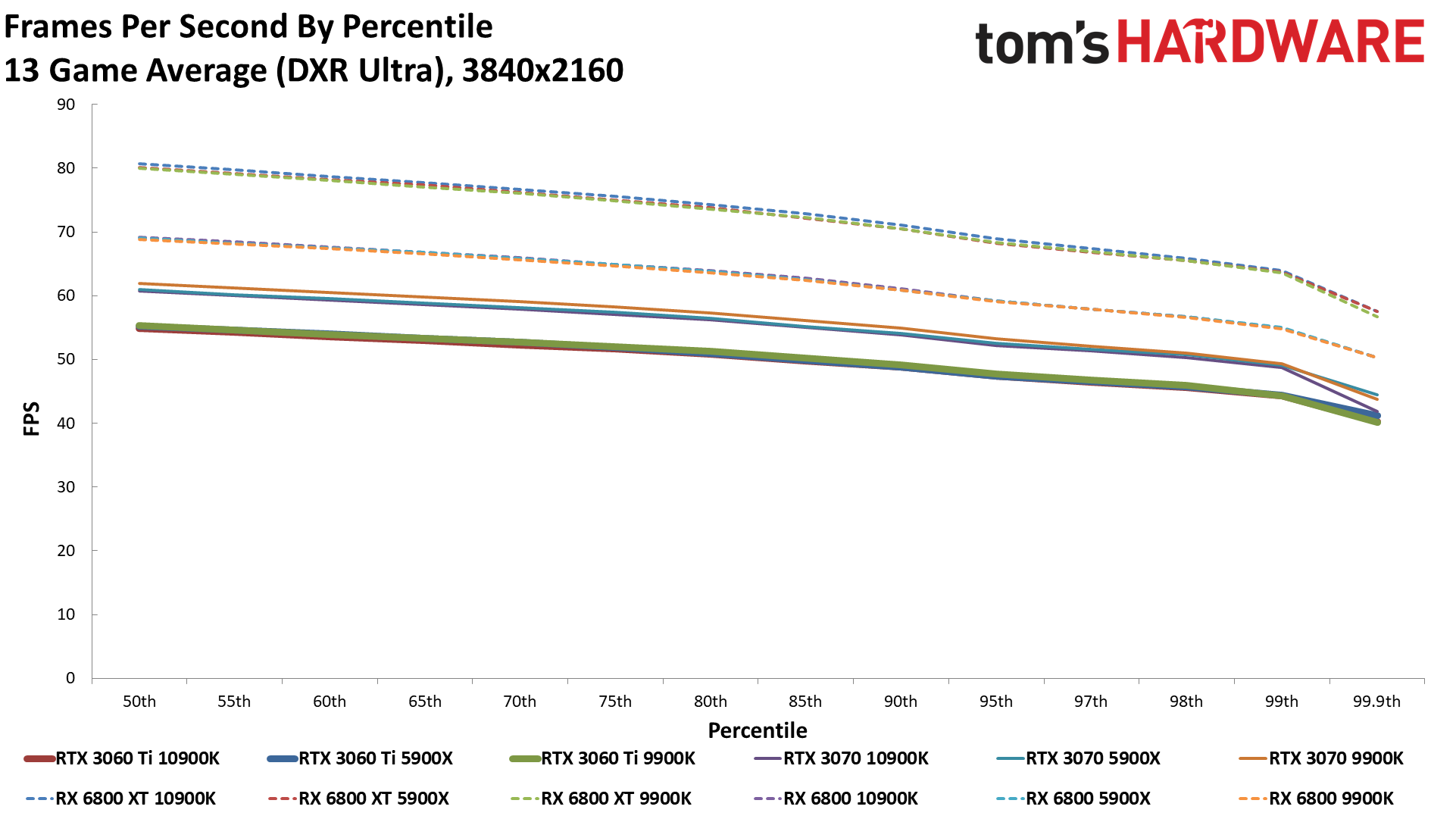
We're only looking at the latest generation Ampere and RDNA2 (aka Big Navi) GPUs, so it's no surprise that the RTX 3060 Ti falls to the bottom of these charts. That's not because it's slow so much as it's slower than the other options. Hopefully, the more mainstream pricing means that Nvidia will have a lot more GPUs to go around, though we'll be surprised if inventory lasts more than a few minutes. After Black Friday and Cyber Monday, where even previous generation cards were selling for more than 25 percent over the launch pricing, it's clear that demand for gaming GPUs is at an all-time high.
Looking at the overall results, the 3060 Ti ends up trailing the RTX 3070 by anywhere from 6 to 11 percent, depending on the CPU and resolution. Most of the individual results are about what you'd expect, but there are a few anomalies that we'll point out below. Something else to mention is that the RTX 3060 Ti breaks 60 fps at 1440p in all but two of the 13 games tested — and those two exceptions had ray tracing enabled.
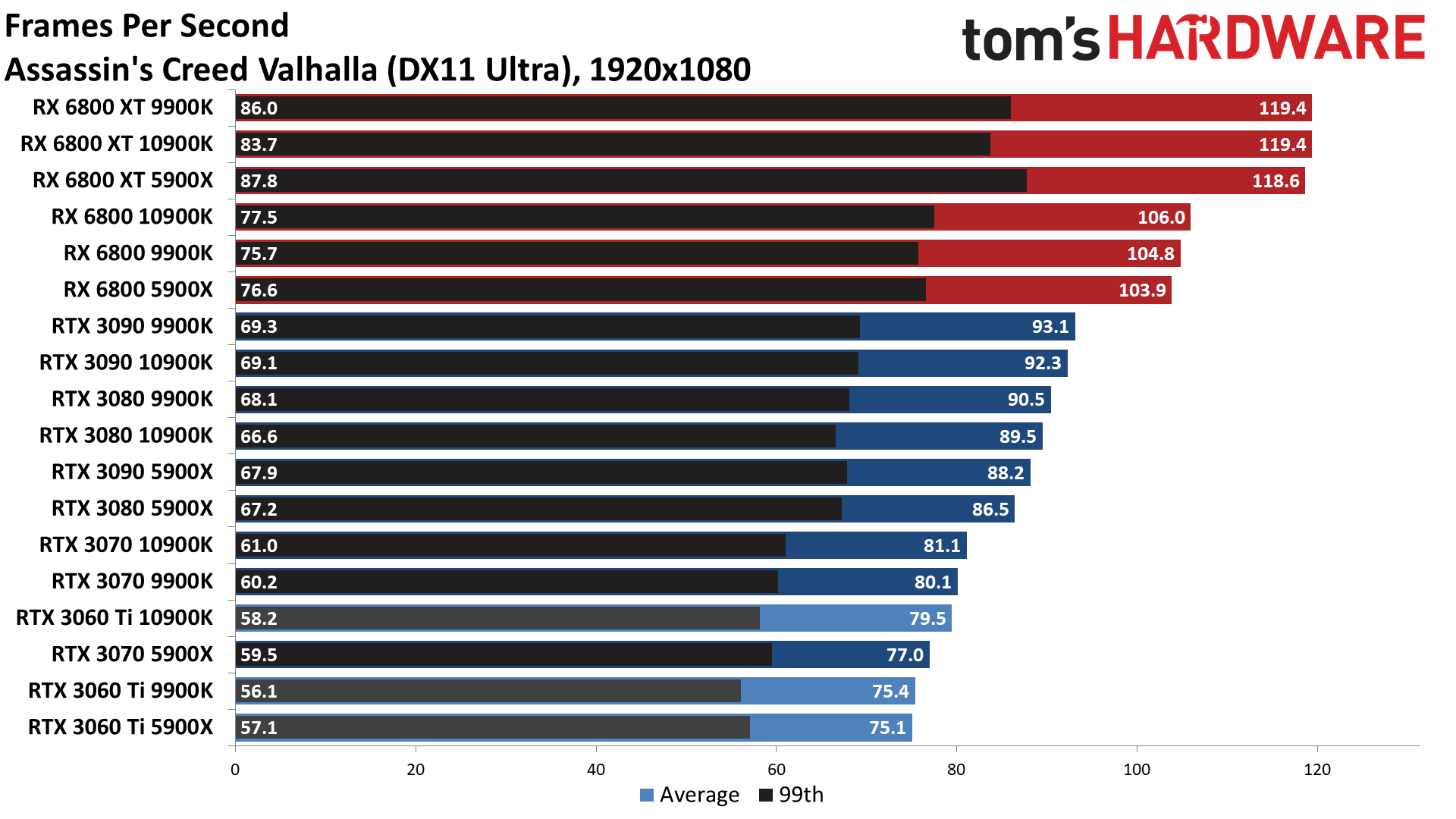
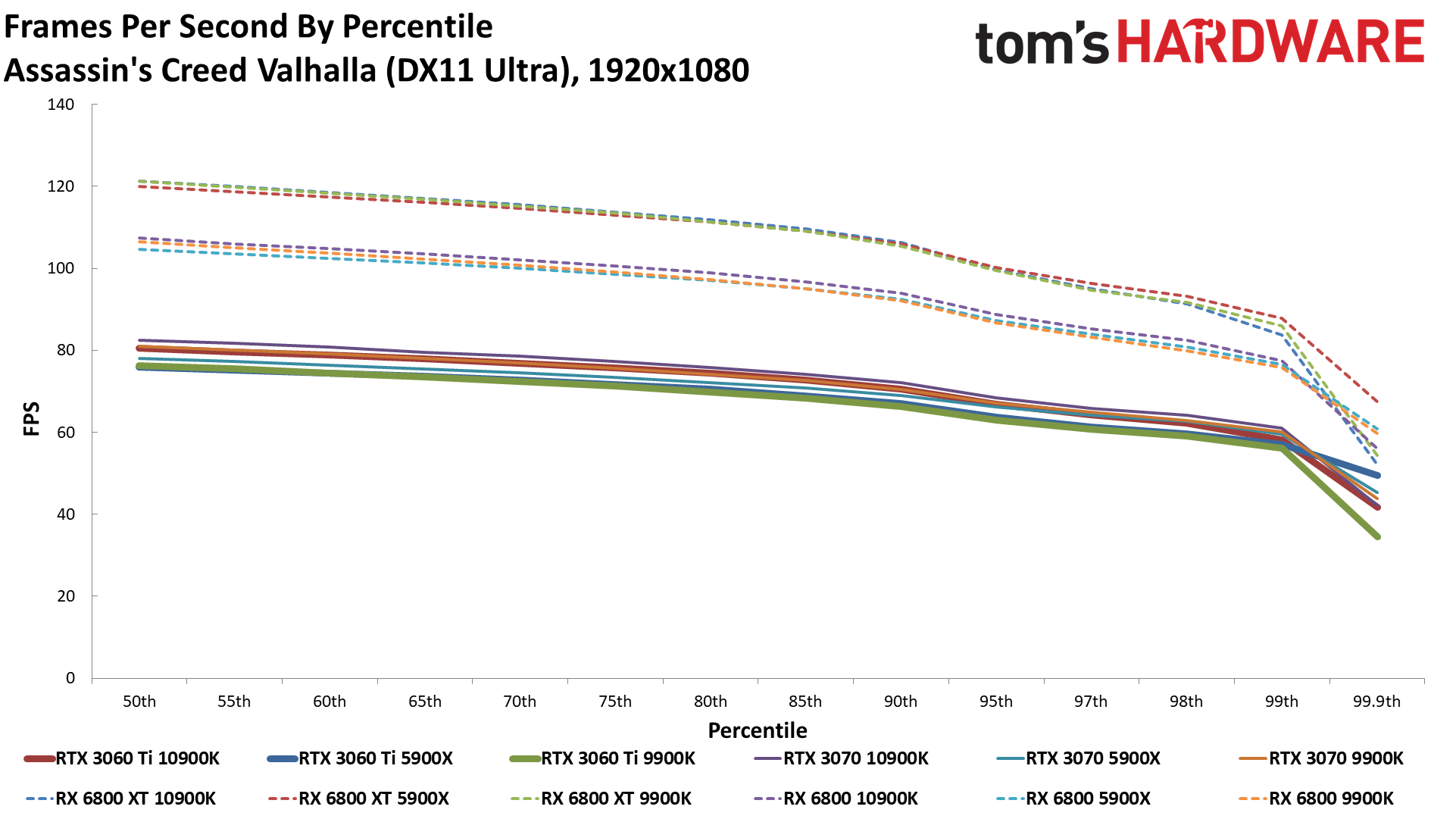
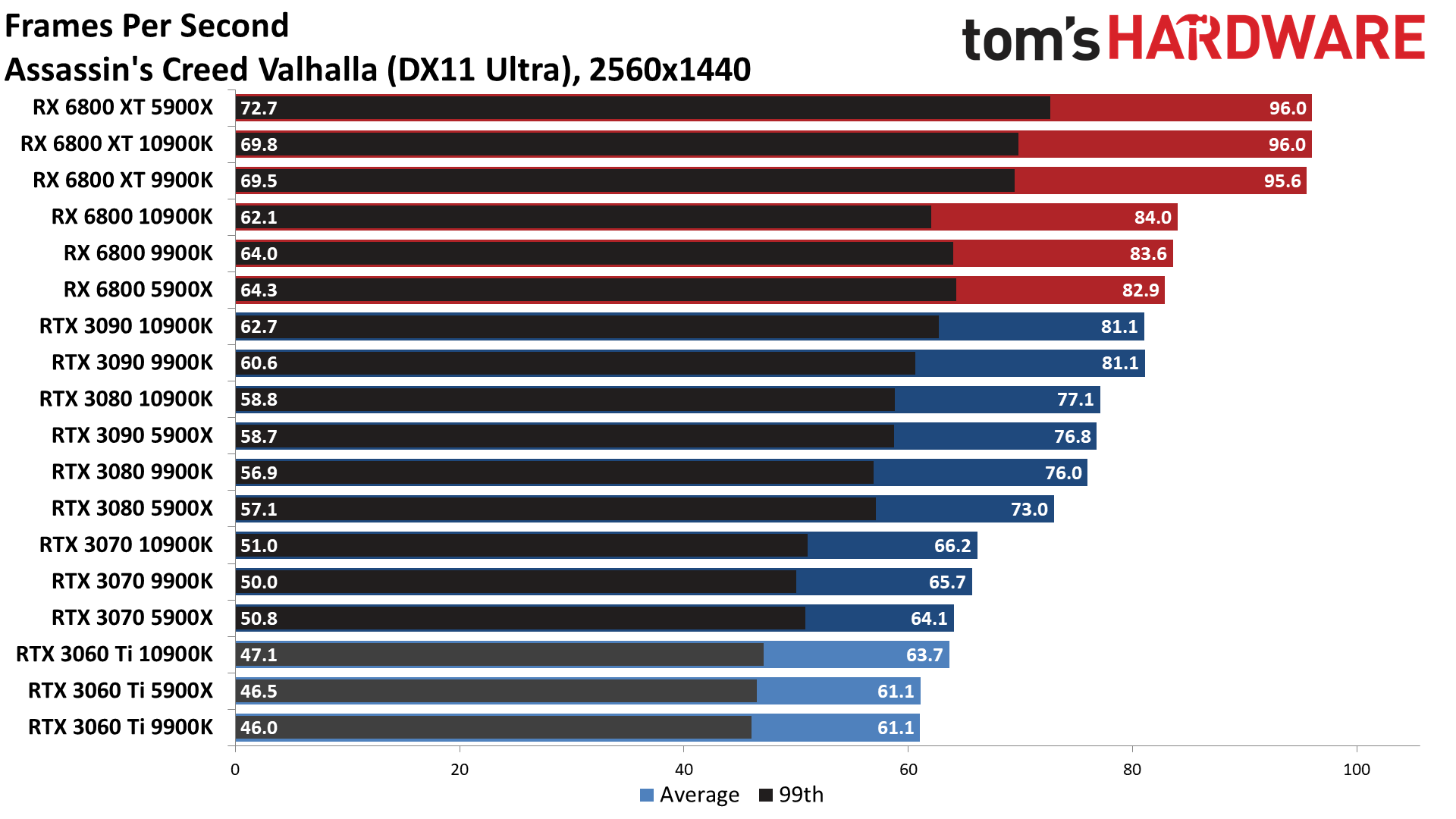
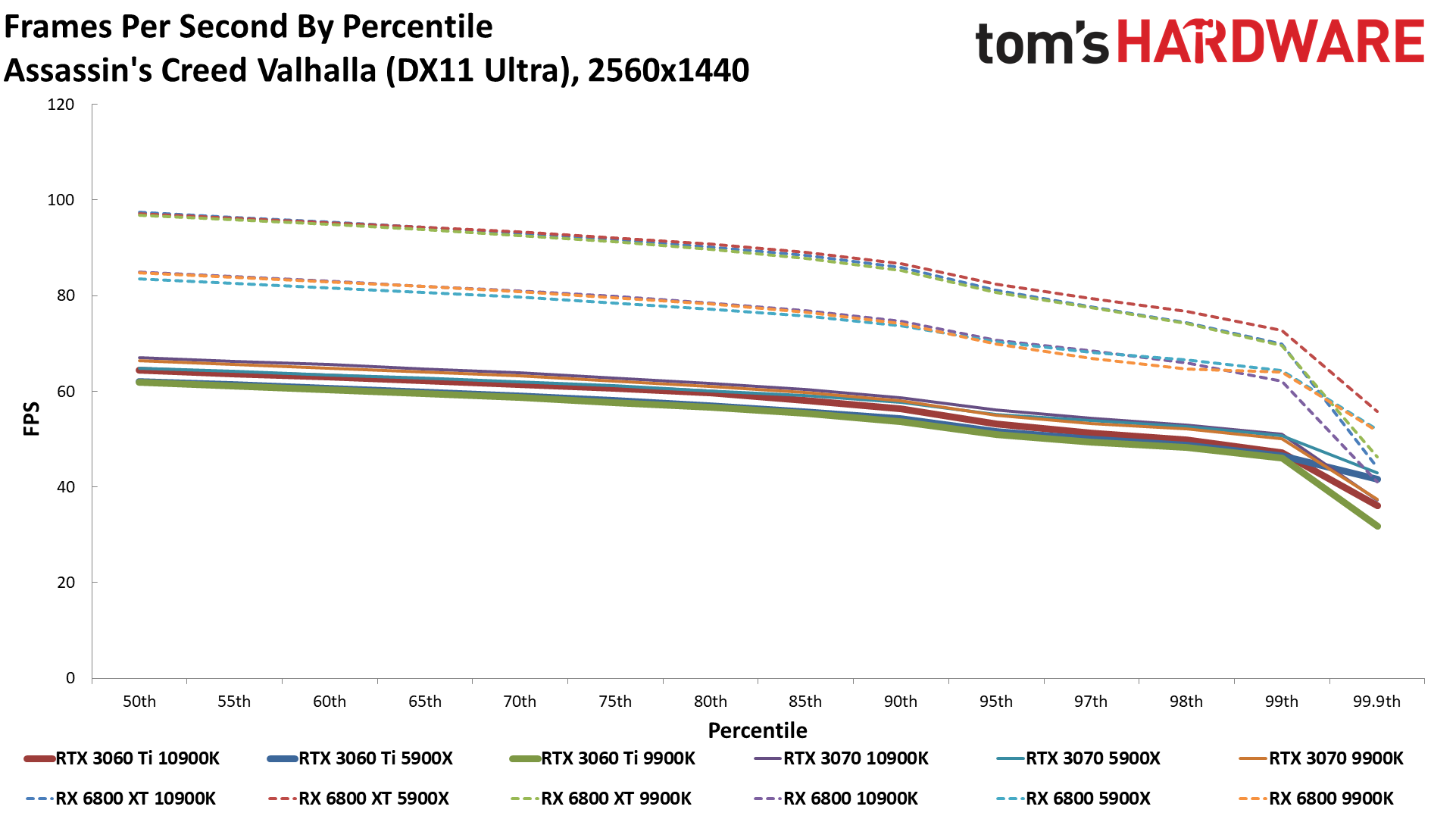
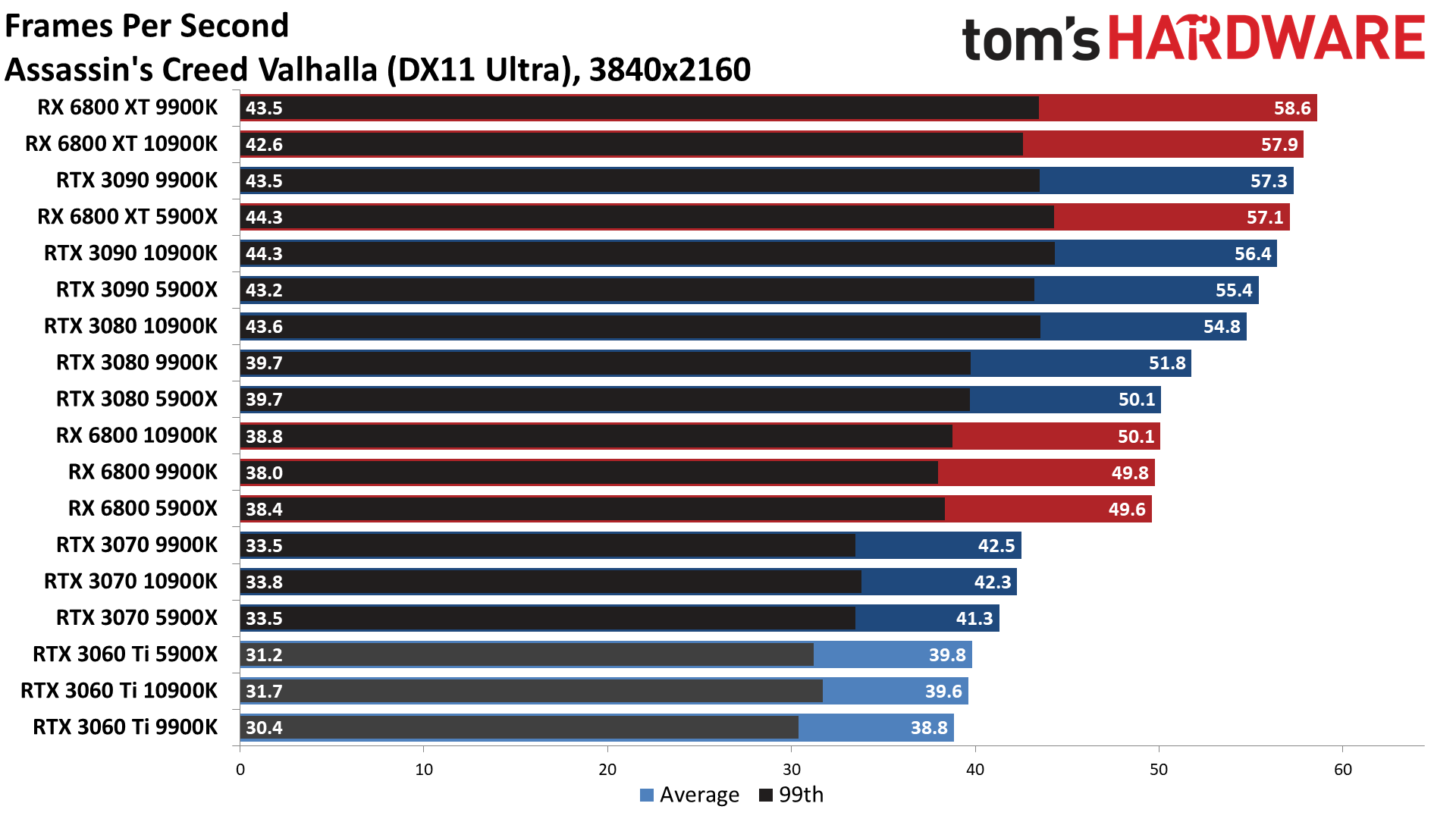
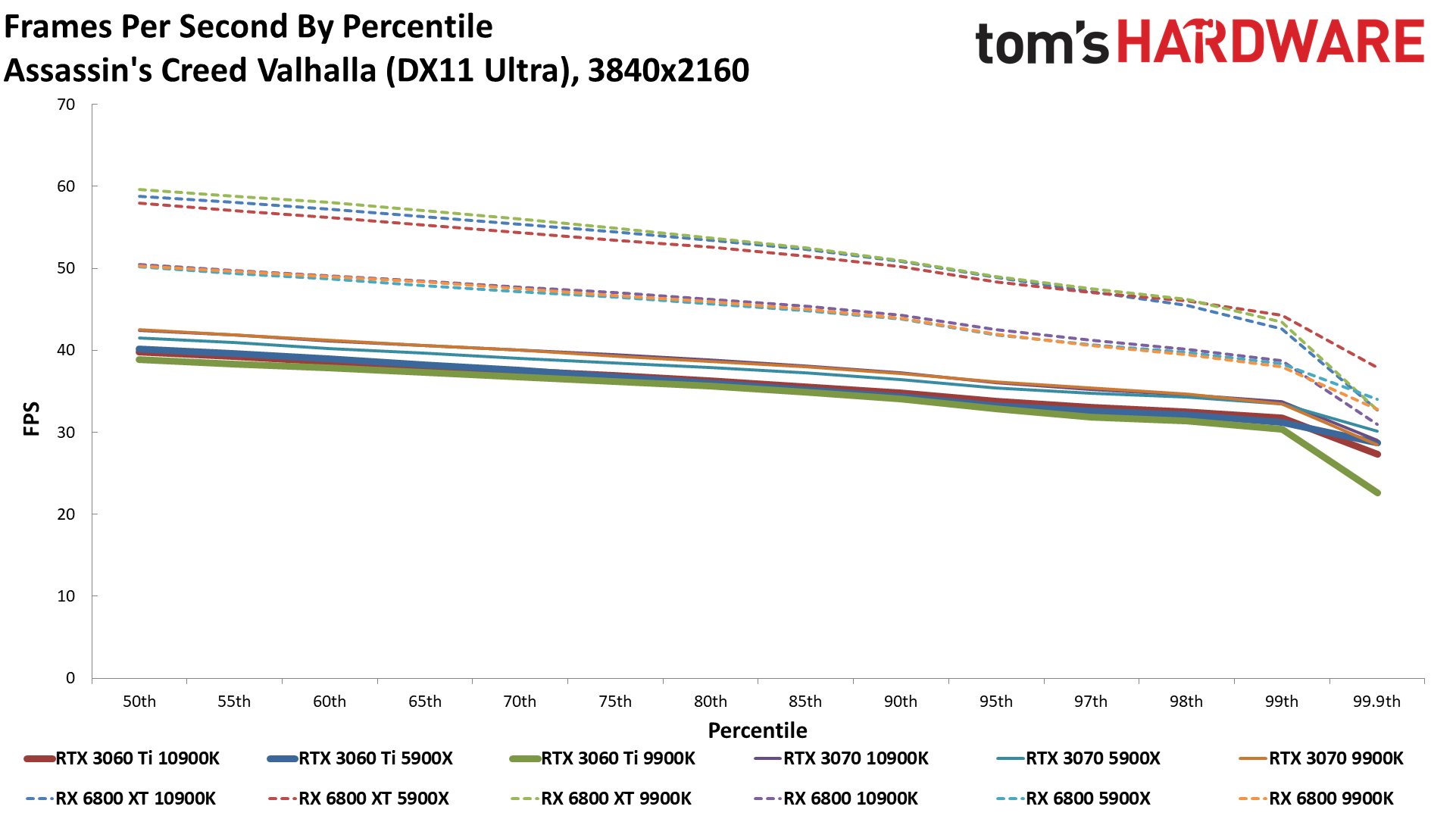
We're going in alphabetical order, so Assassin's Creed Valhalla is the first in our extended test suite. This is a new game, promoted by AMD… and damn if AMD doesn't crush Nvidia here, at least when we're looking at the 6800 series. We expect things will improve over the coming weeks, and this is a DirectX 11 game, so drivers can affect performance more than in DX12 or Vulkan games. It's also quite the demanding game for the 3060 Ti, just barely managing to break 60 fps at 1440p. Of course, we don't have a direct AMD competitor for the 3060 Ti yet, so we'll have to wait and see how this changes over time.
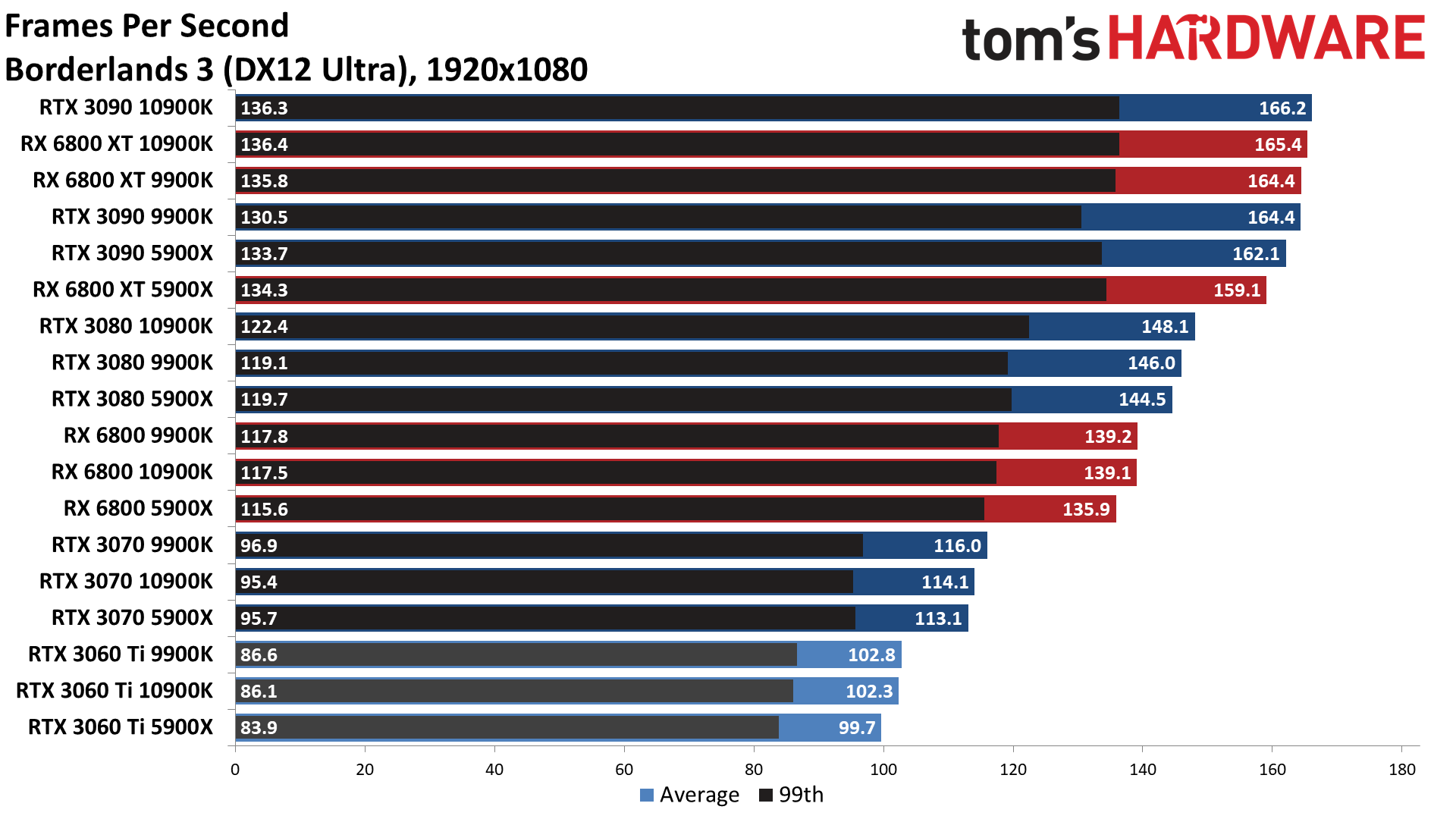
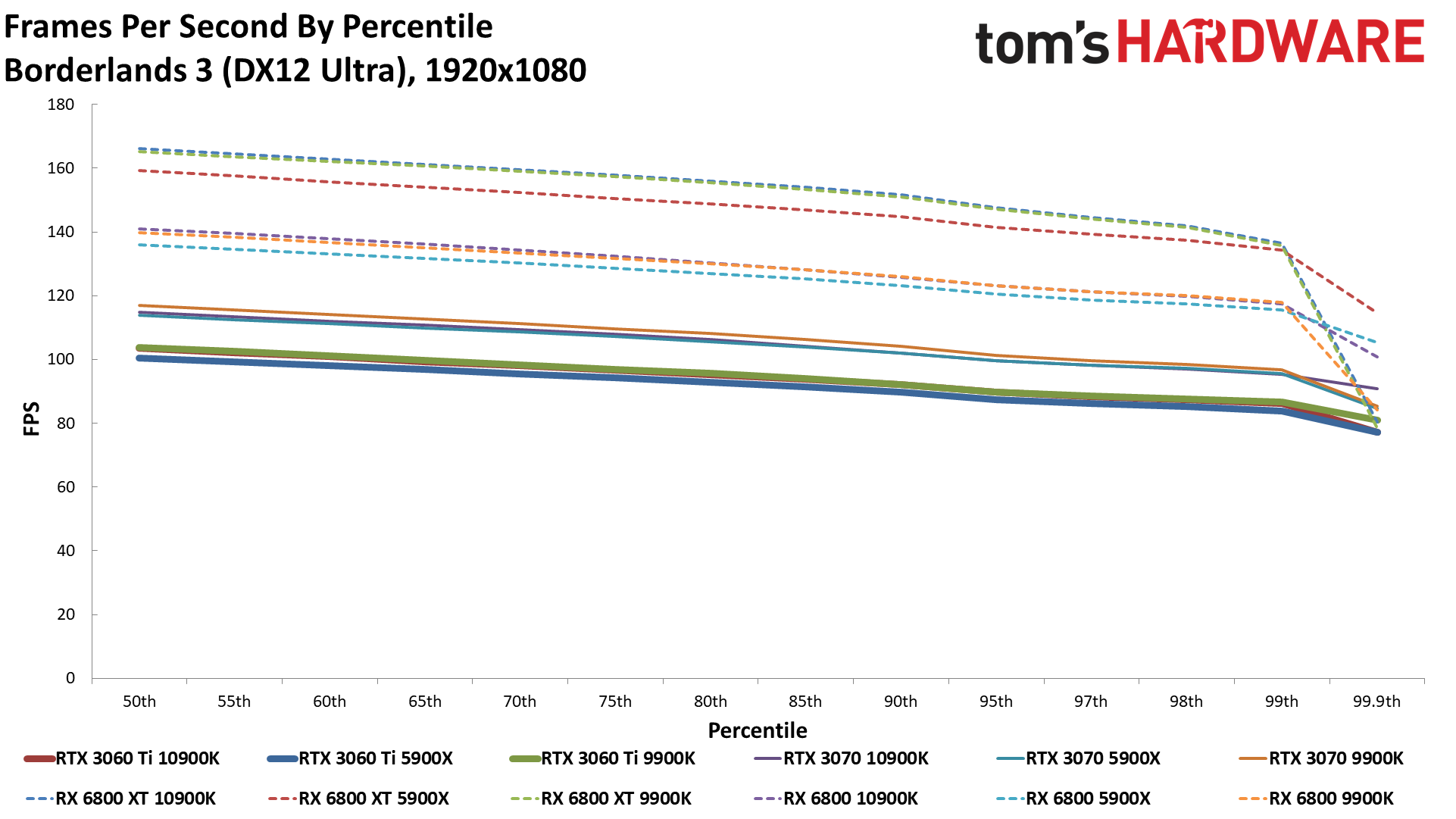
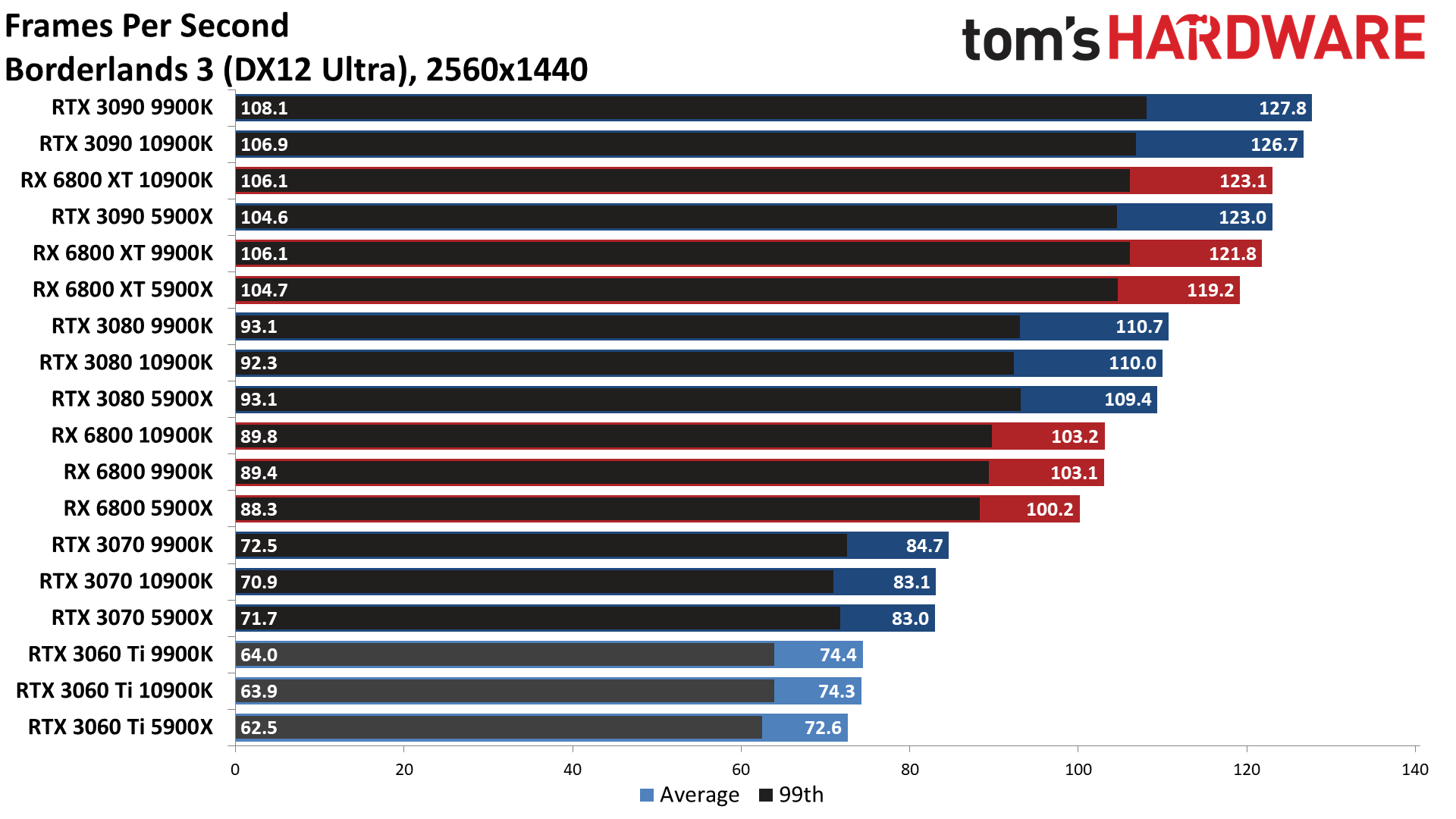
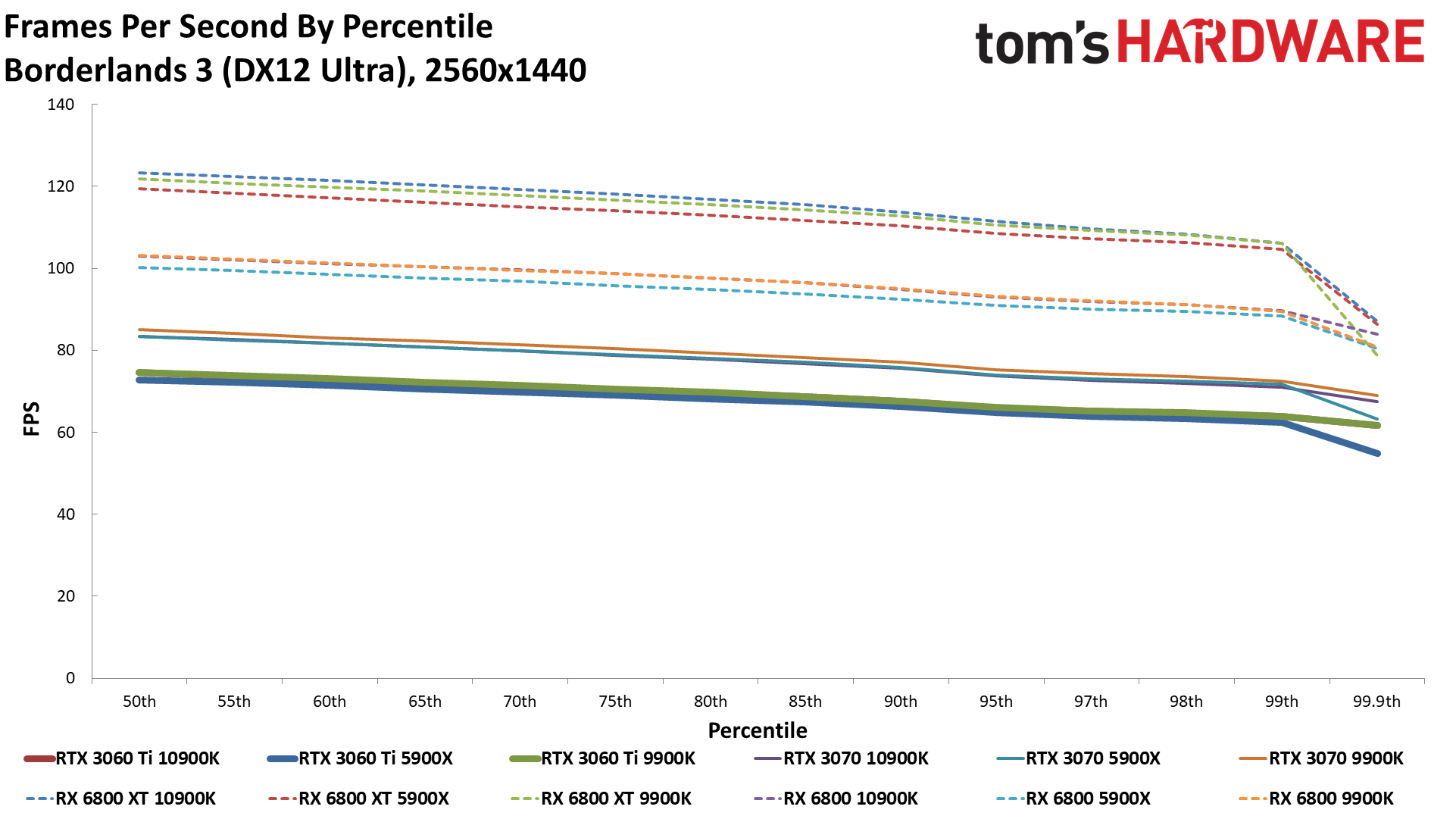
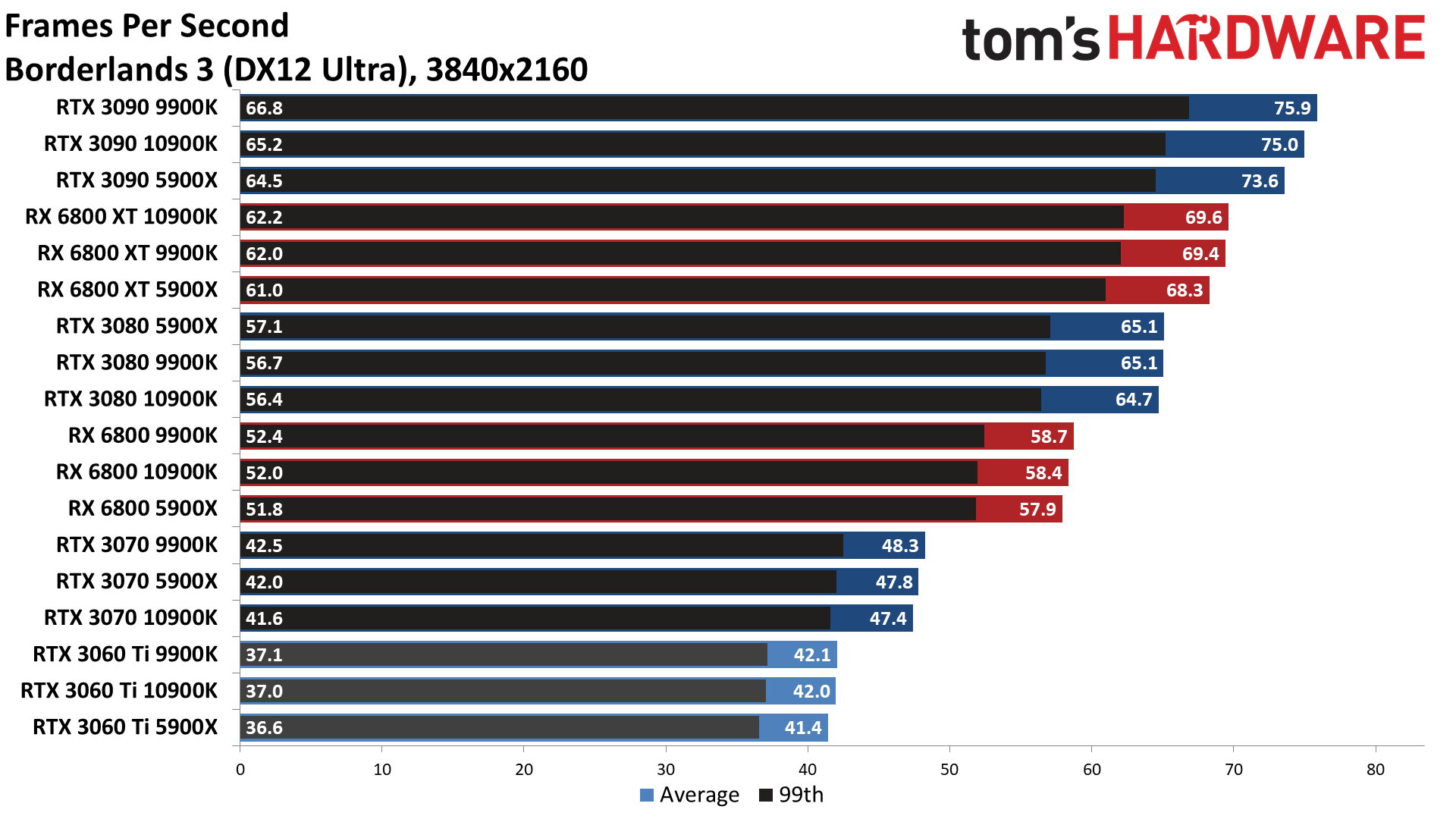
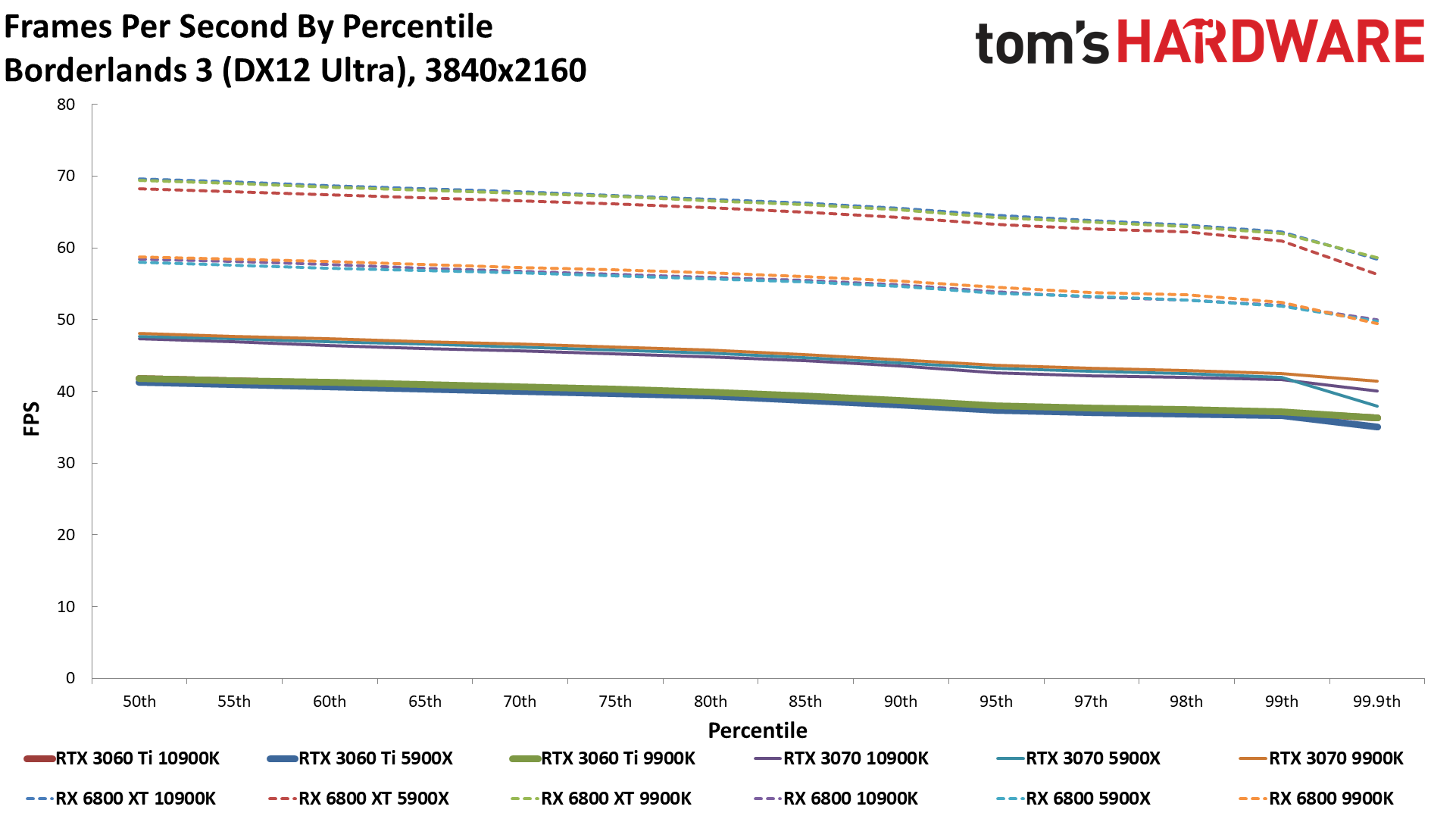
Borderlands 3 is another AMD promotional game, and this time we're using the DirectX 12 (DX12) API. There's not much to say about the 3060 Ti here, though it's interesting that AMD's new RX 6800 GPUs (and the RTX 3090) do slightly better on our Intel CPUs than on the 5900X, while the other GPUs don't seem to care much about the processor.
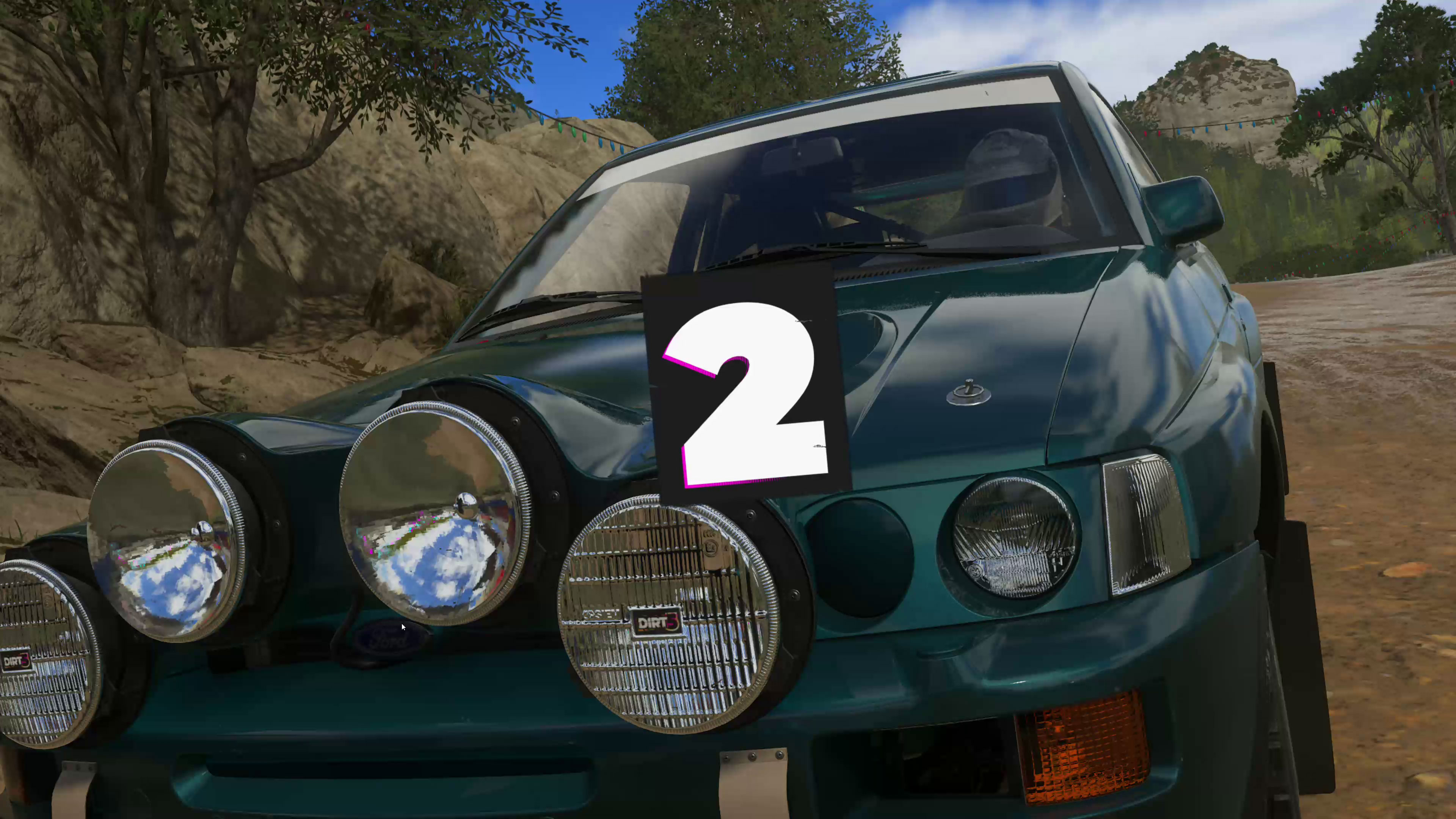
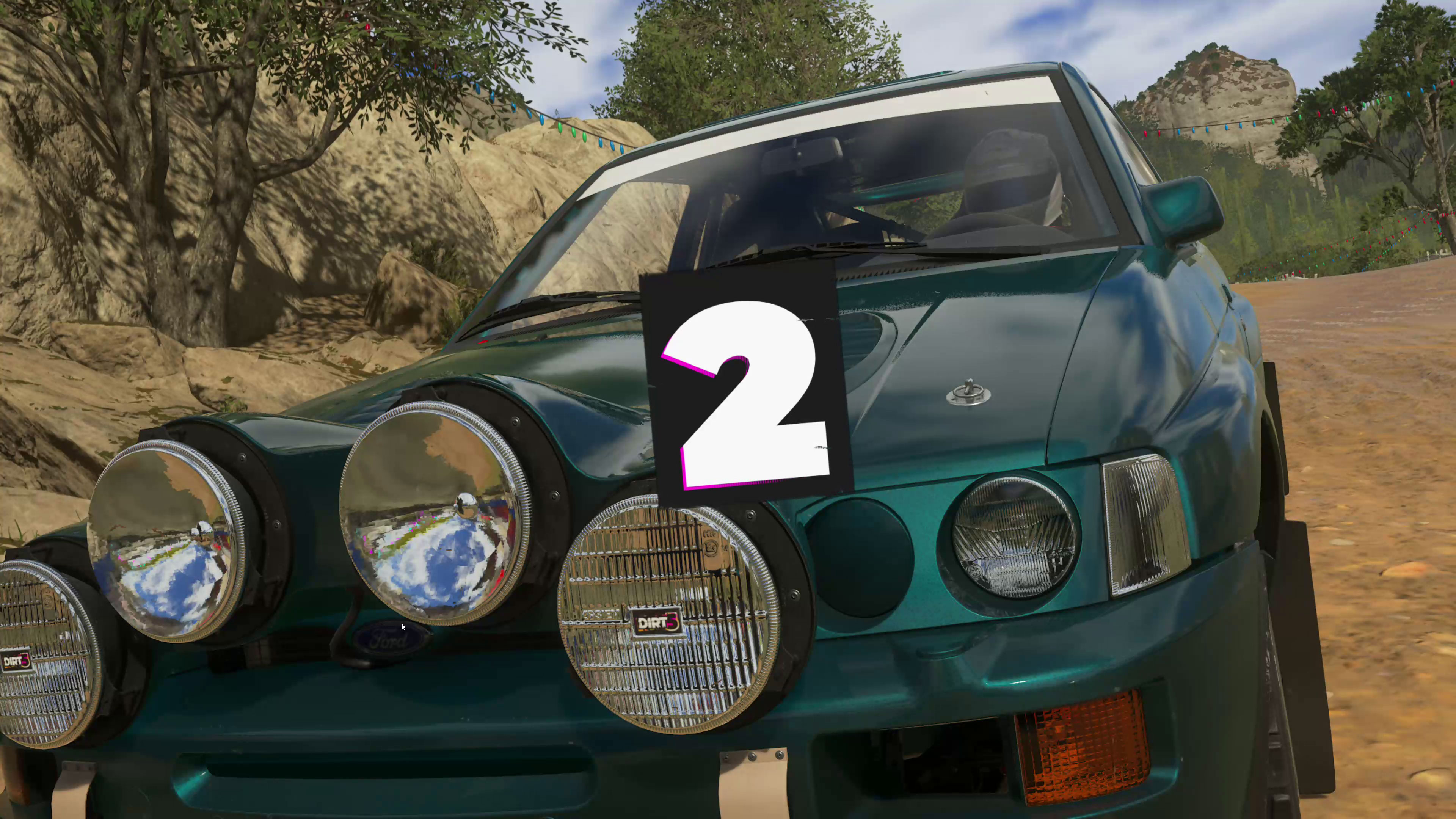
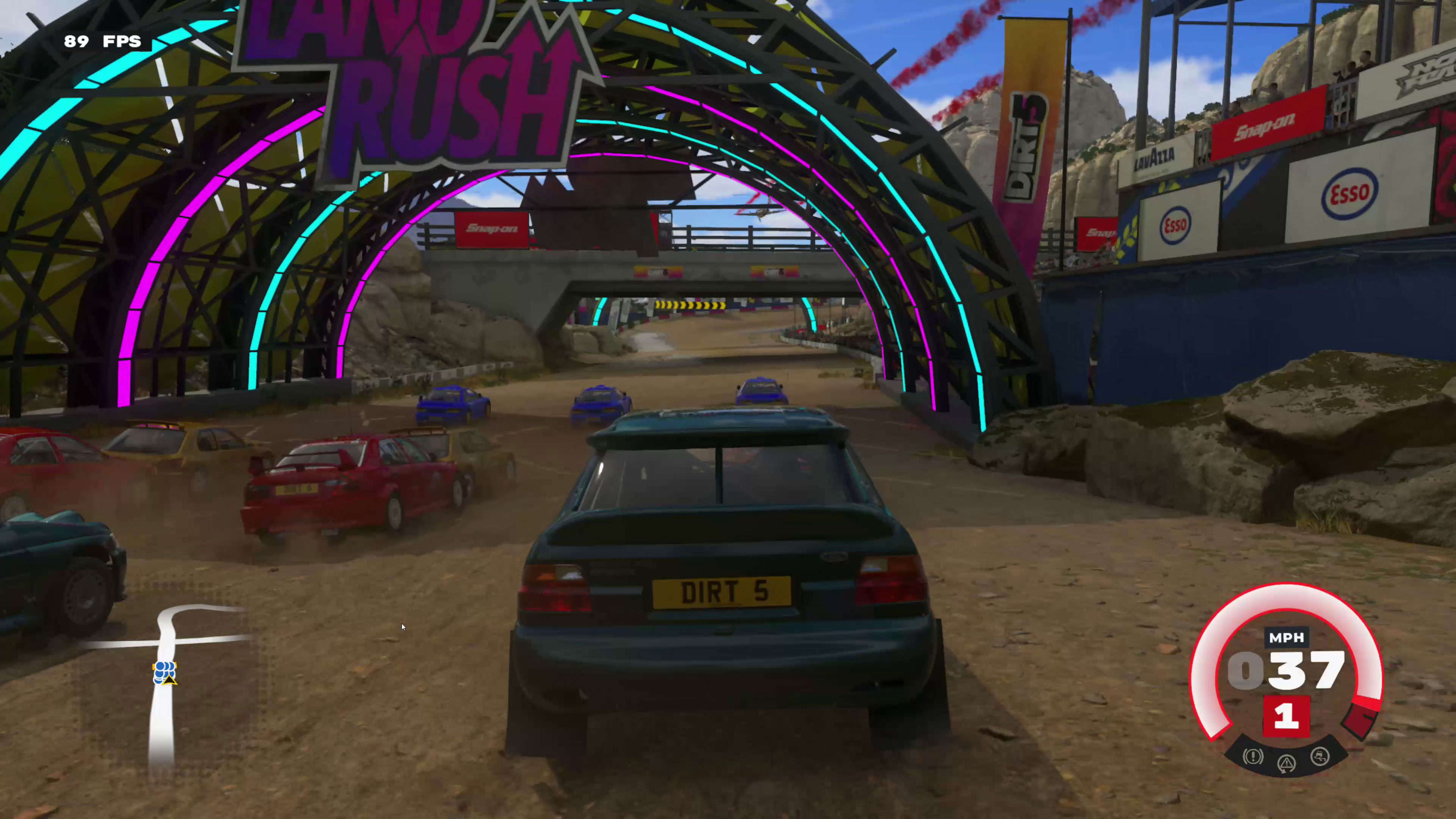
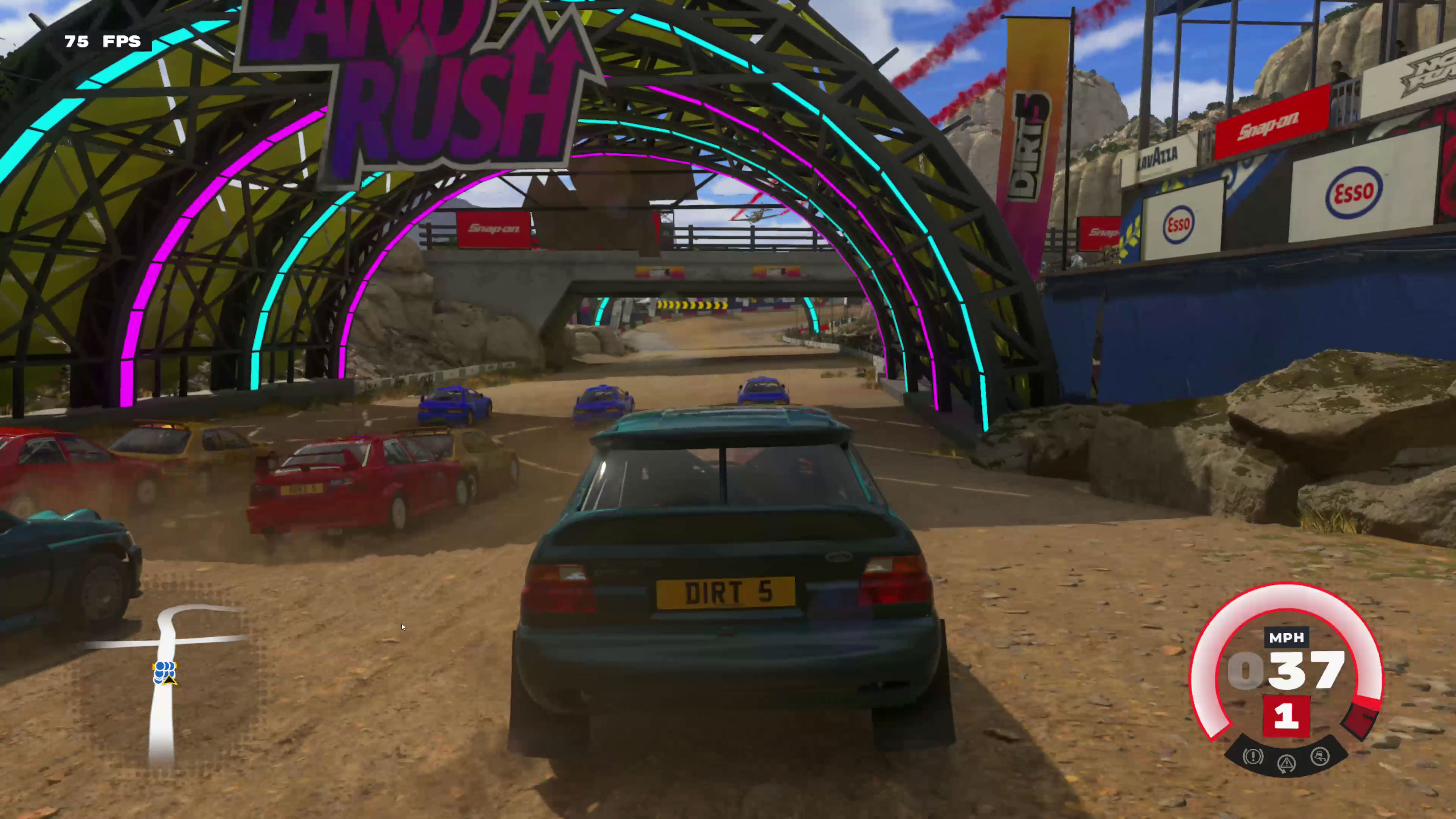
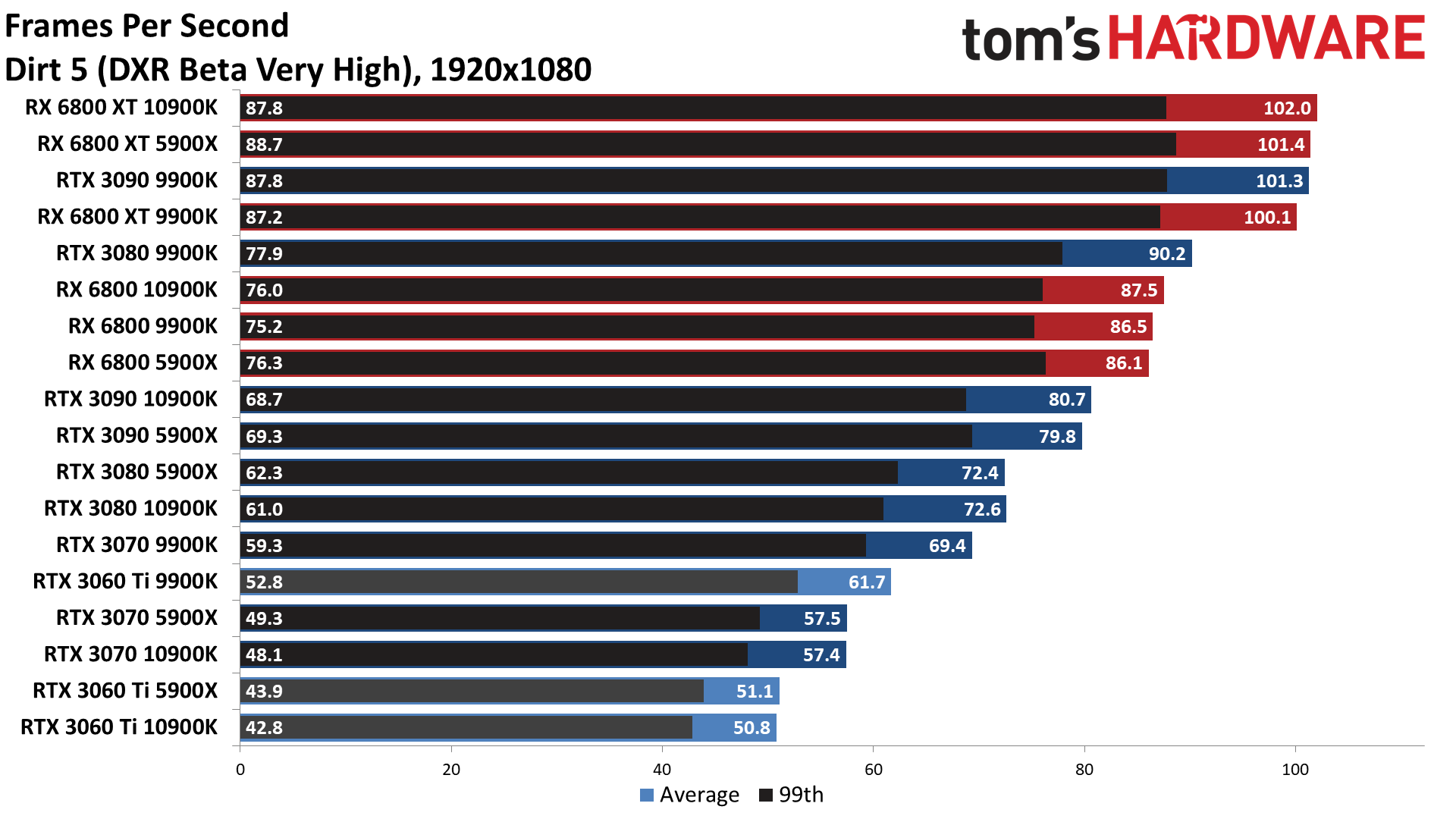
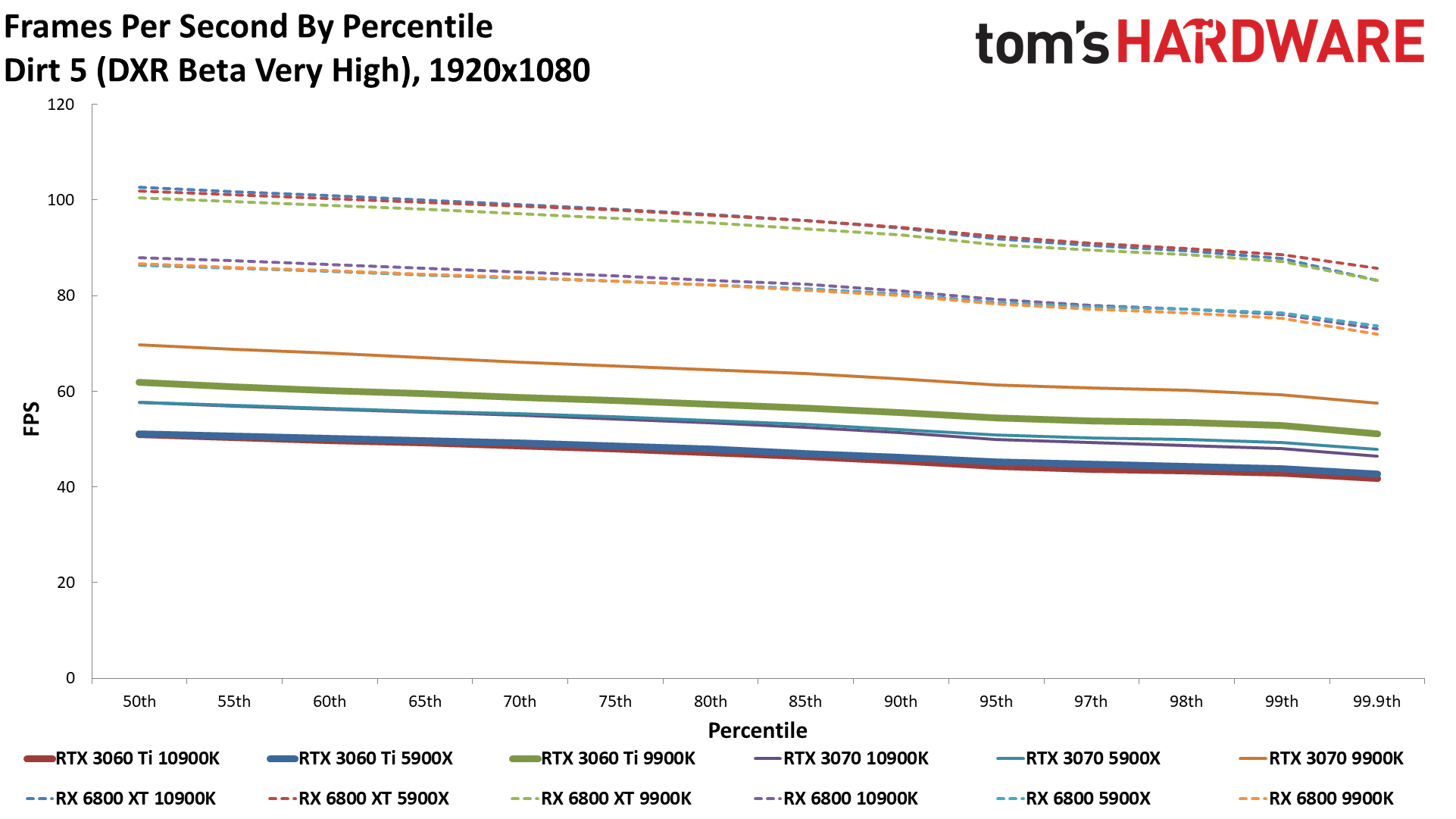
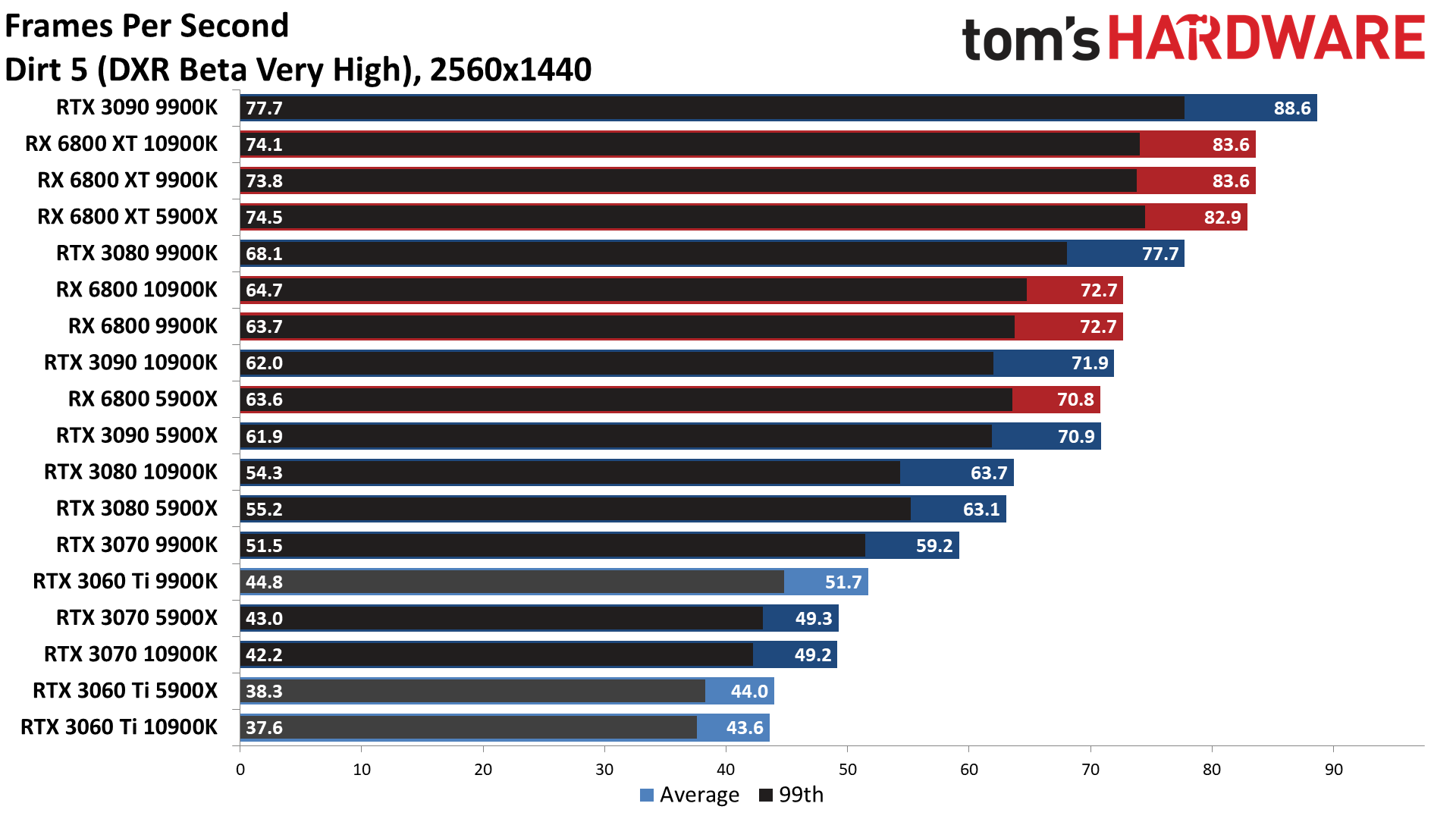
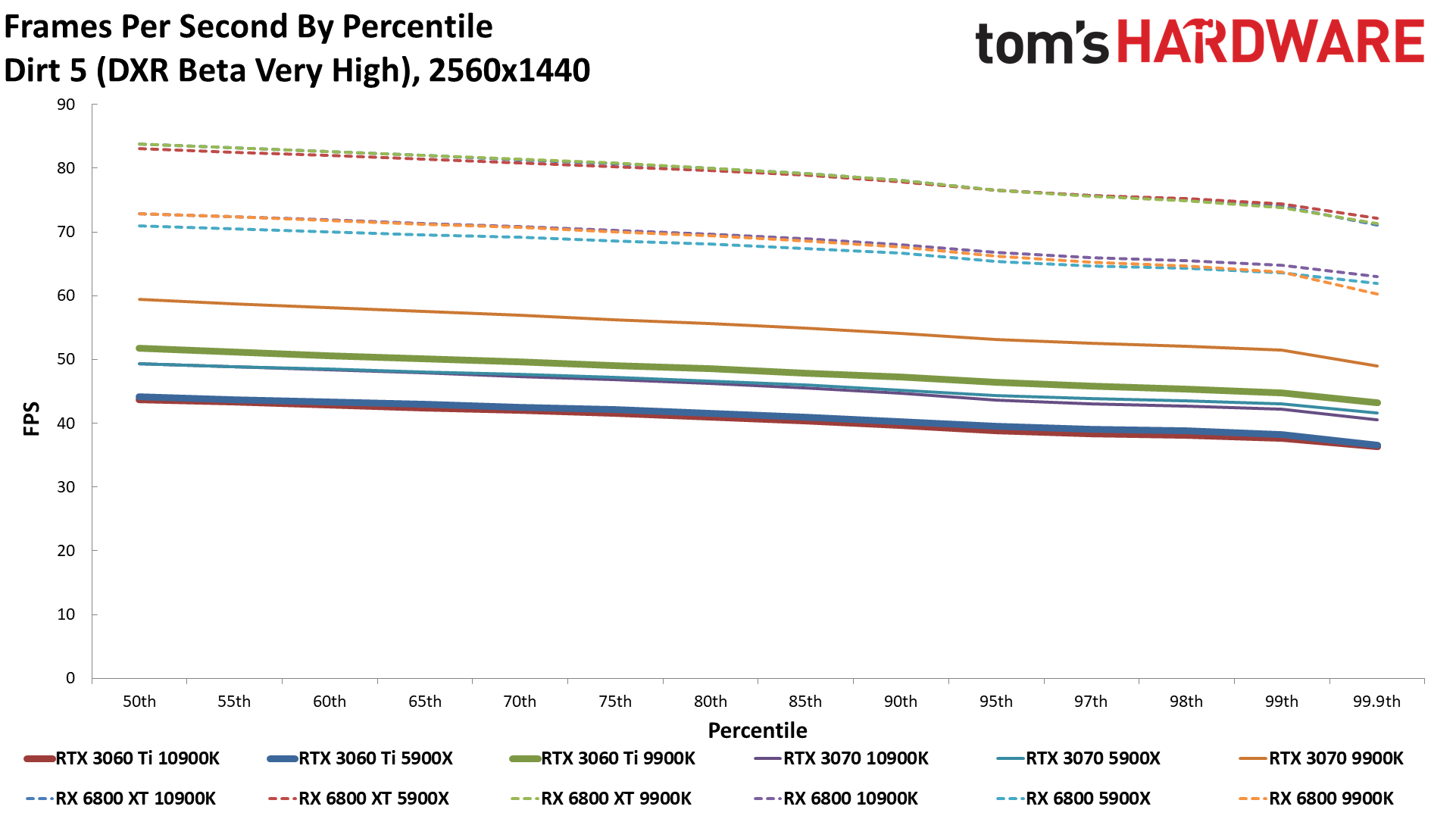
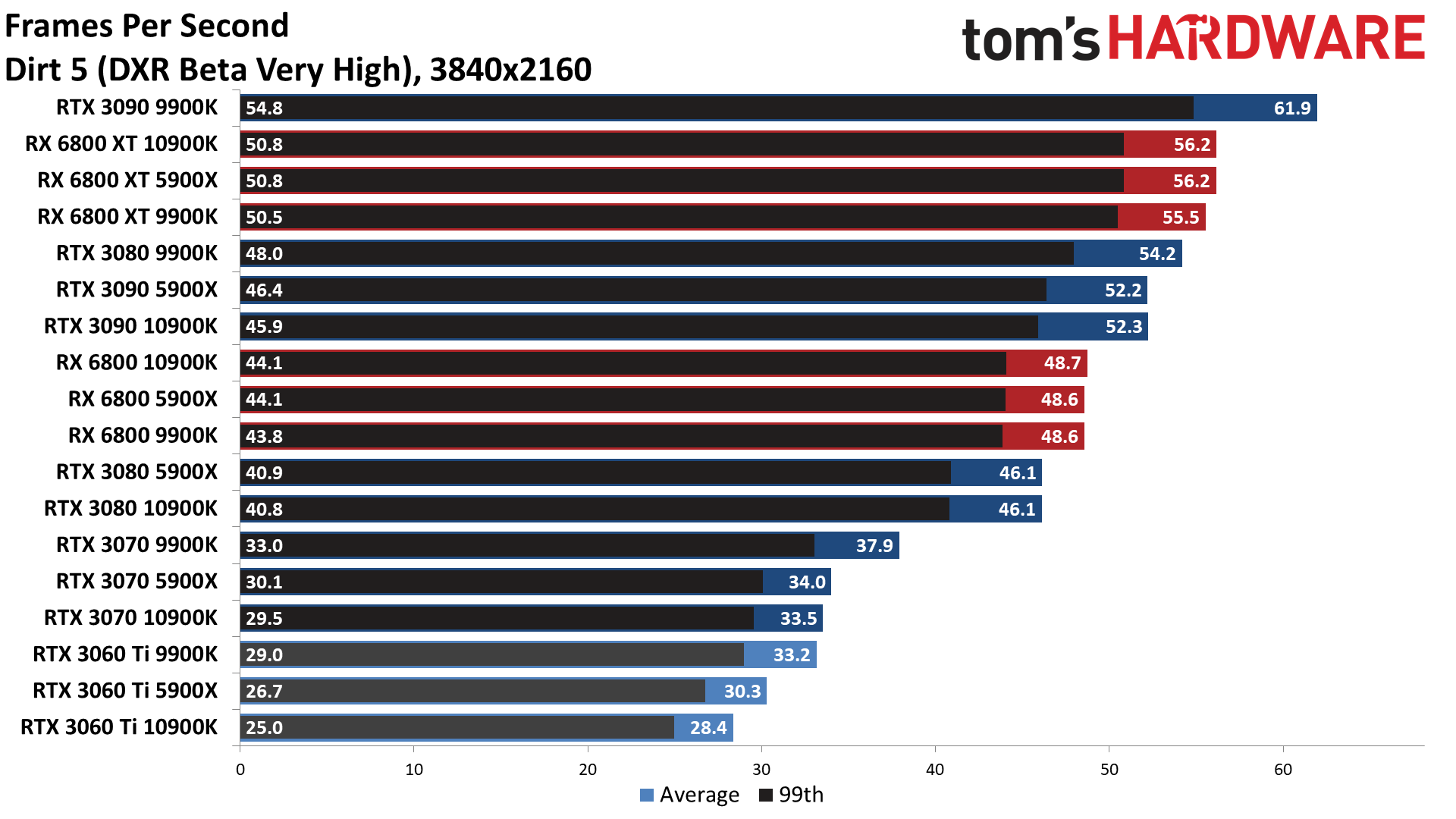
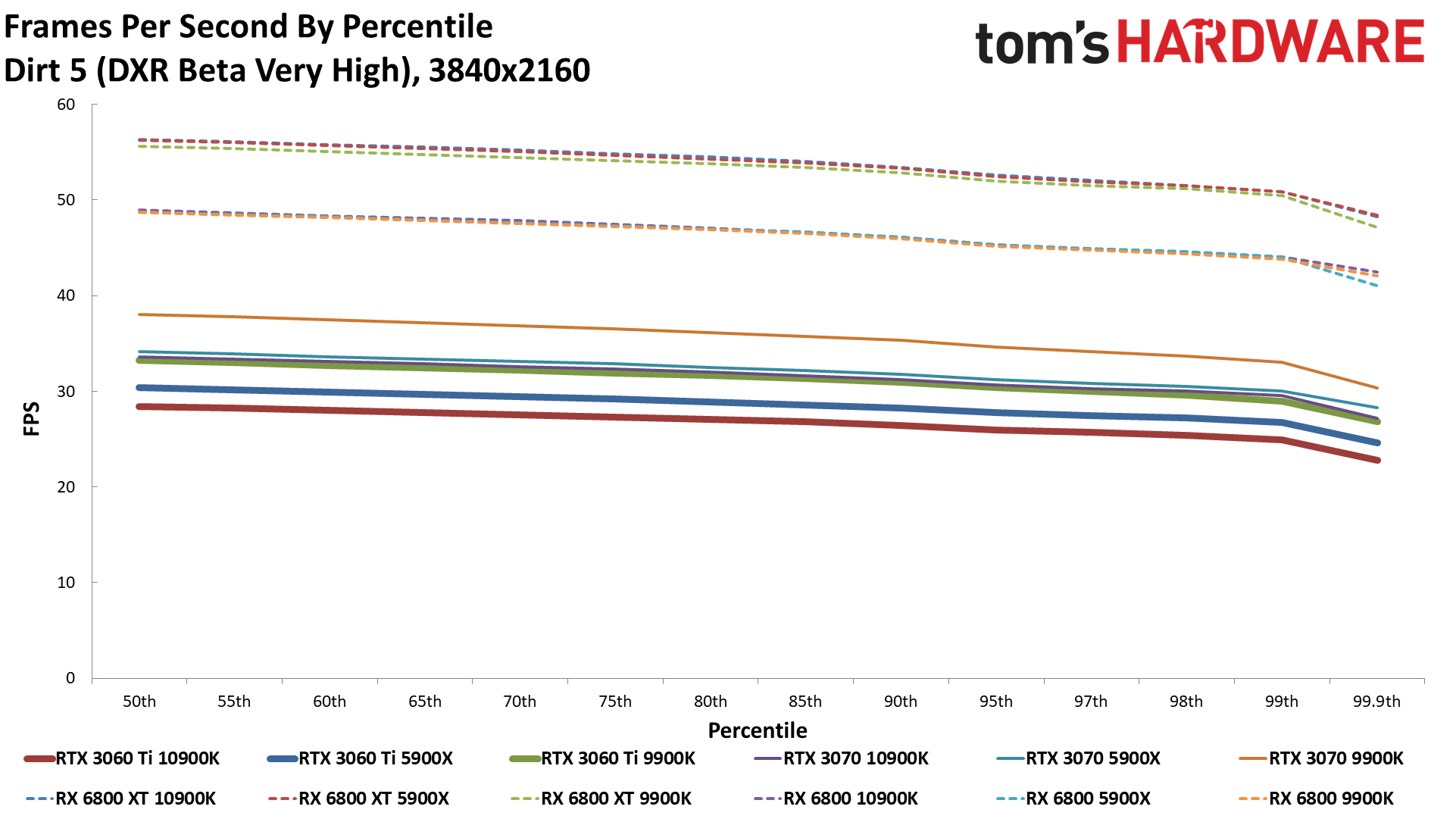
Huge caveat here: Dirt 5 is an AMD promotional game and we're using a beta / early access DXR patch. This is one of just two games that are promoted by AMD and feature ray tracing effects, the other being Godfall. But Godfall doesn't support DXR on Nvidia GPUs yet, so this is our only real look at how an AMD-optimized DXR game might behave. Again, big scoops of salt, but AMD GPUs come out ahead in most instances relative to their Nvidia counterparts. The RTX 3060 Ti also only breaks 60 fps at 1080p on the 9900K, and not by much.
Get Tom's Hardware's best news and in-depth reviews, straight to your inbox.
Speaking of which, something else that's interesting is how much better the Nvidia cards do on the Core i9-9900K compared to the other two platforms. Chalk it up to beta wonkiness, and let's also note that the ray traced shadows don't particularly change the appearance of the game much (swipe through the gallery to see the comparison screenshots). It looks more like a contrast filter has been applied with DXR enabled, and the performance hit is lower than many other DXR games as well.
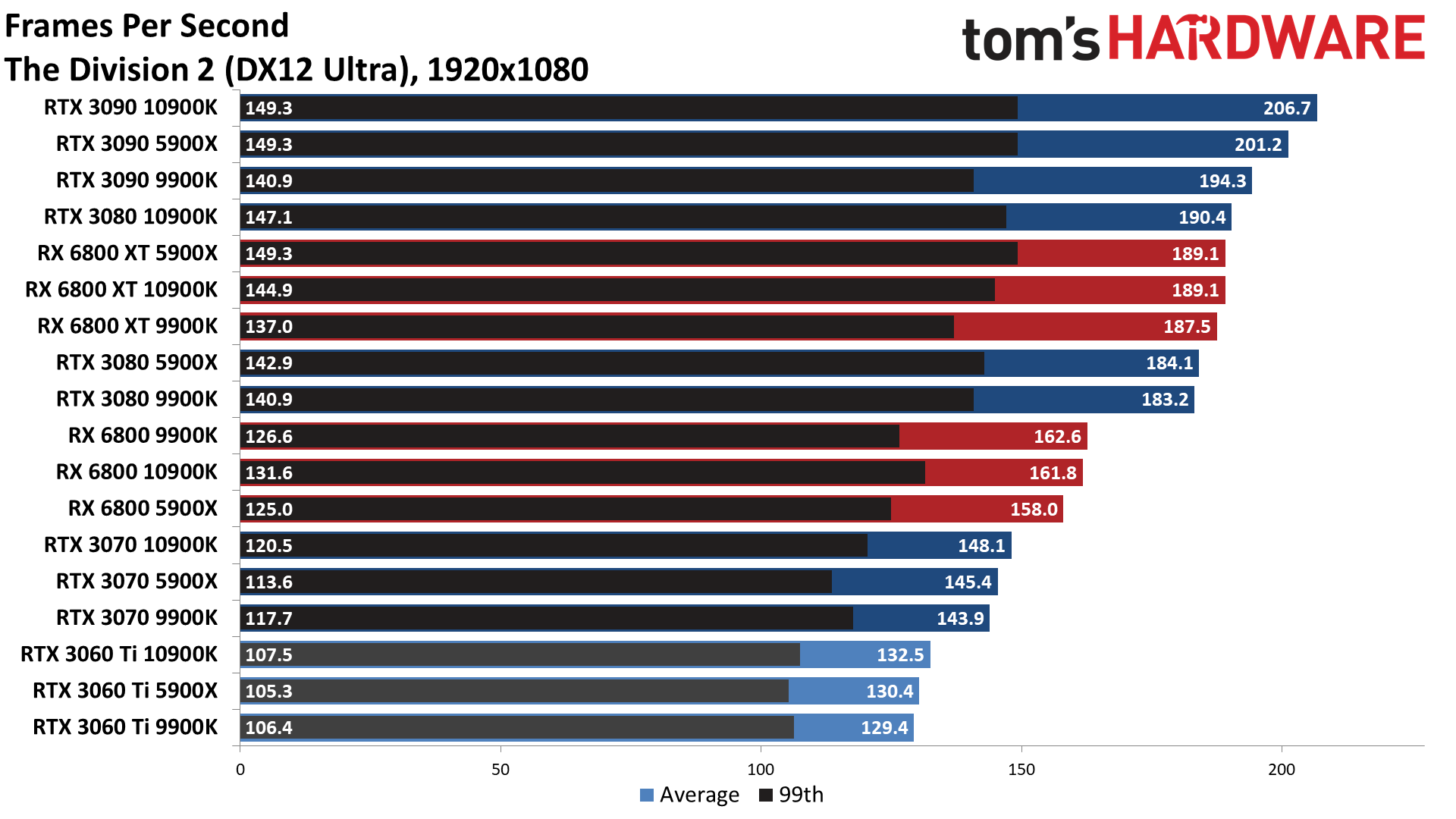
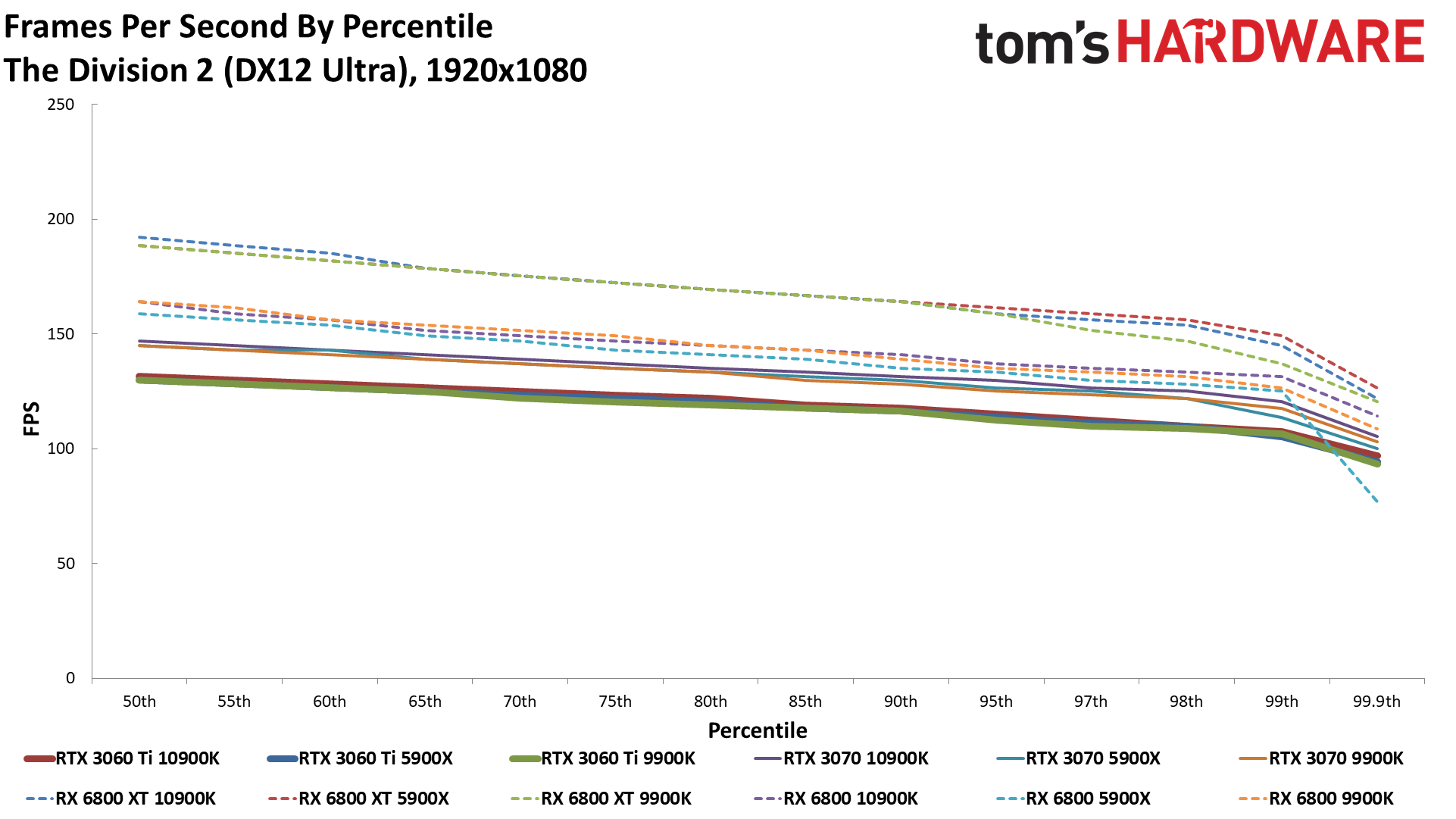
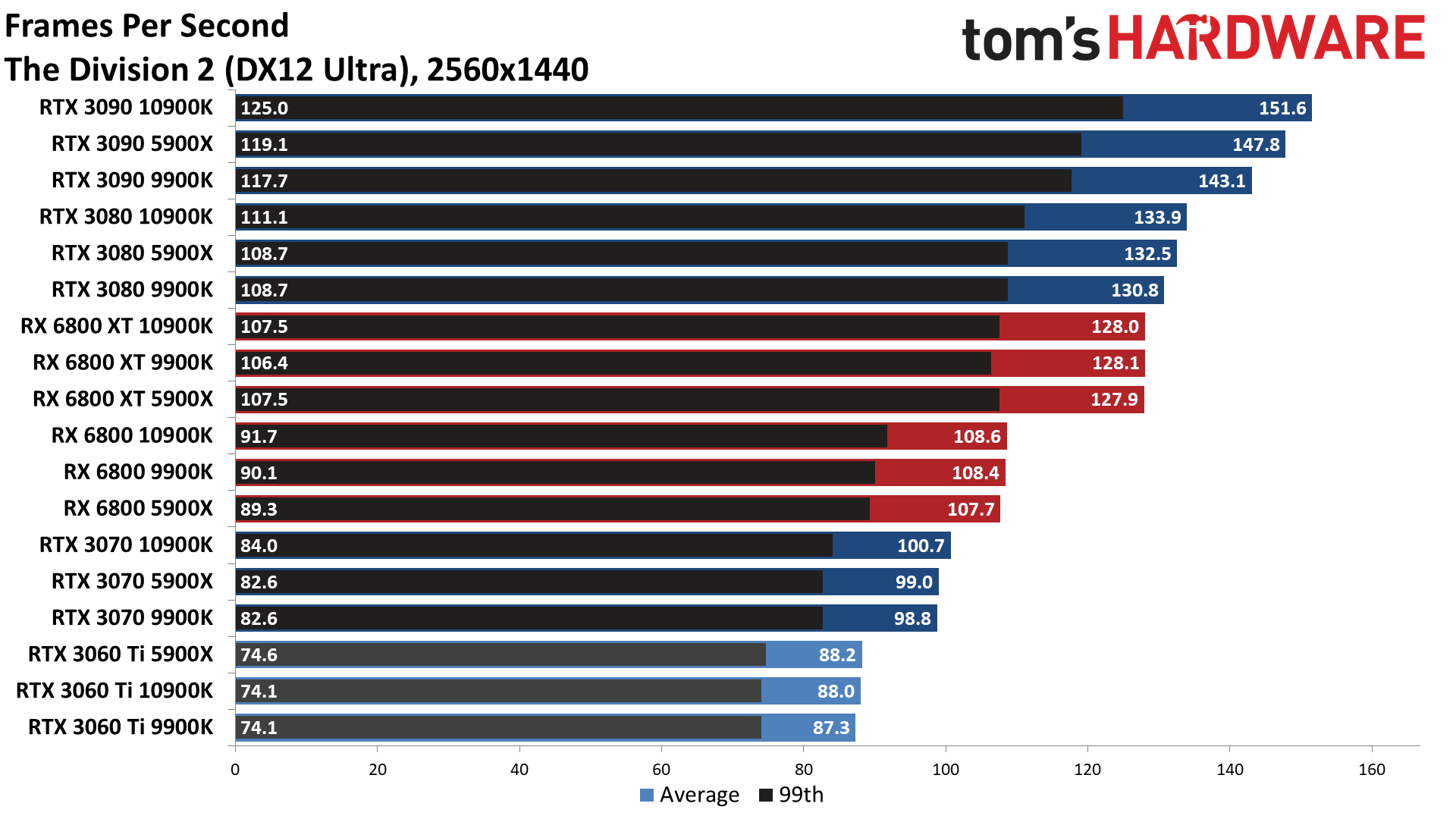
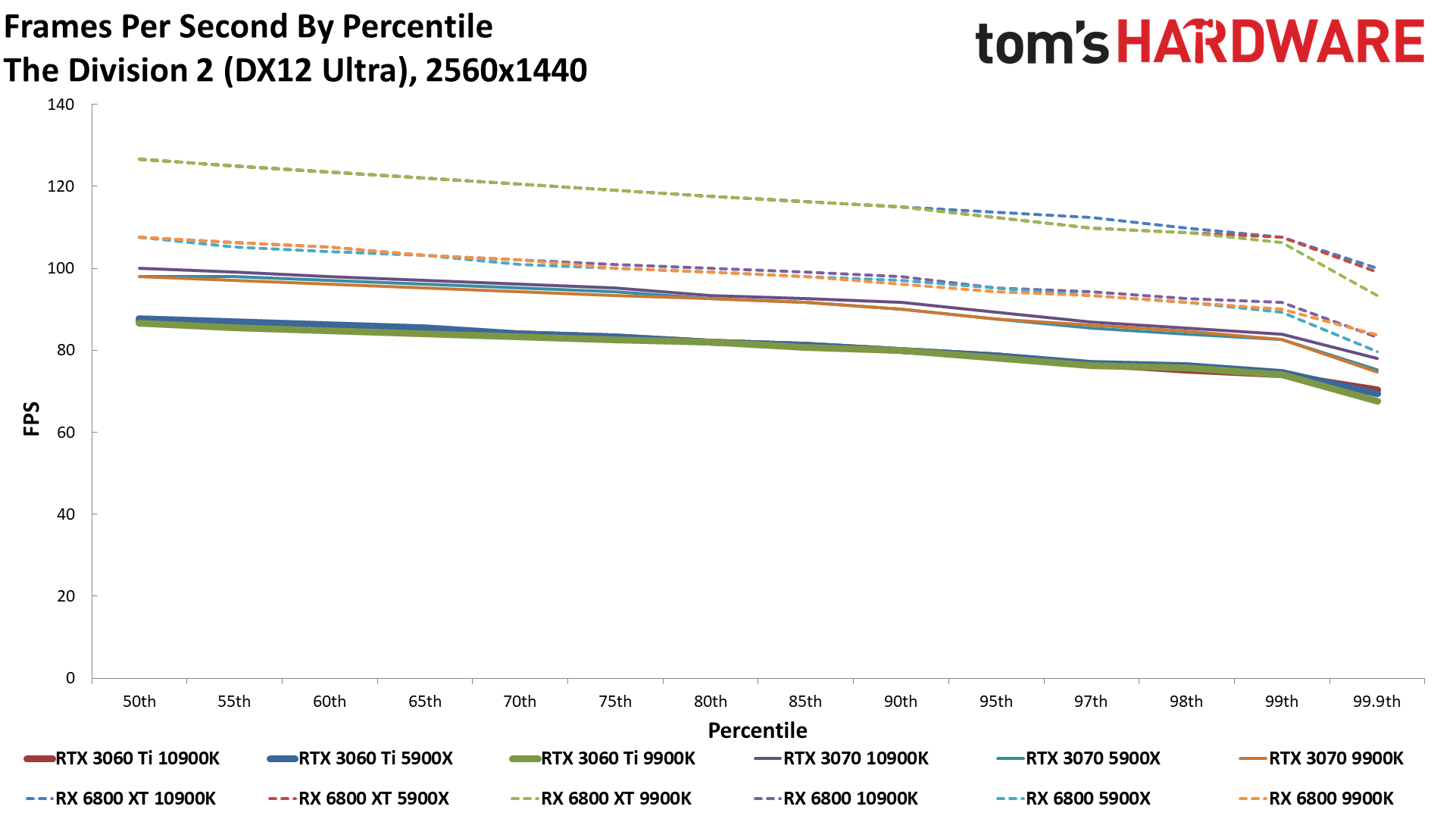
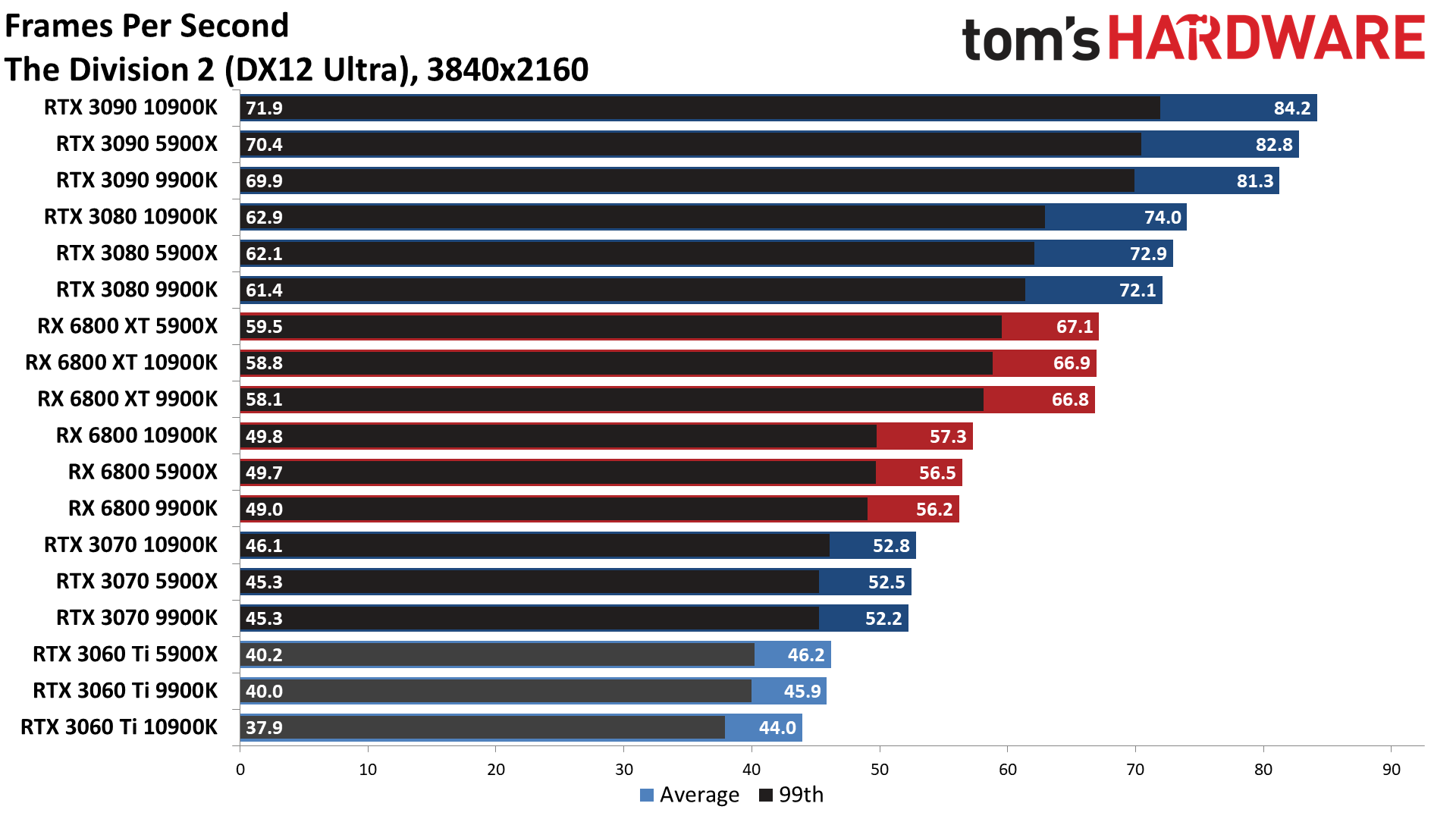
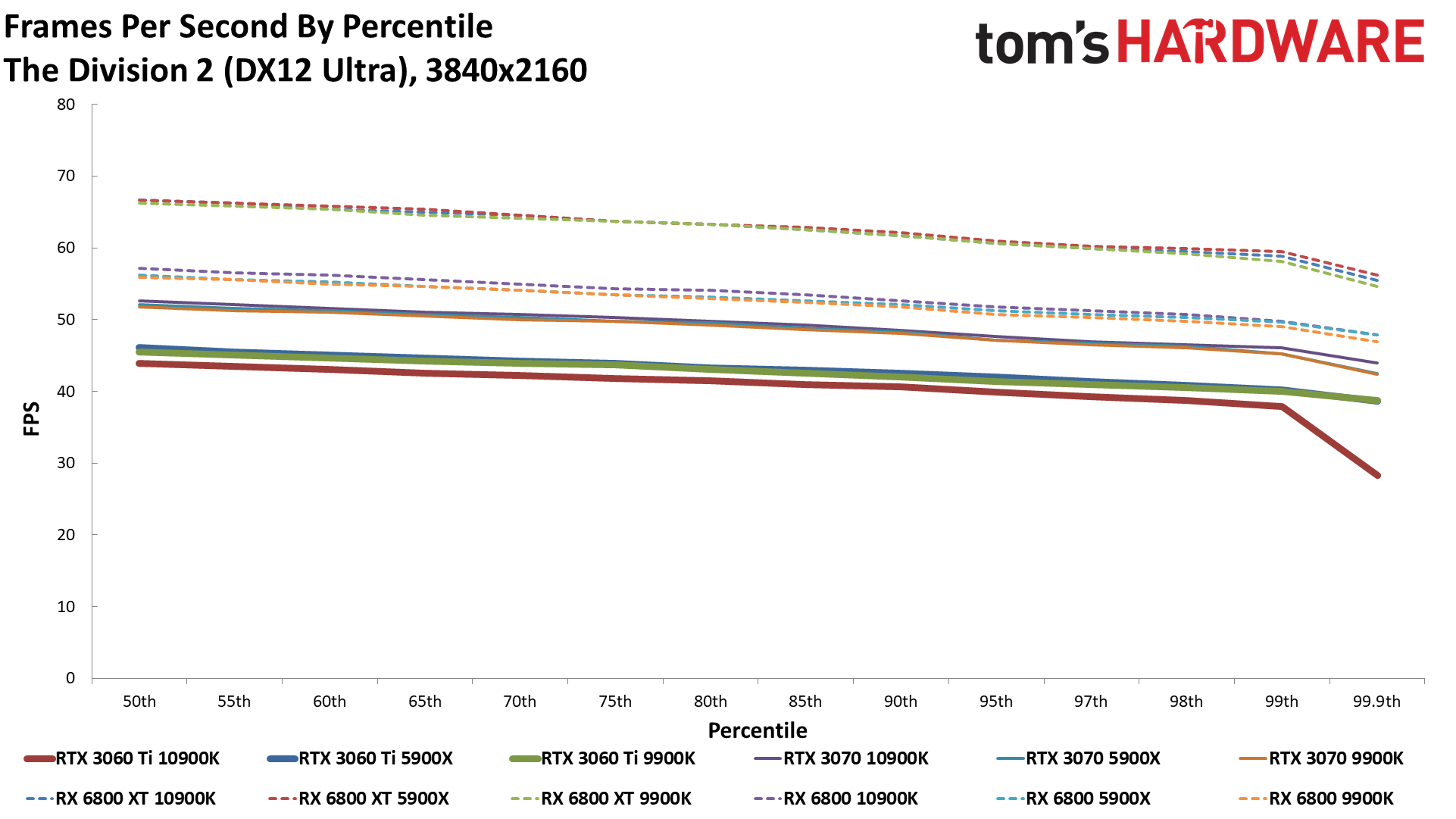
We're on a bit of an AMD promotional roll, and The Division 2 is another game with AMD branding. We test using DX12, and this is an old enough game that both AMD and Nvidia GPUs appear to have received plenty of optimization work. 1080p is a bit more CPU limited this time, and the 5900X comes in ahead of the 9900K, with the 10900K mostly coming in on top, at least for the Nvidia GPUs. For AMD GPUs, there's a bit more variation at 1080p, with the 6800 XT doing best on the 5900X. That's probably just the margin of error in the testing, though.
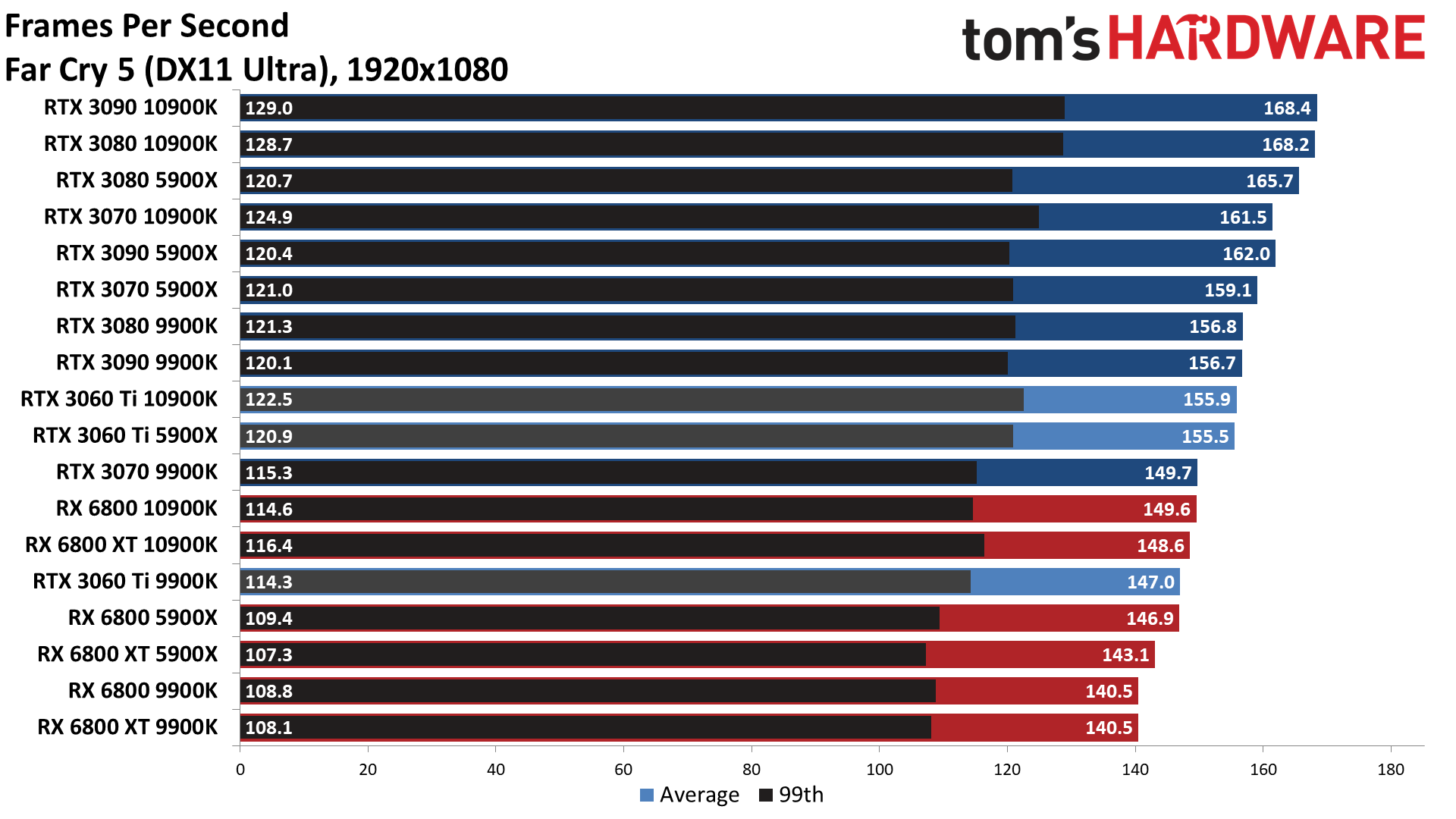
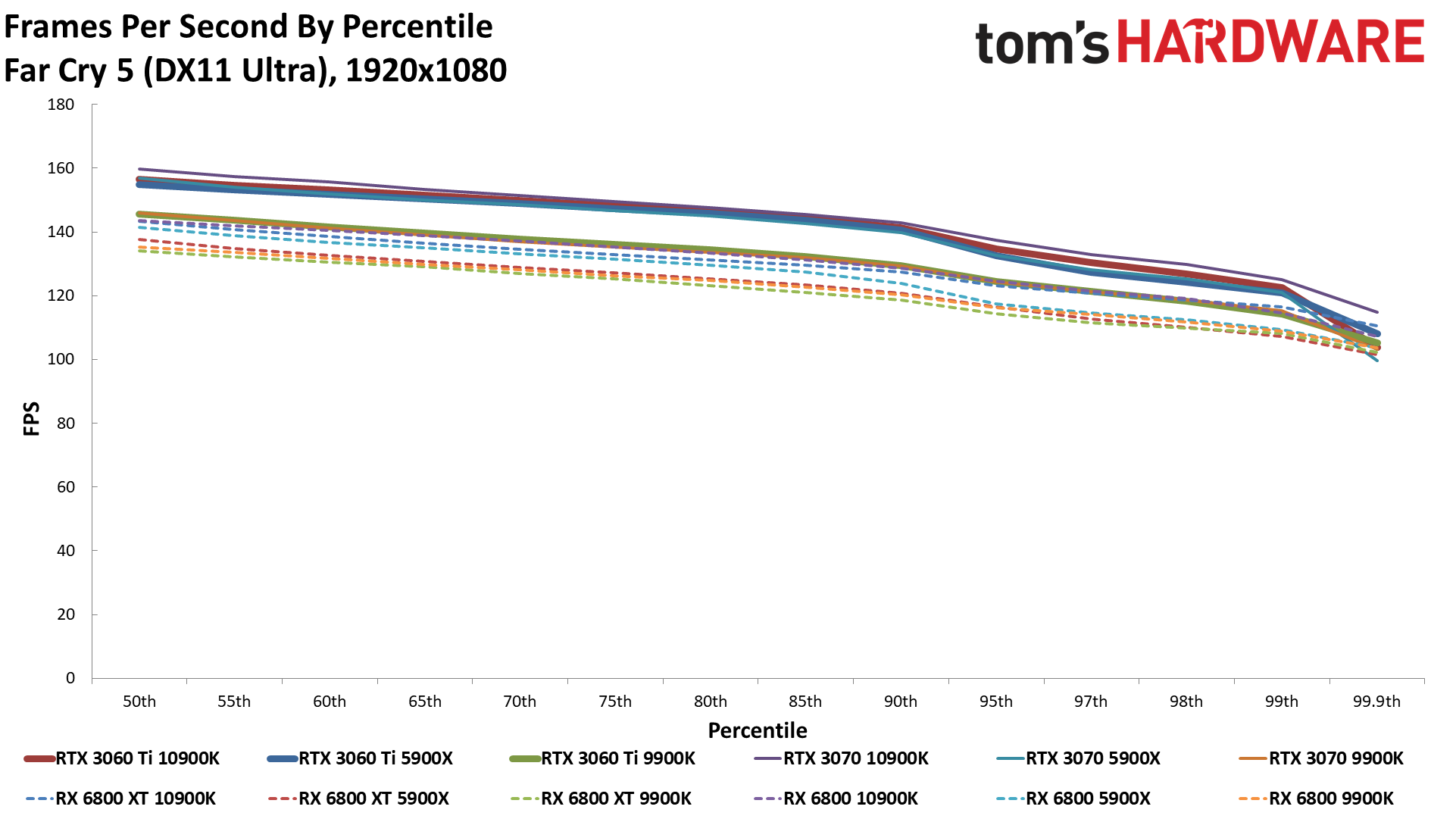
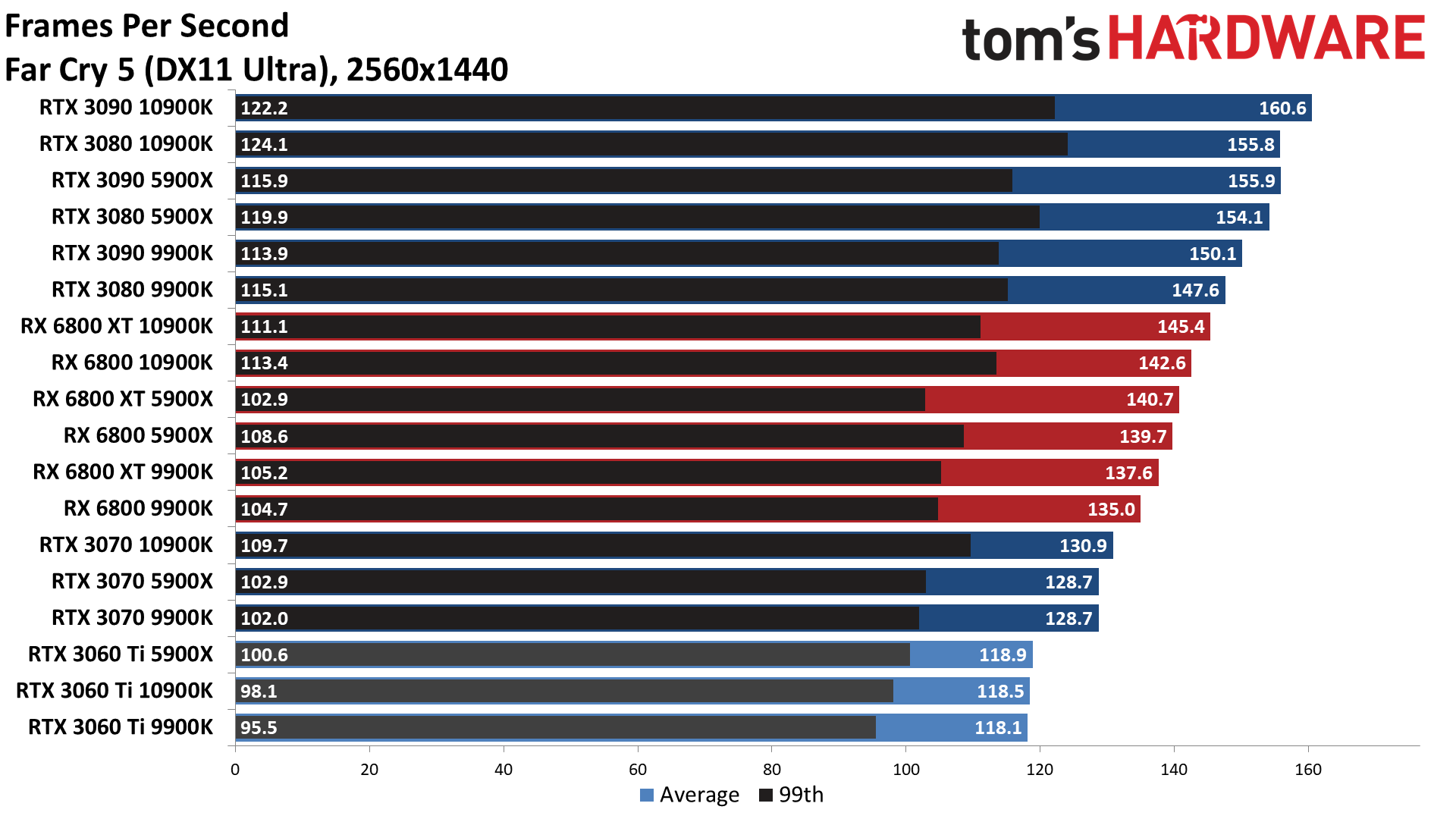
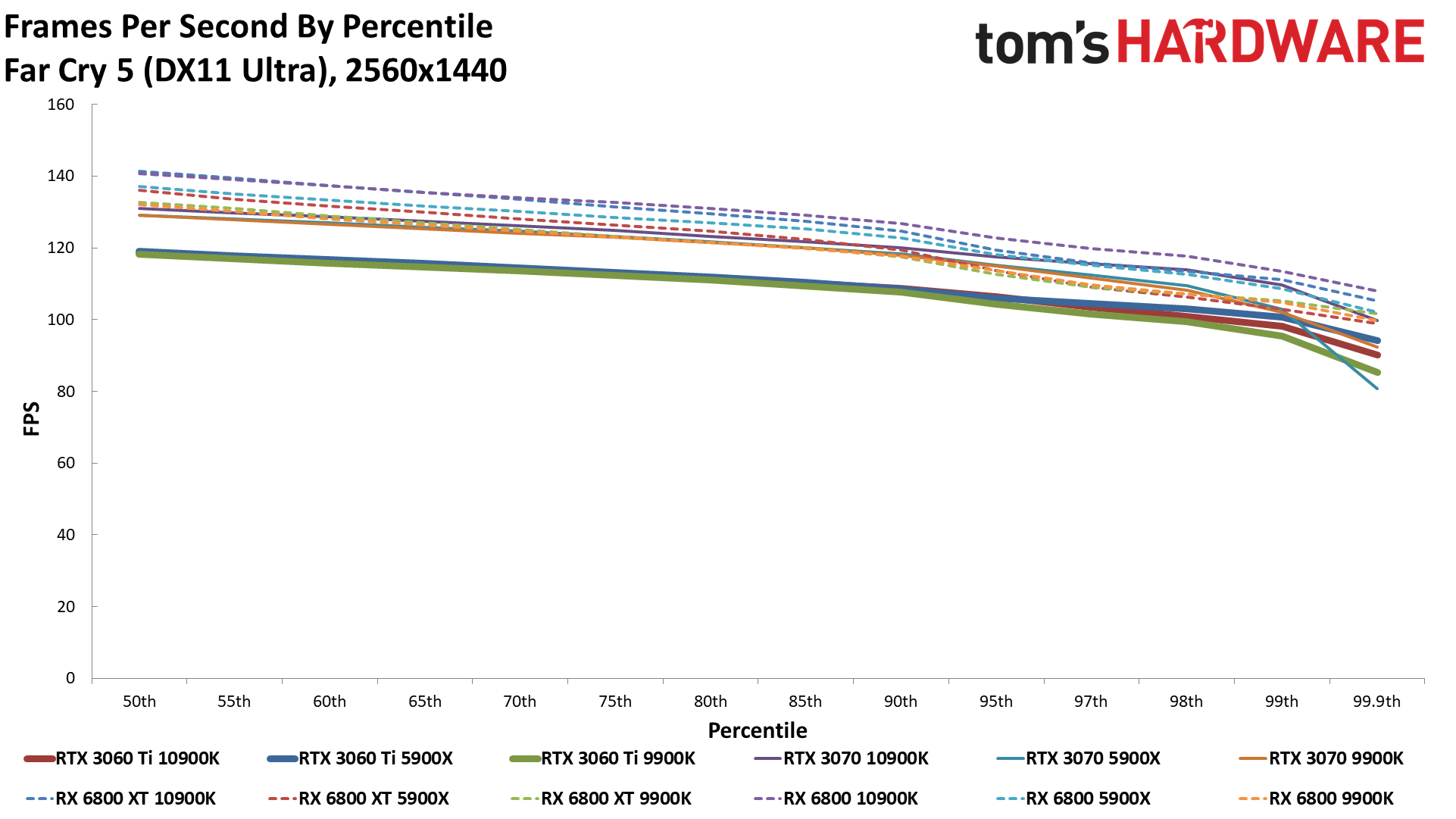
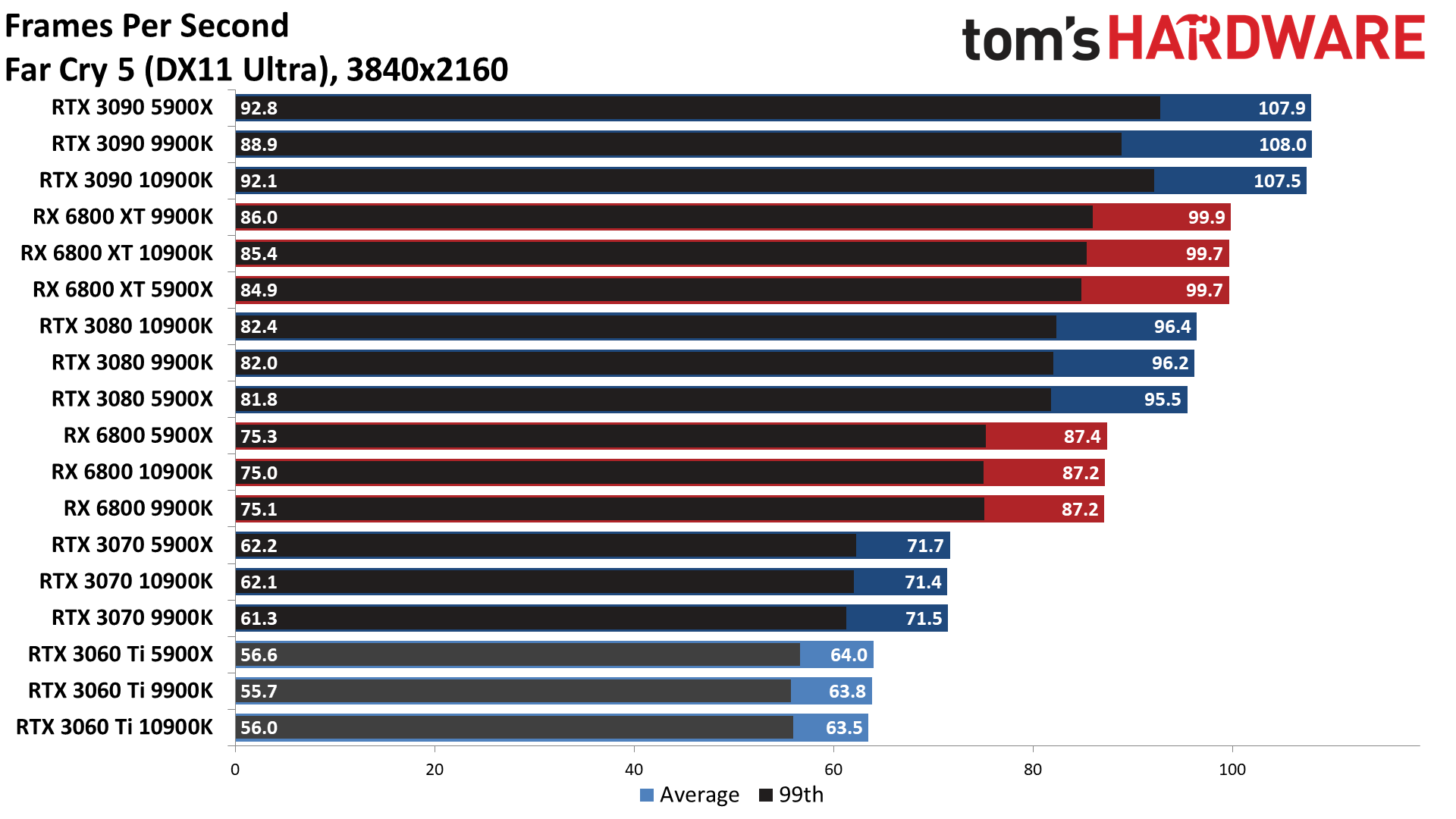
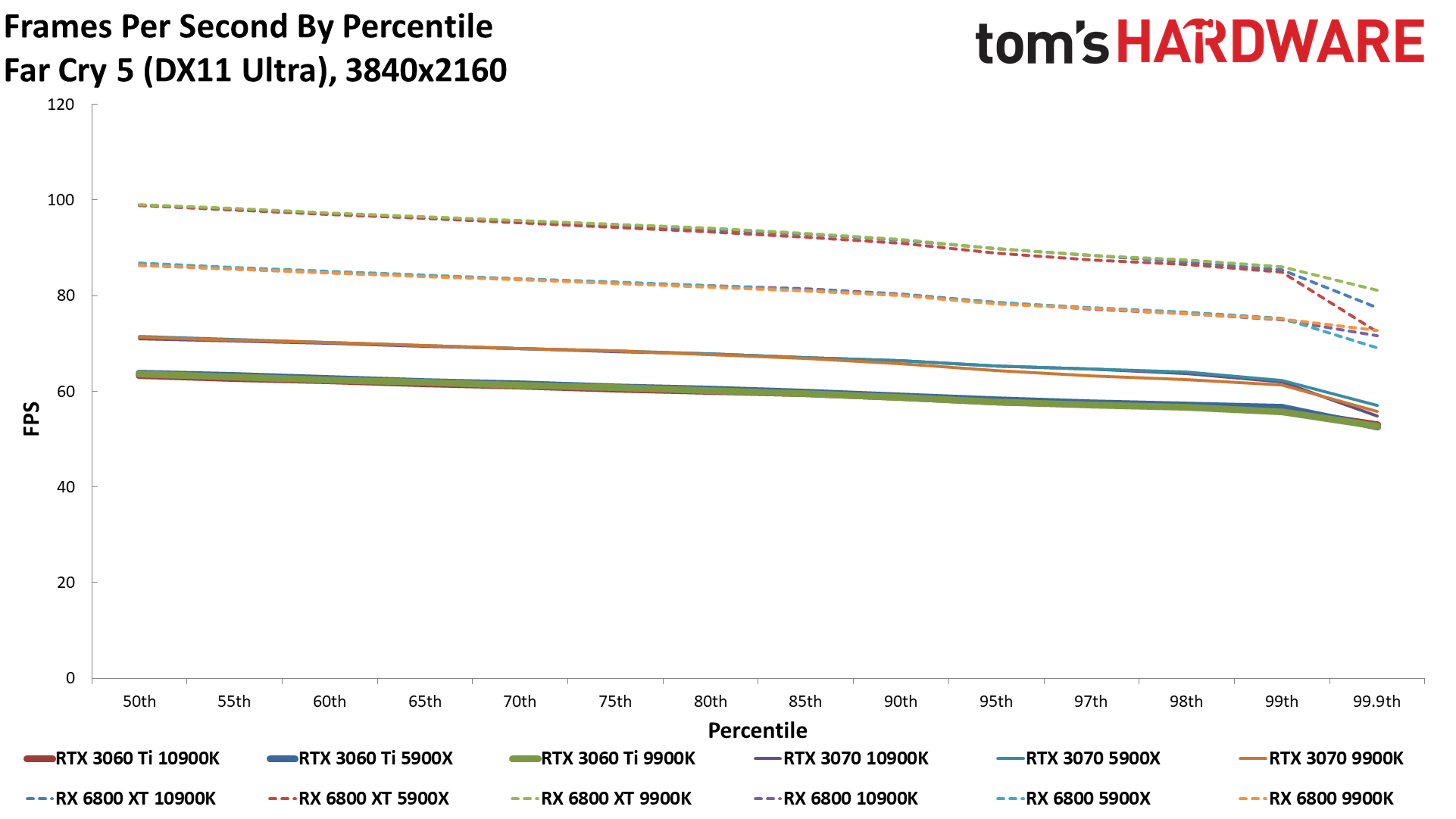
Far Cry 5 is one of the oldest games in our test suite, and while it's yet another AMD promoted game, it's DX11 only, and Nvidia GPUs tend to have a slight advantage. It's also very much CPU limited at 1080p and even 1440p on the faster cards, with only 4K ending up with the expected GPU groupings. AMD's new GPUs also top out at a lower average fps, suggesting there are some driver inefficiencies at play.

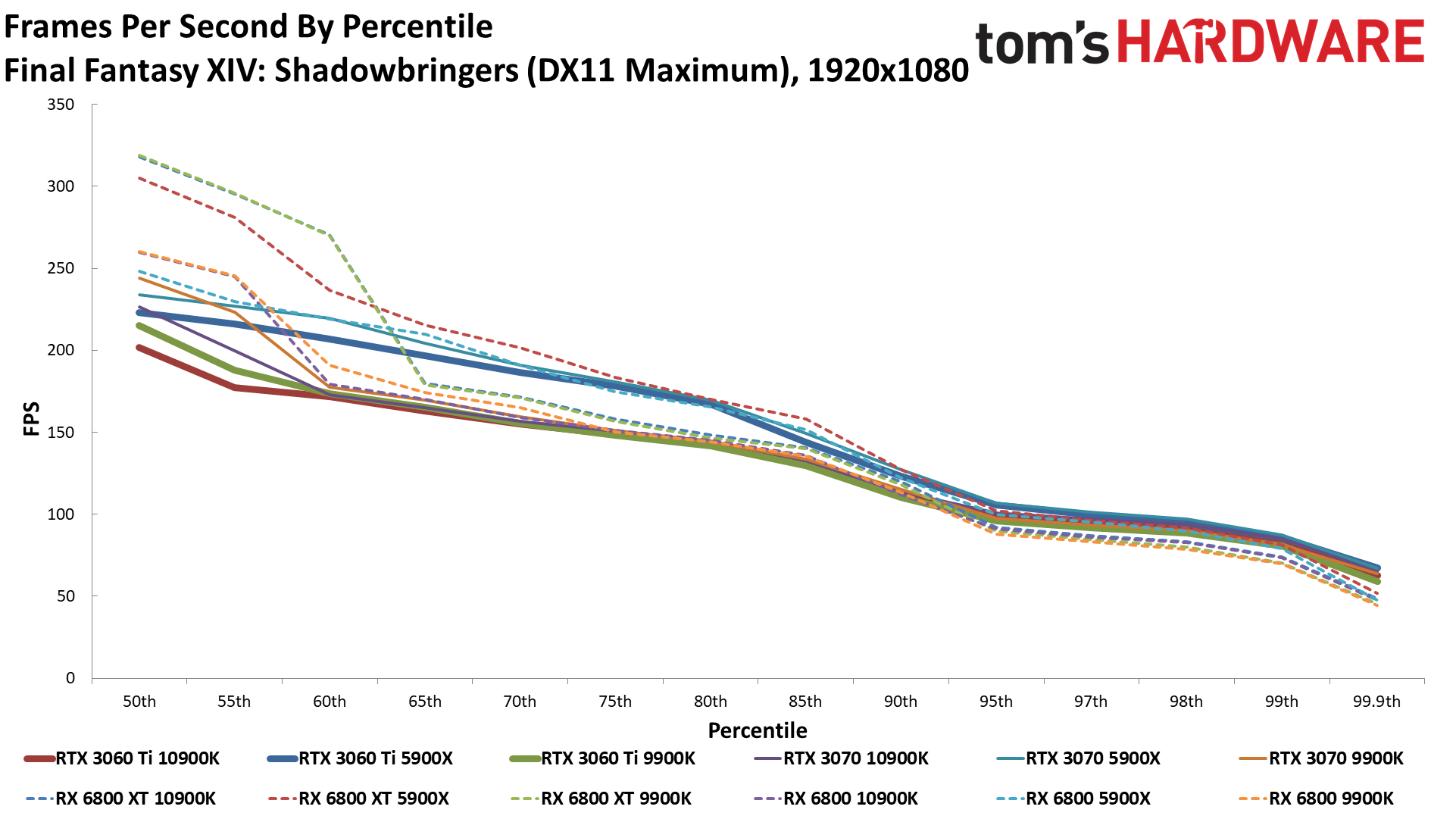
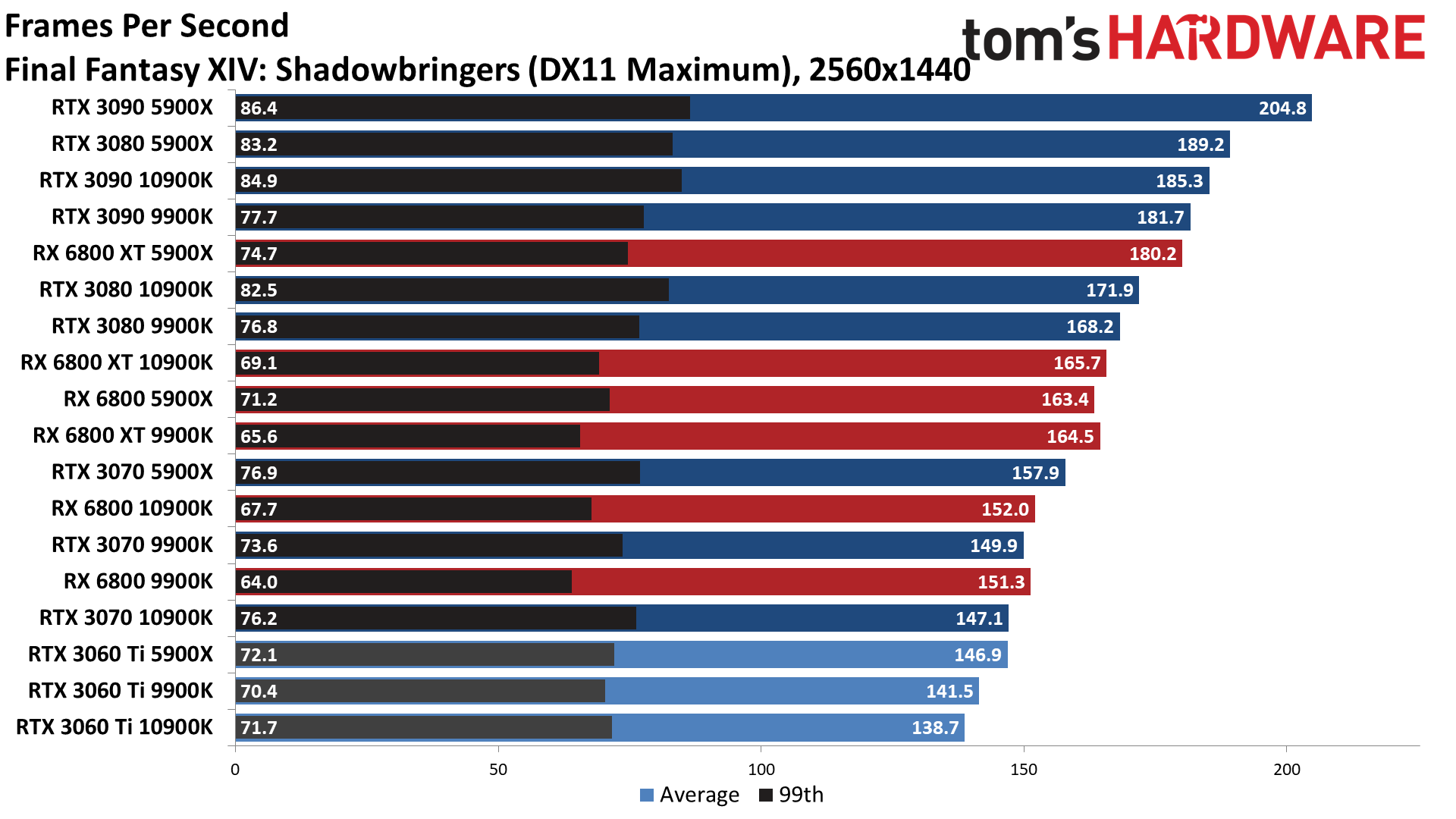
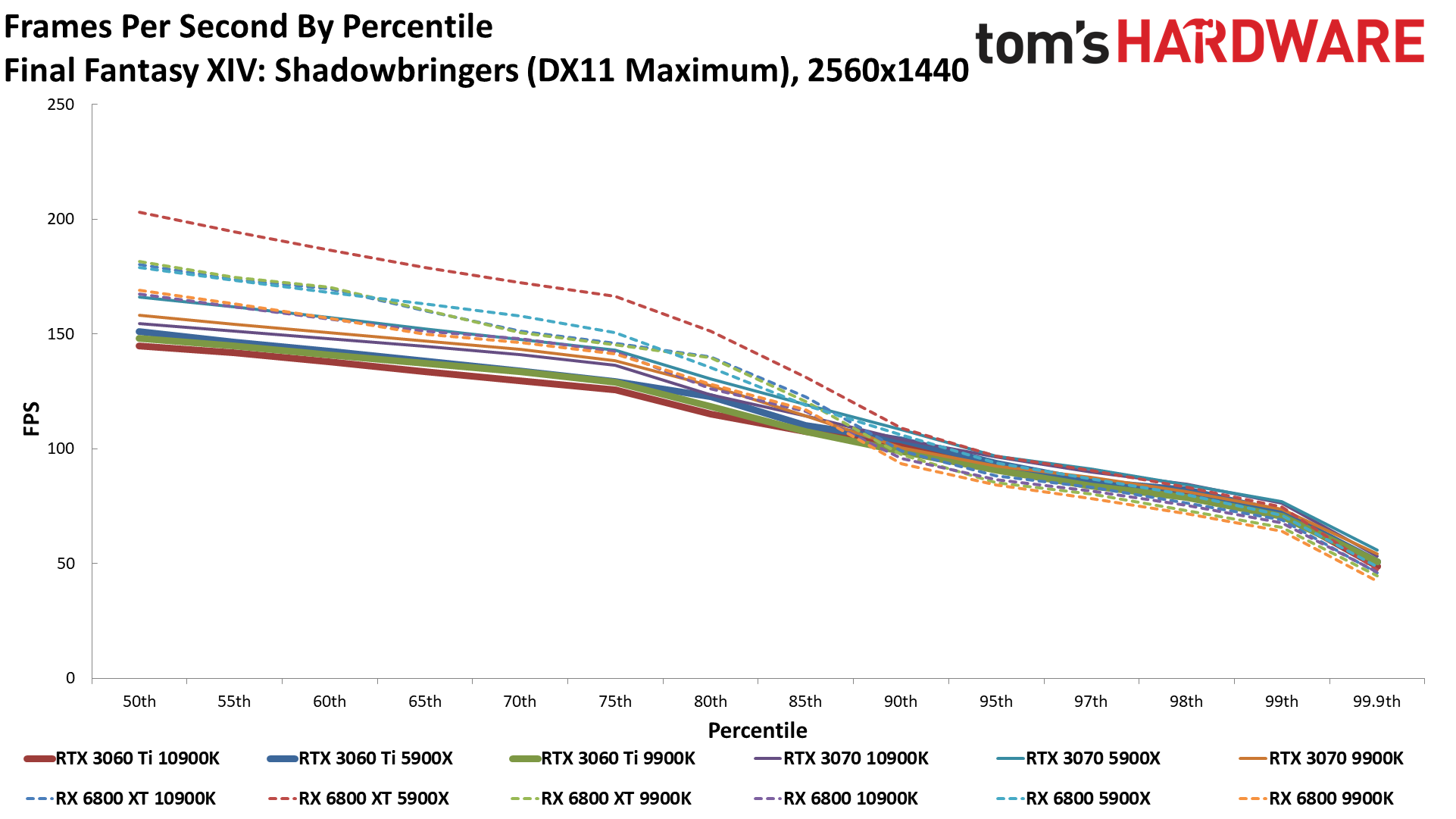
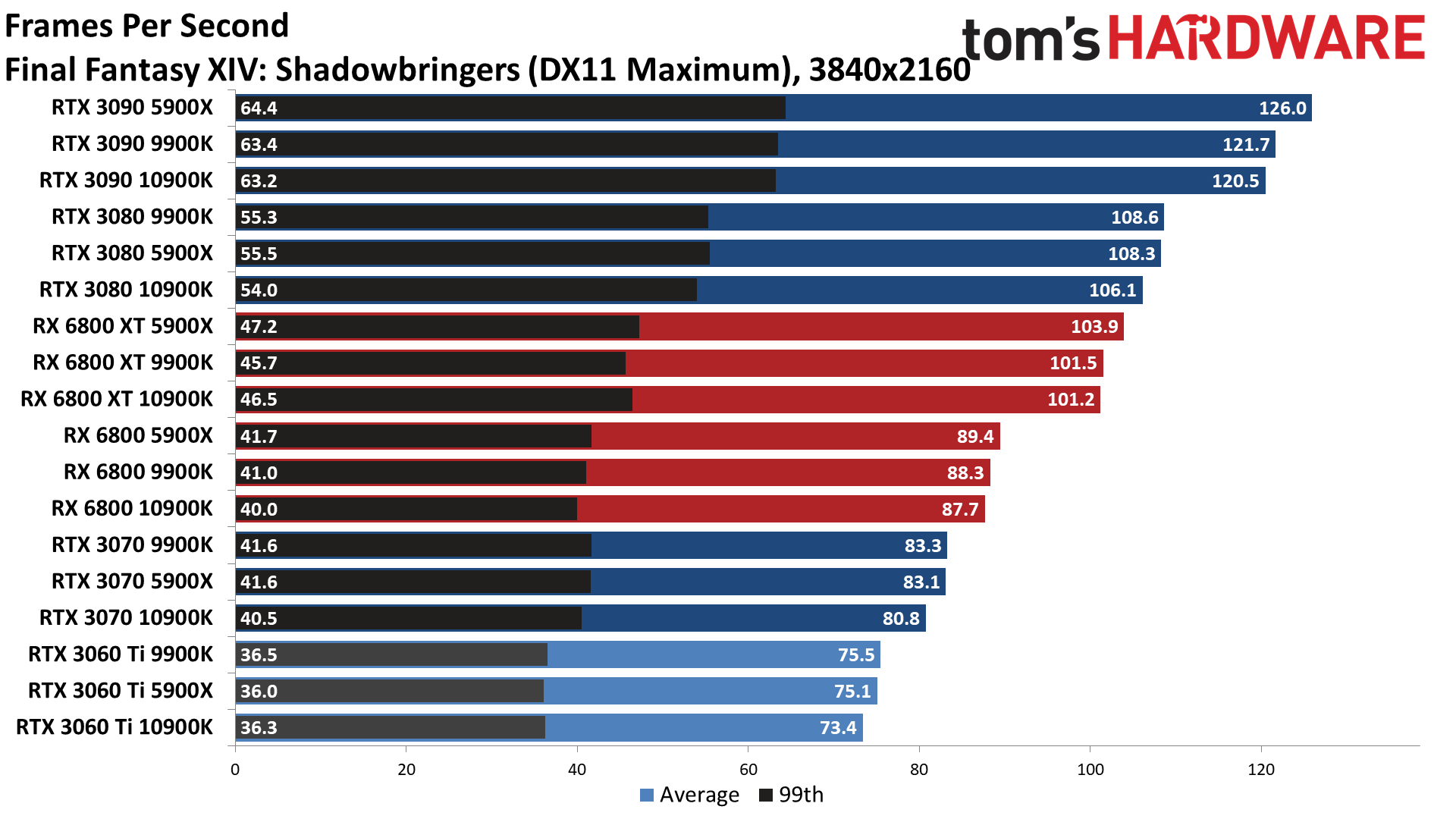
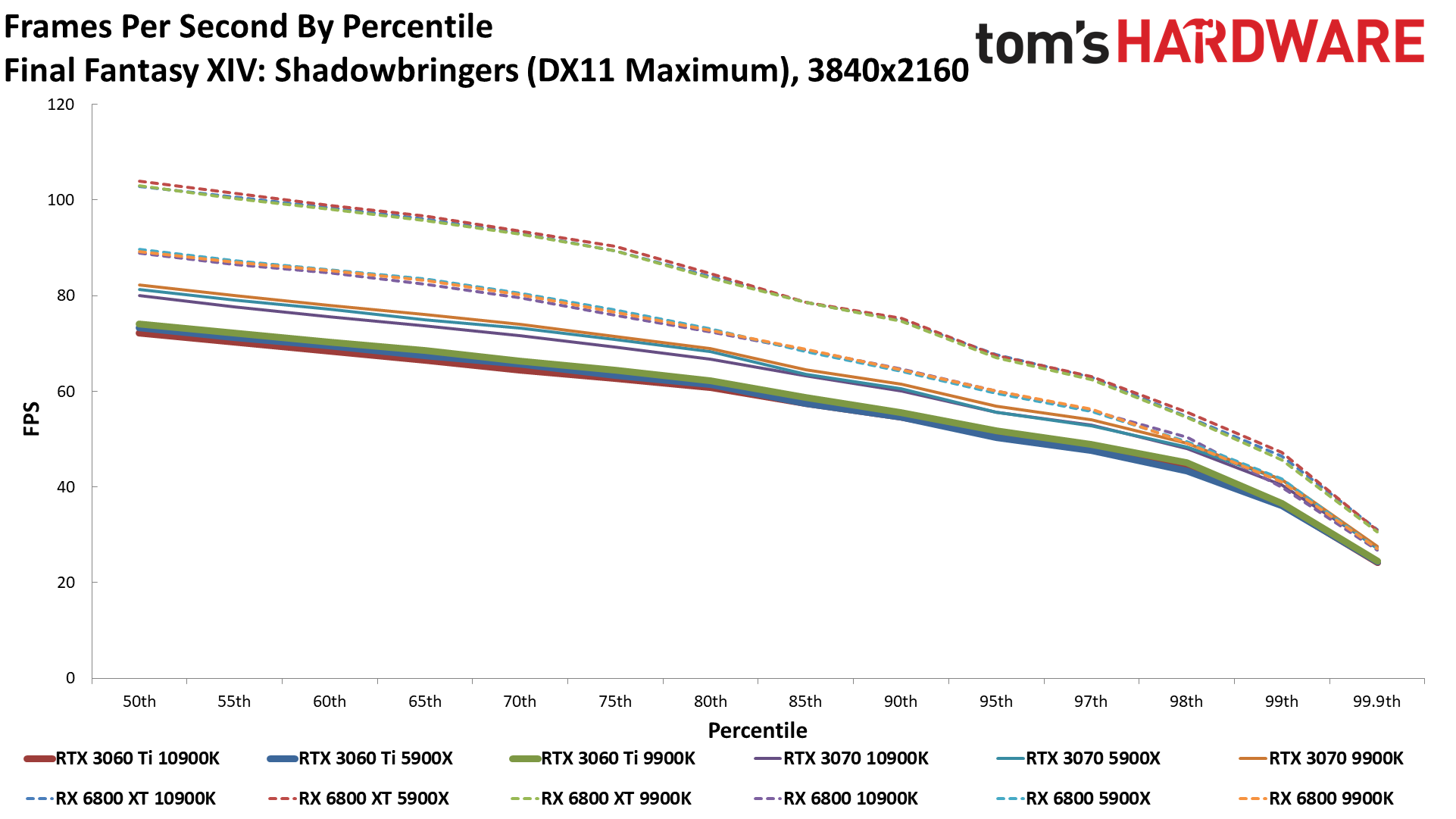
Another relatively old game, Final Fantasy XIV, is our first Nvidia promoted game — or at least, it uses a few of the GameWorks libraries for graphics effects. This time, AMD's 5900X CPU clearly comes out on top for most of the GPUs, particularly at 1080p. Minimum fps is also much lower than in other tests, mostly due to the way the standalone benchmark works (lots of scene changes that can cause fps dips). Anyway, even at maximum detail, the 3060 Ti and every other card easily break 60 fps, making this one of the lighter games in our test suite.
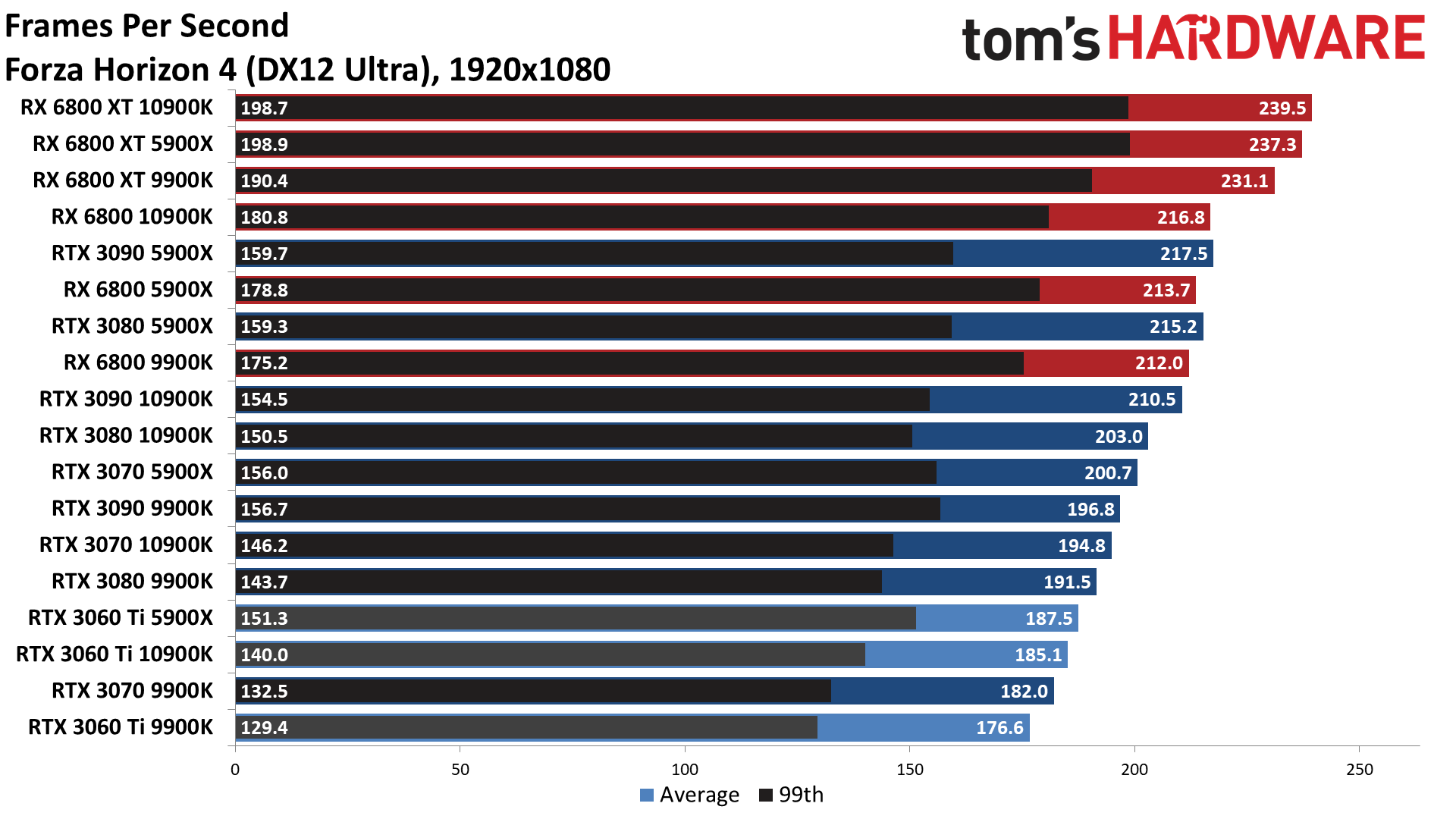
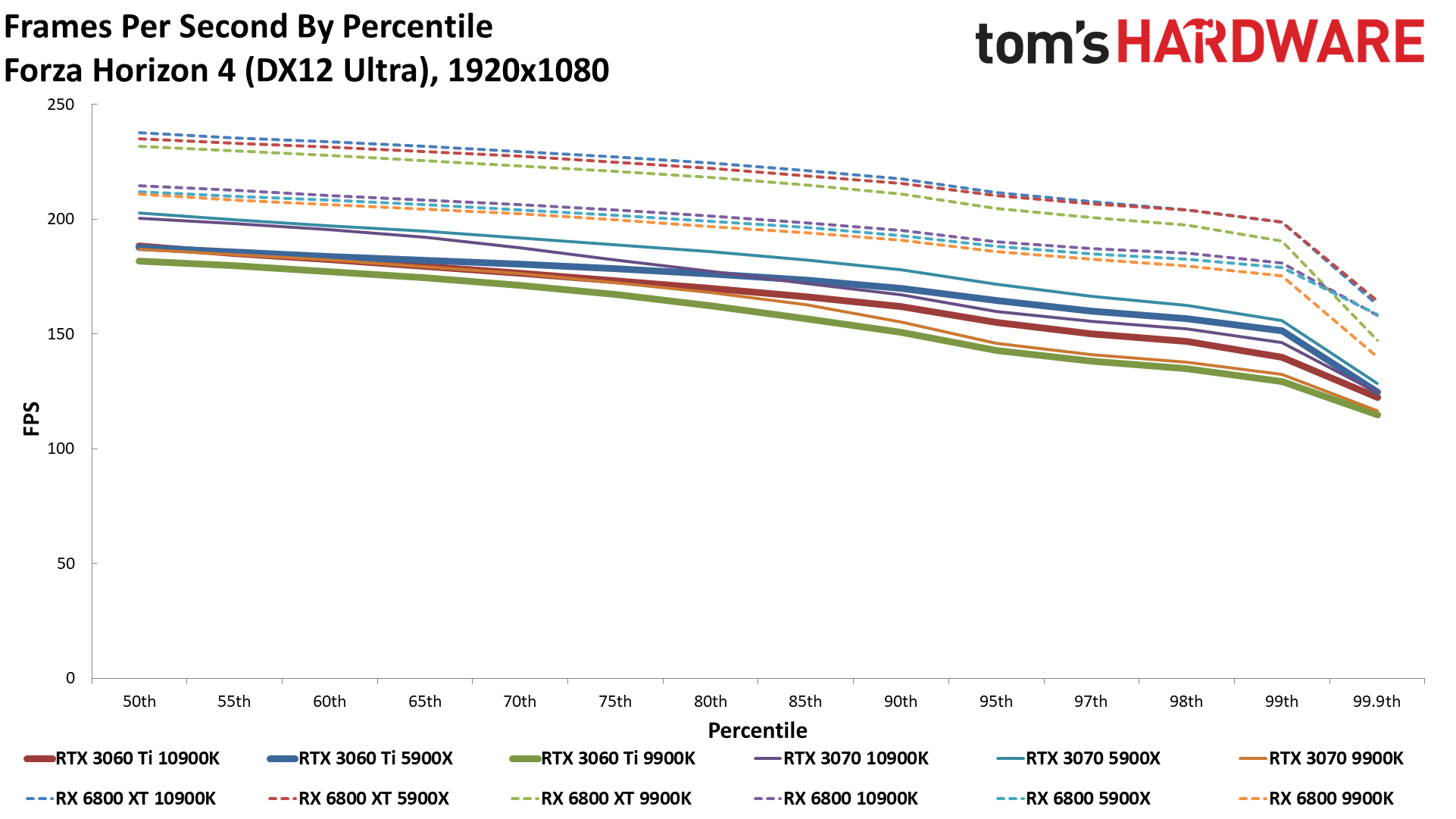
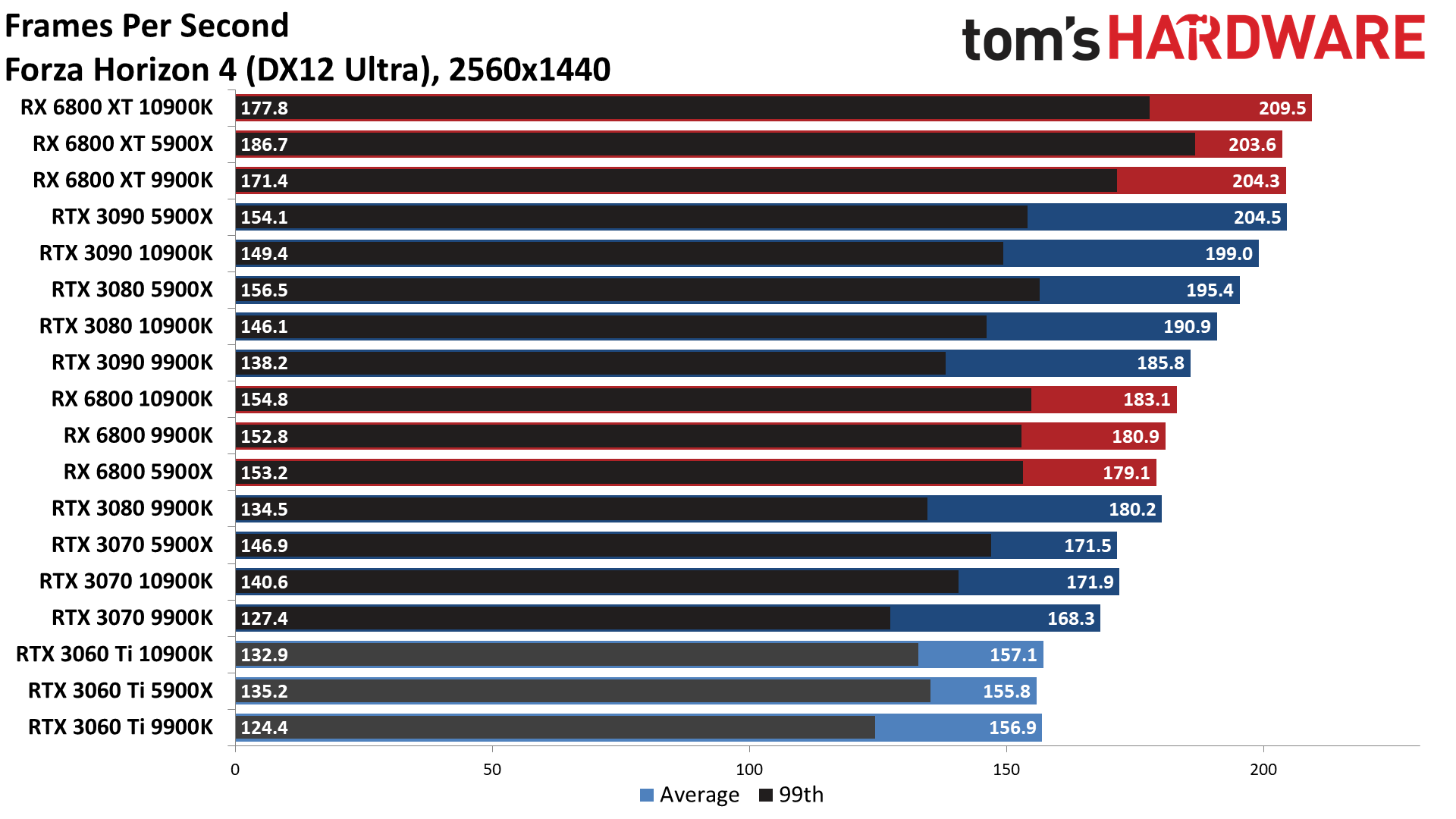
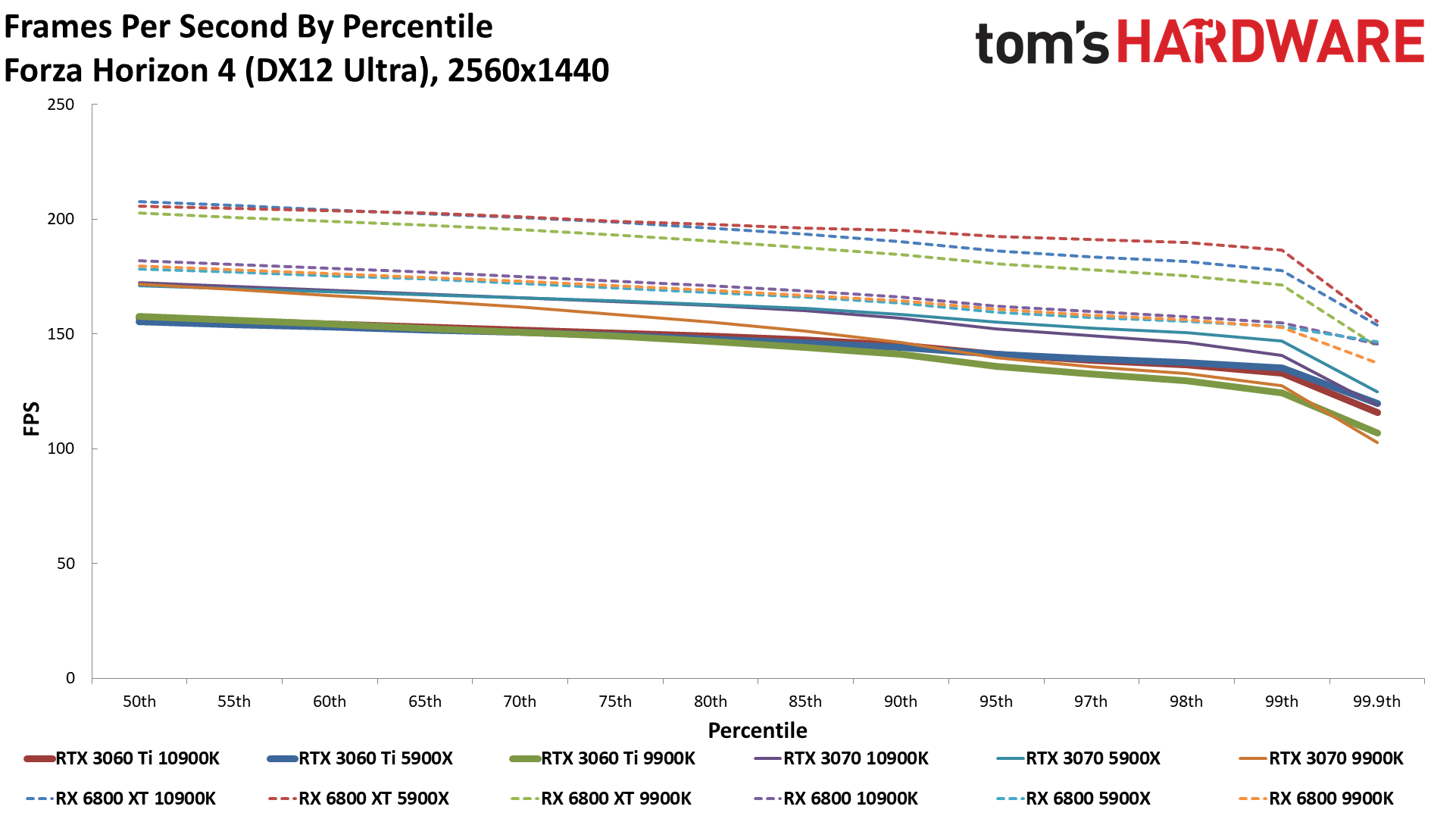
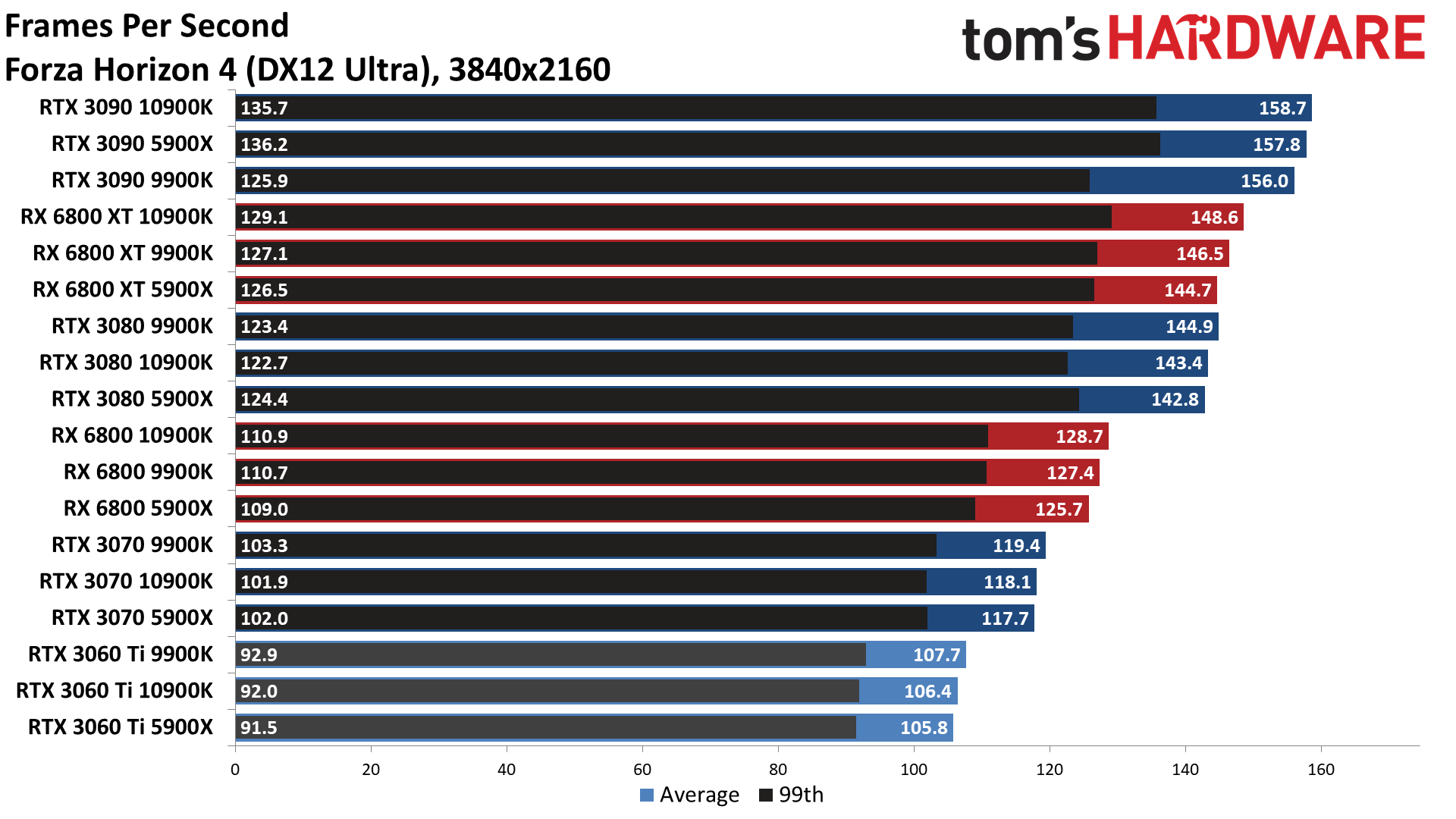
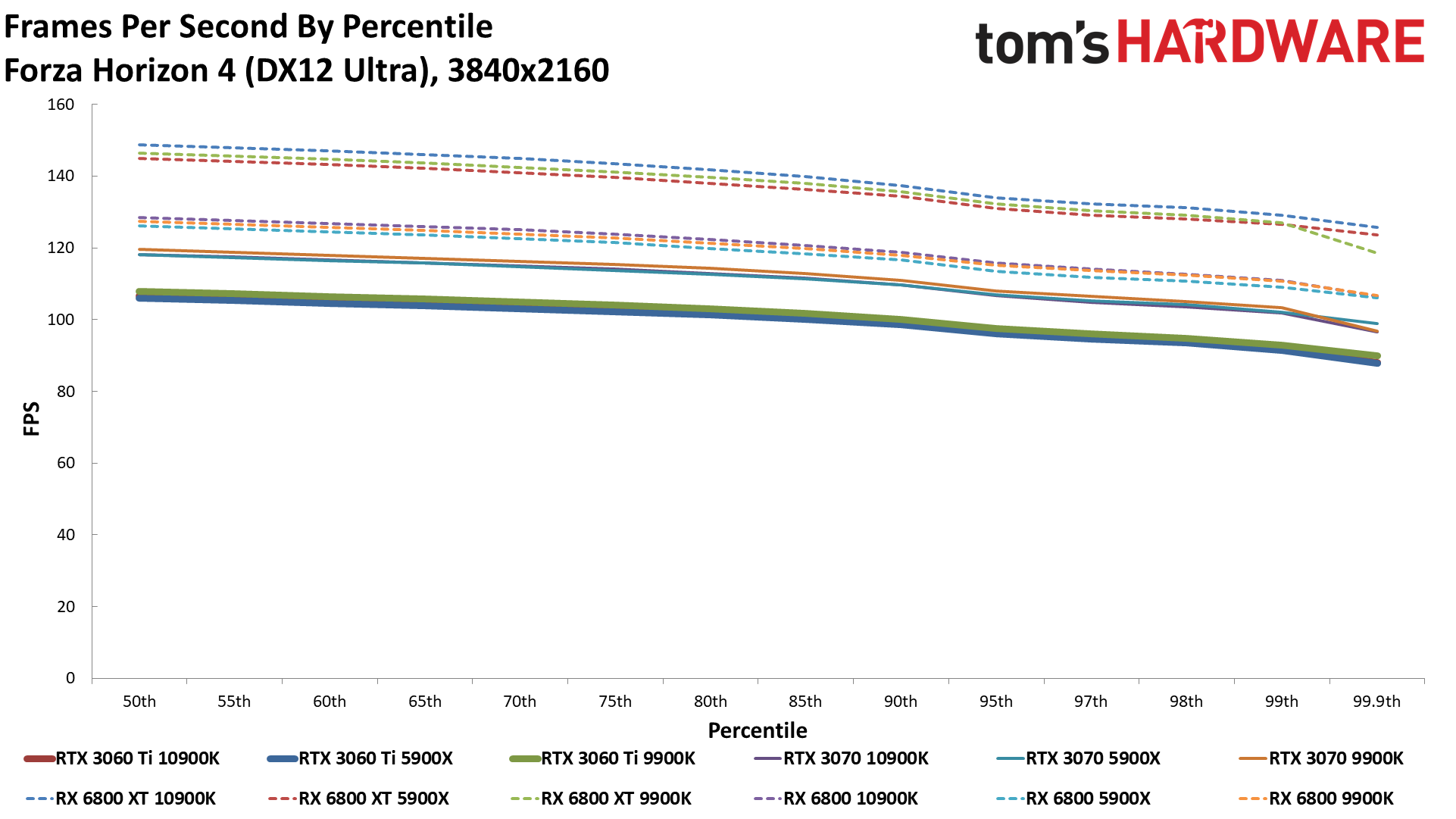
This is technically a GPU-agnostic game that's not specifically promoted by AMD or Nvidia, but Forza Horizon 4 definitely favors AMD GPUs. They have higher maximum fps and better minimum fps as well, potentially thanks to the DX12 code. The game also tends to be pretty CPU-limited on the higher GPUs at 1080p and 1440p, with the 5900X and 10900K outperforming the 9900K.
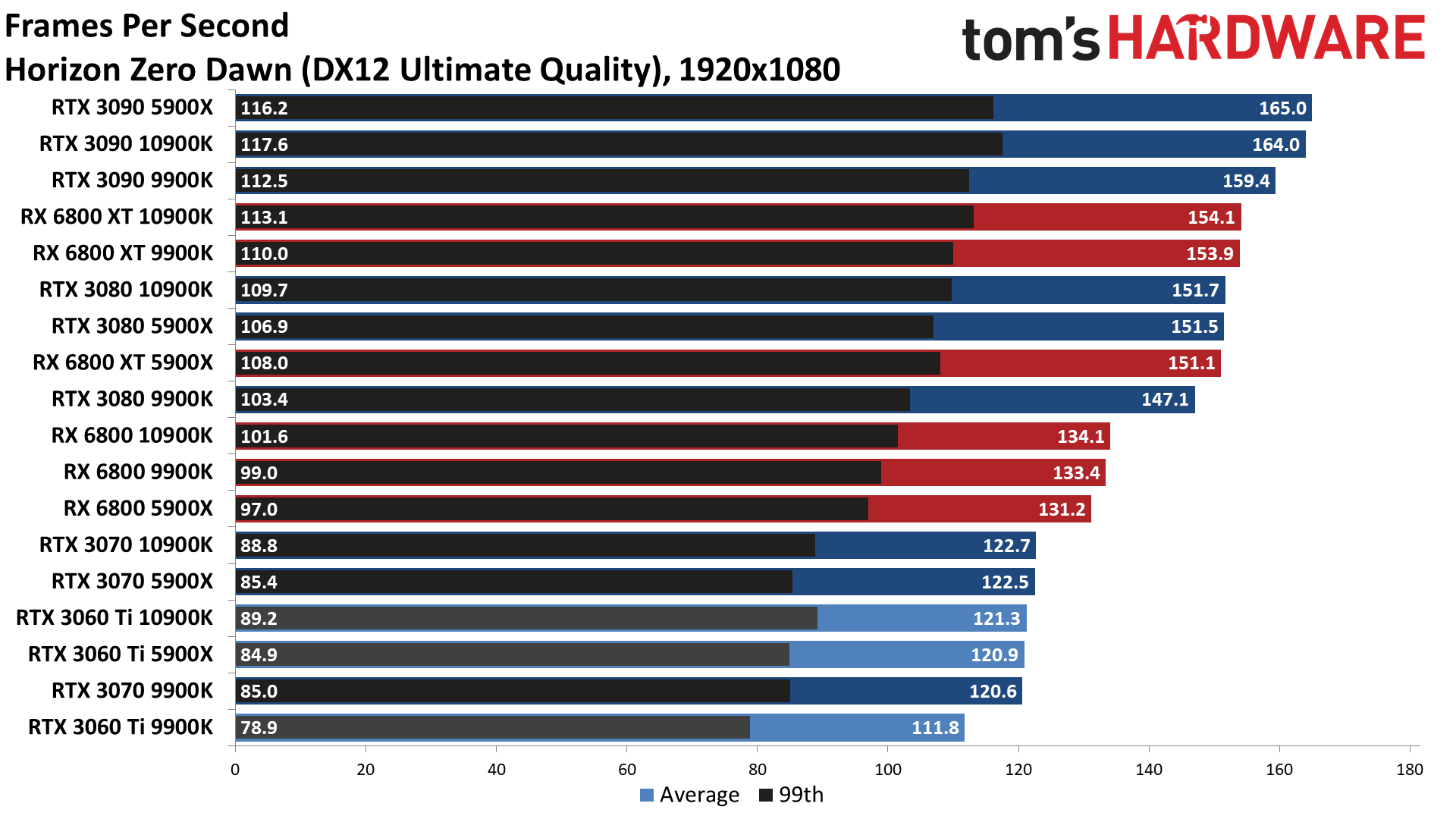
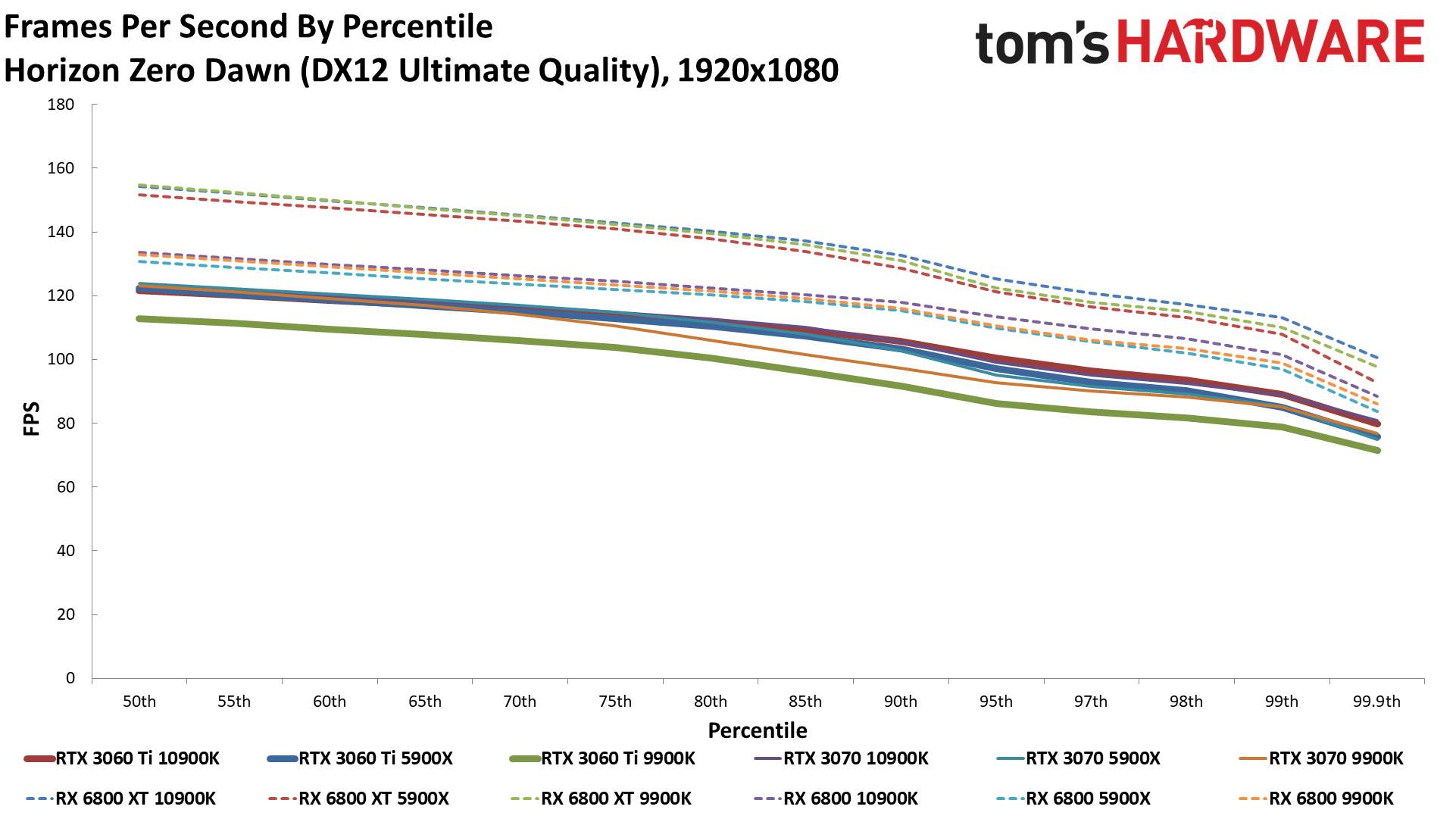
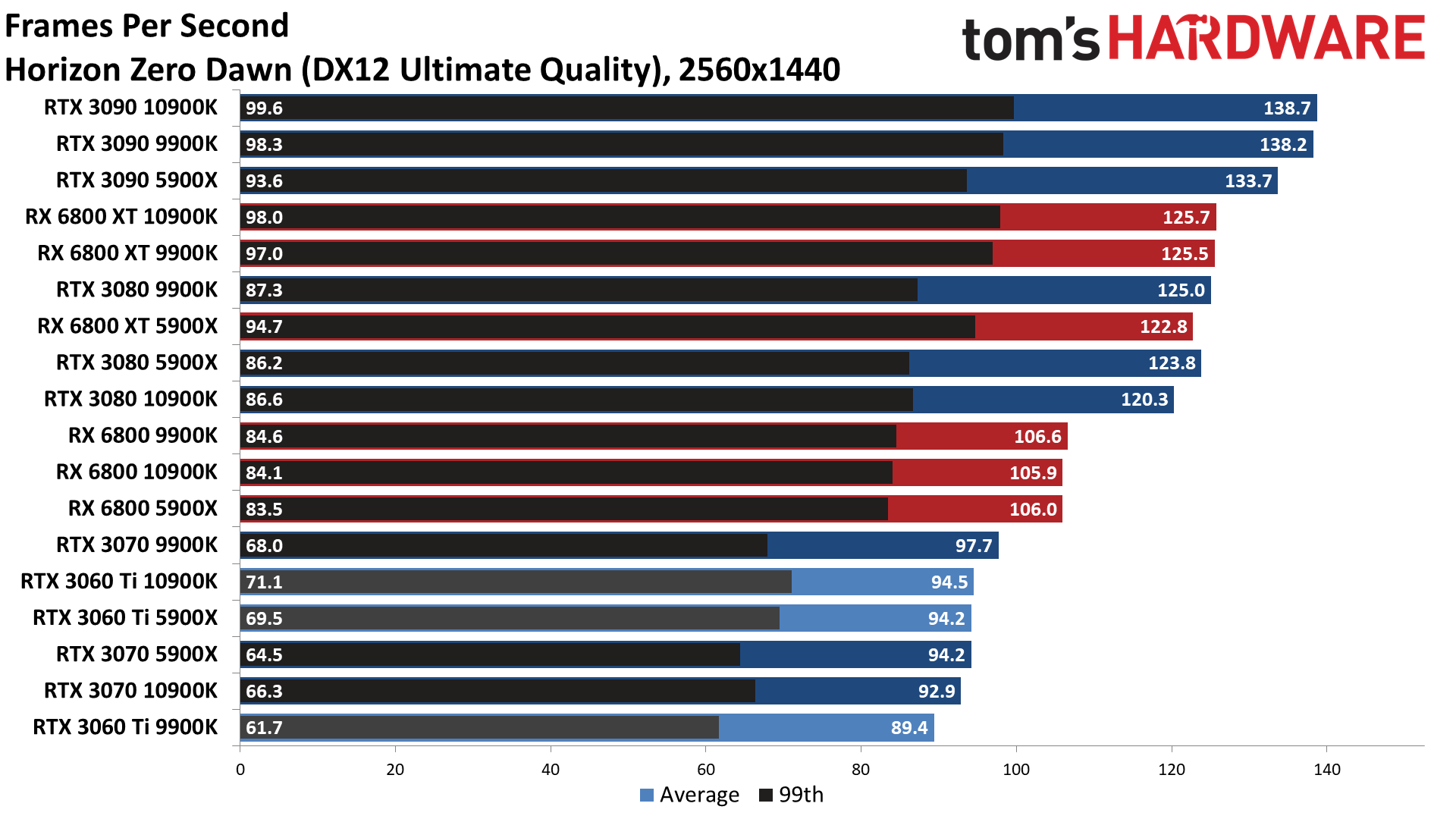
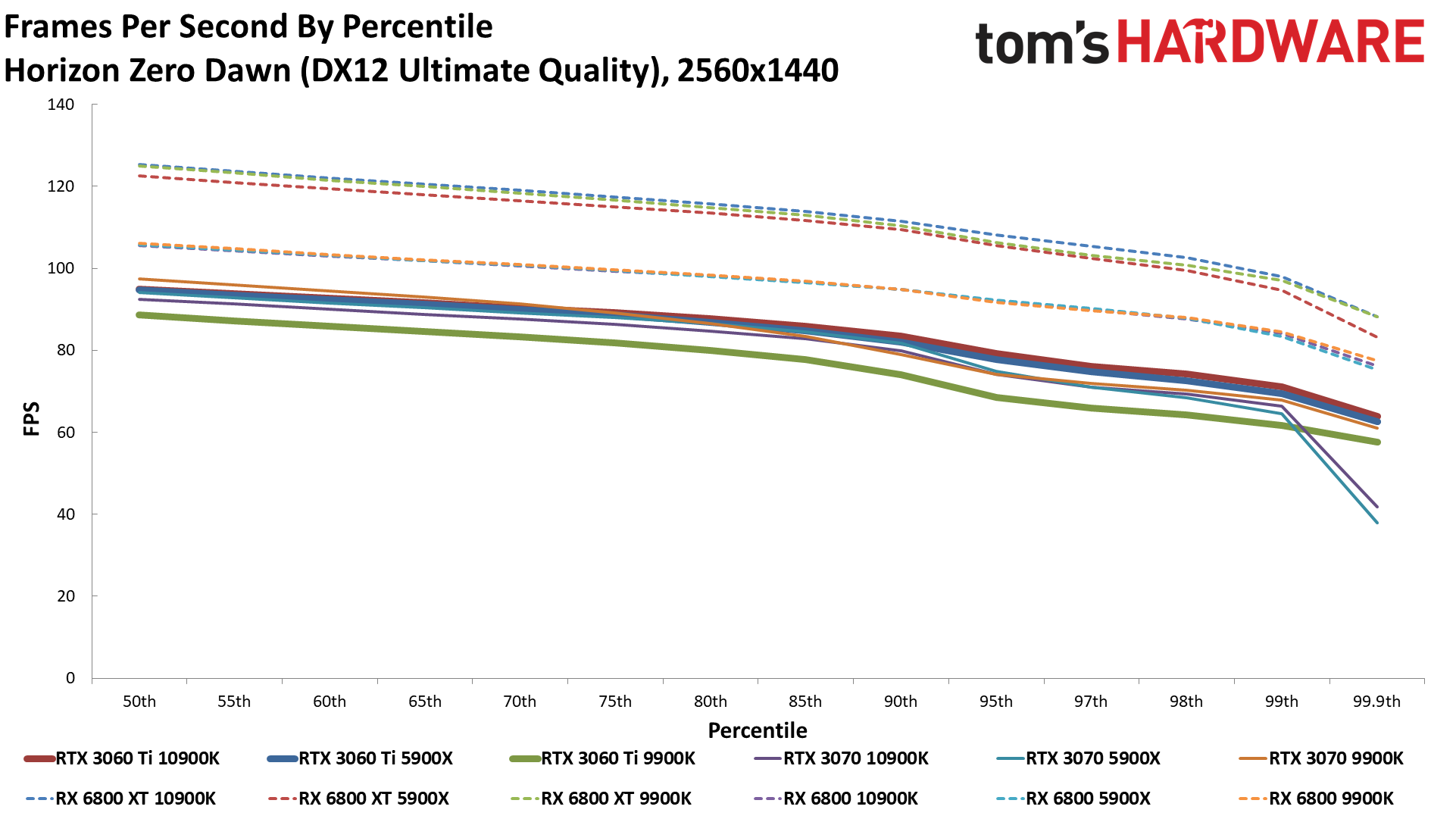
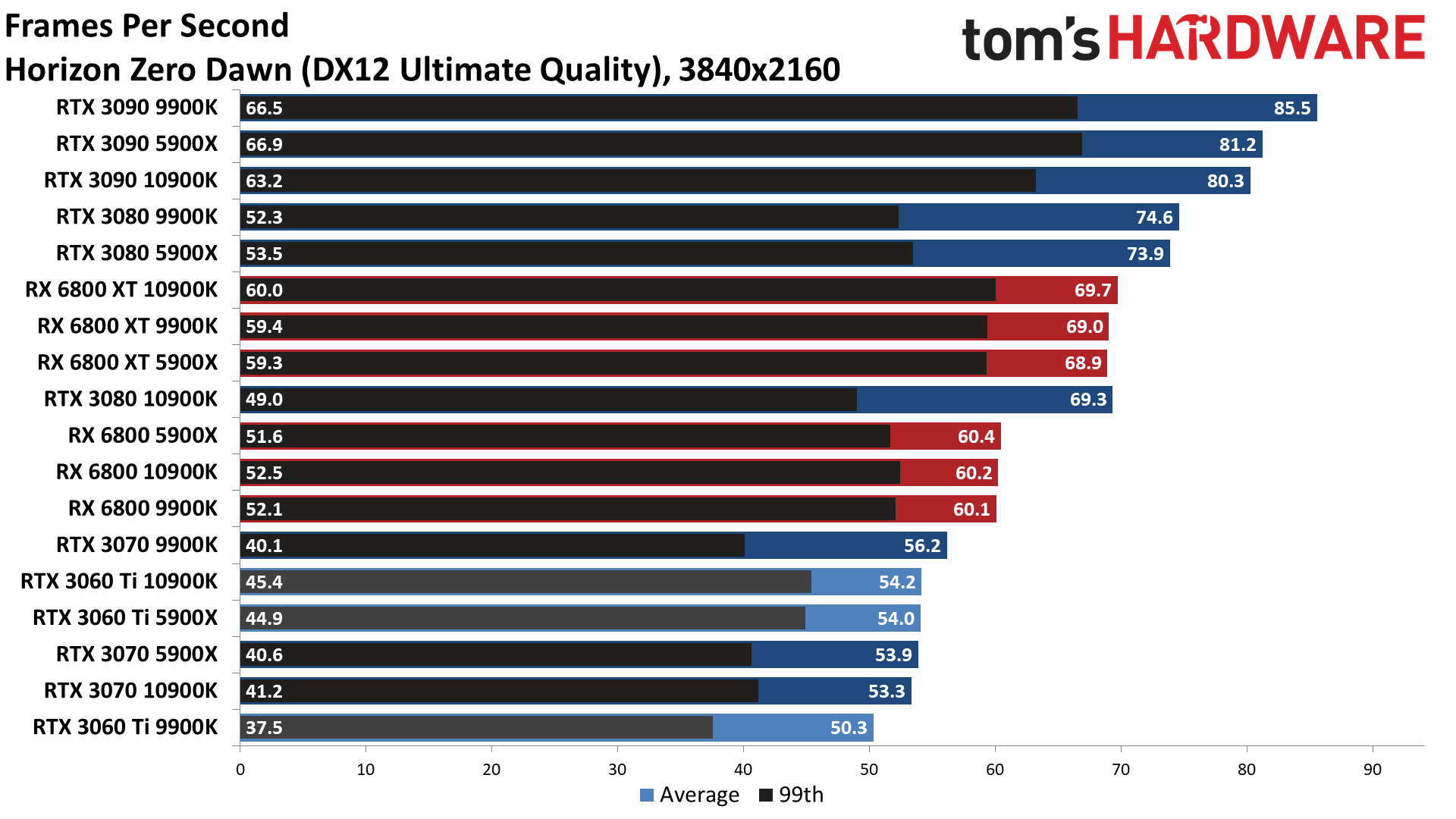
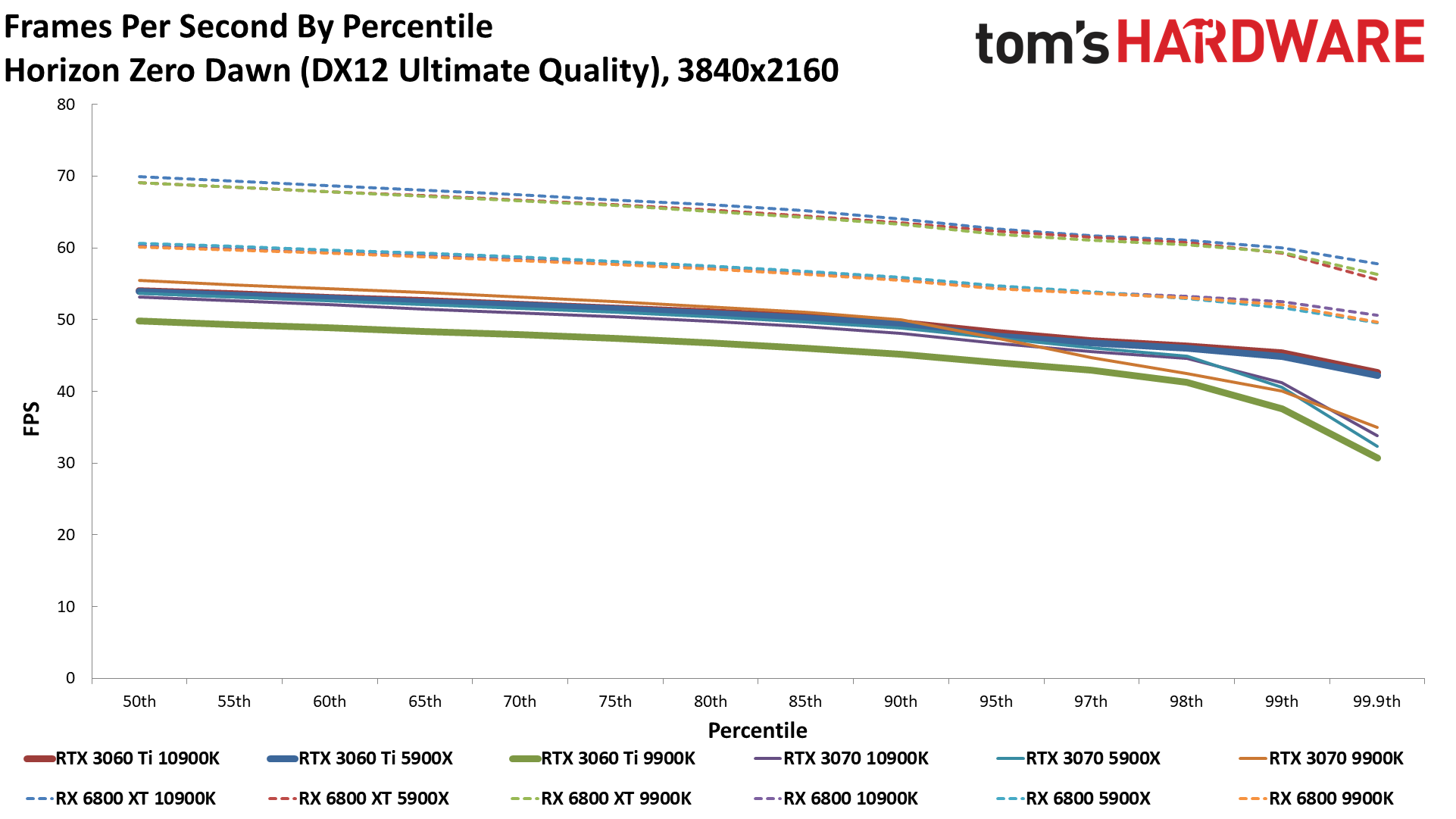
Horizon Zero Dawn came out on PS4 back in 2017 but only arrived for PC this past August. It's based on the same game engine as Death Stranding and uses the DX12 API. Given its console heritage, you might expect this one to favor AMD GPUs a bit, and it does. Or at least, AMD has more consistent fps and fewer oddities.
For example, the 3060 Ti with the 10900K outperforms the 3070 with 5900X and 10900K. We may need to retest (again), but we've run out of time for the initial launch review so we'll just mark this down as another 'questionable' result. (That's why some of these games are expanded coverage and not part of our traditional test suite, which we're working on updating.)
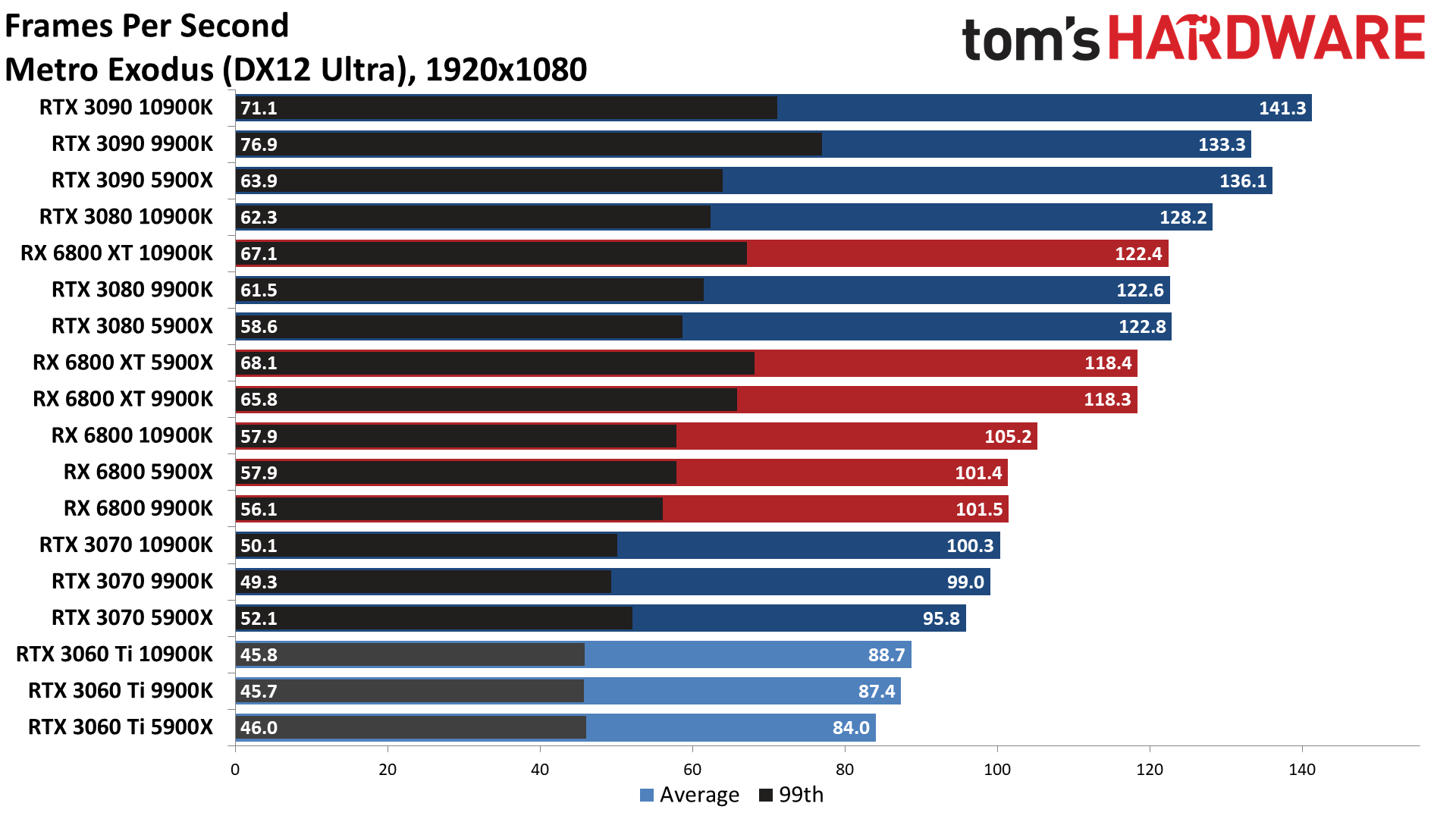
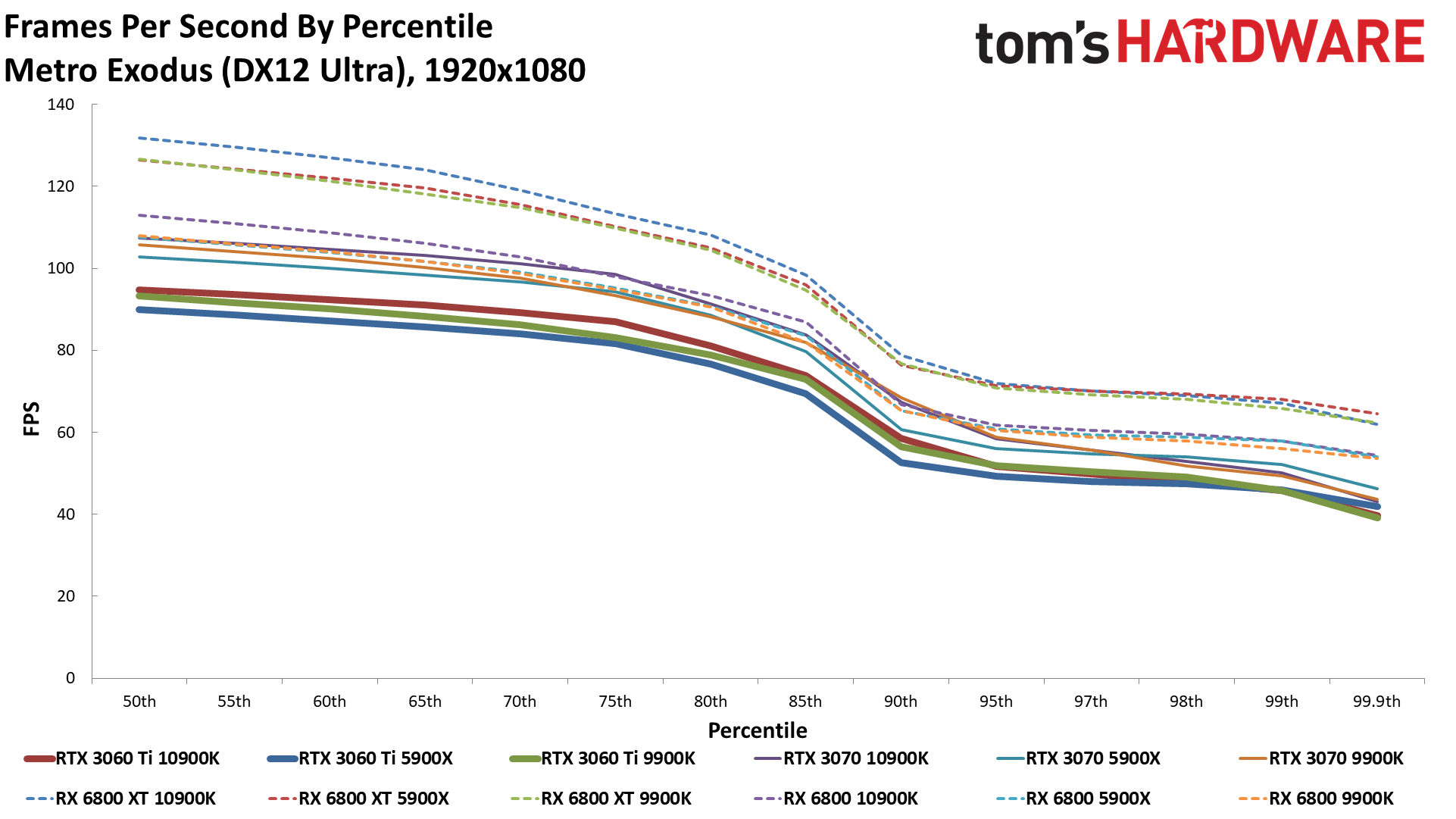
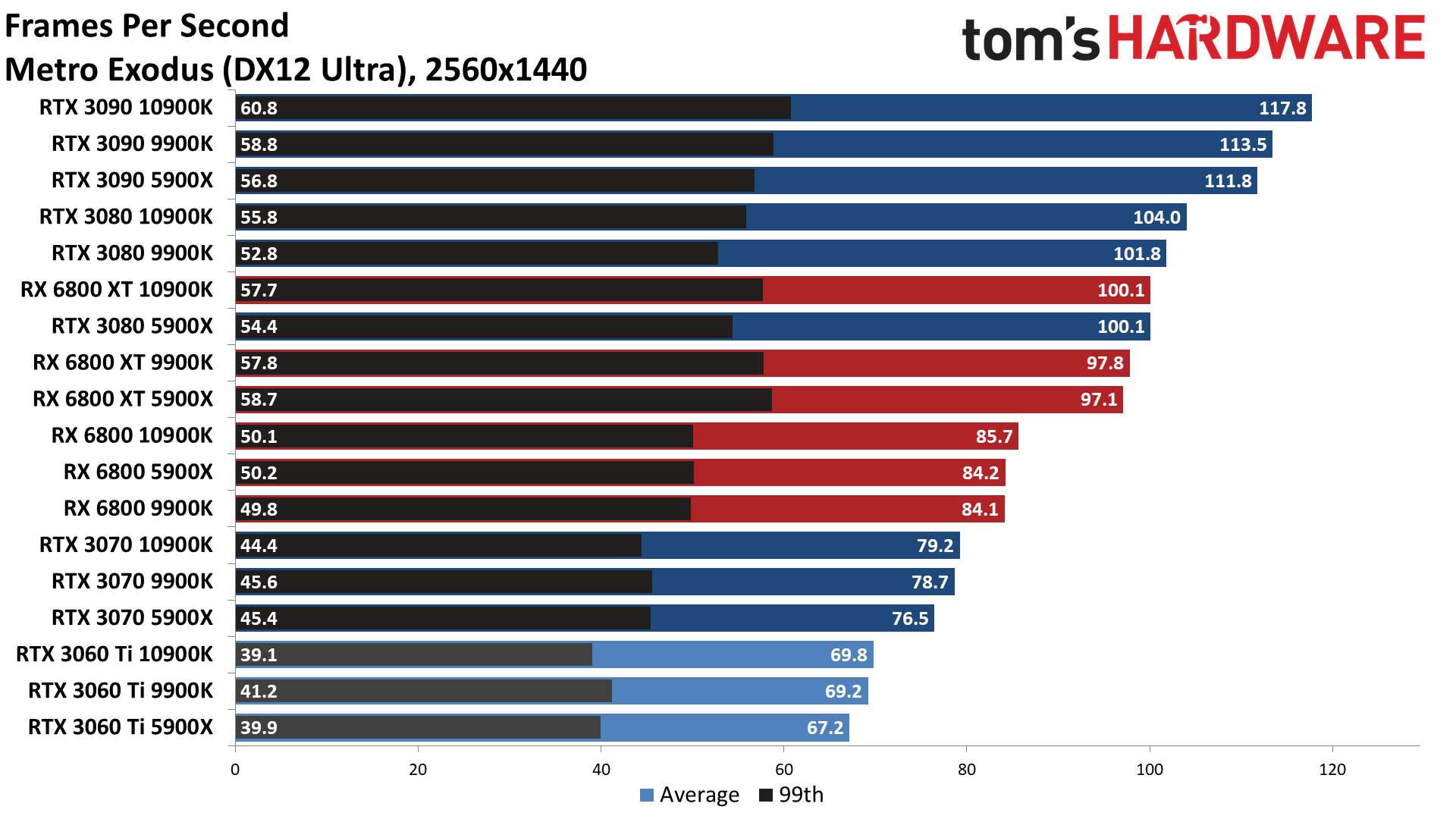
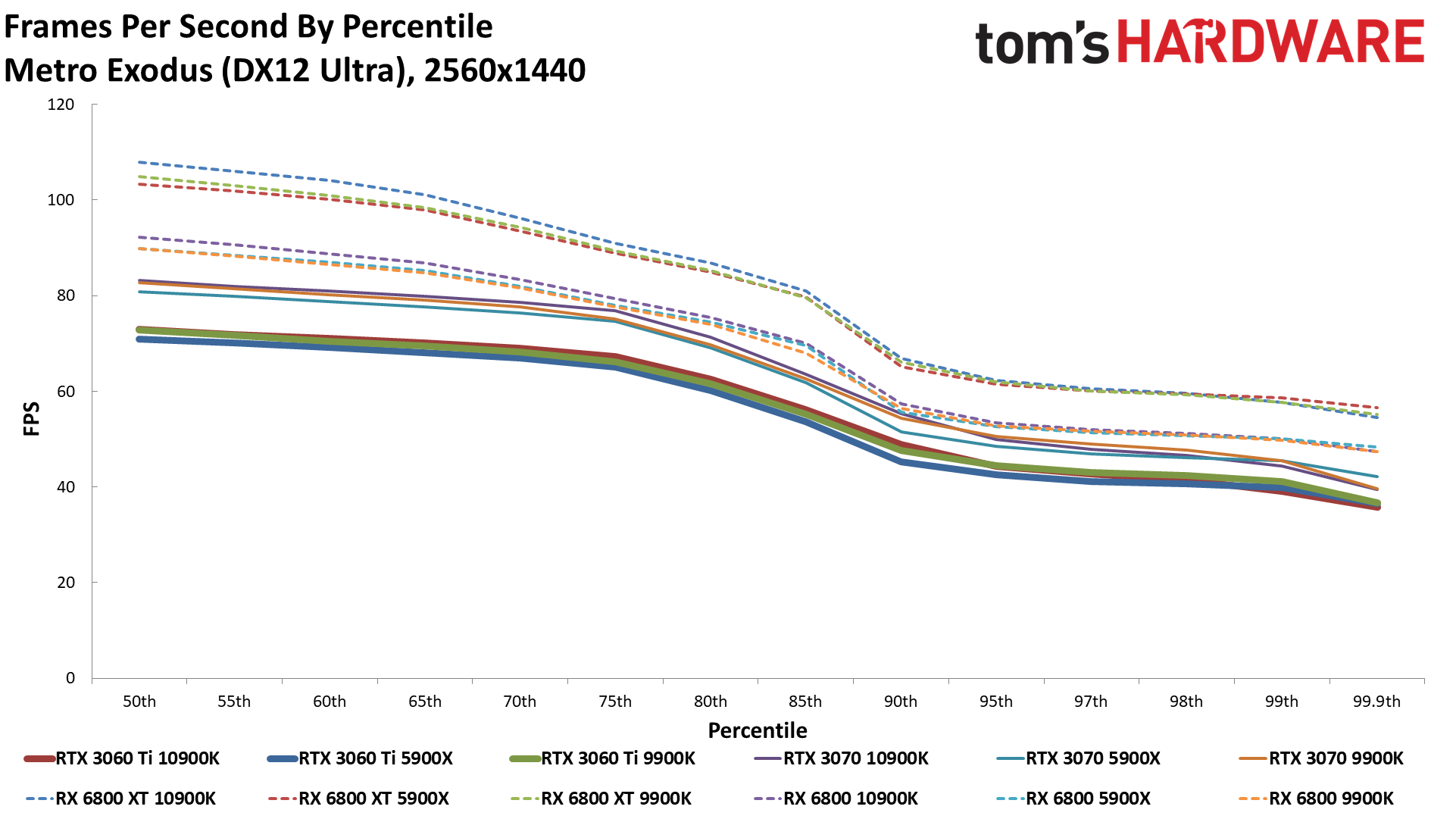
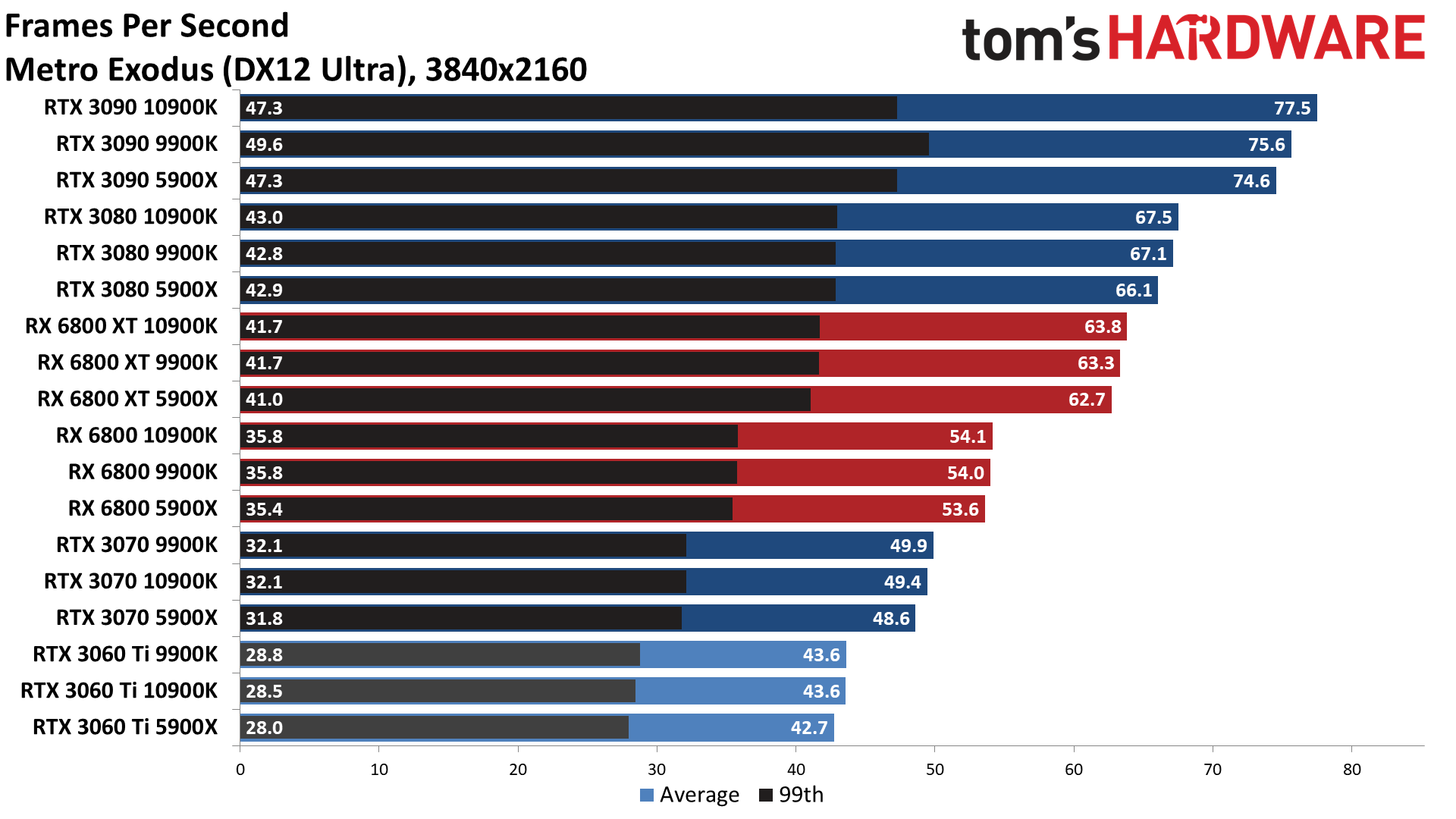
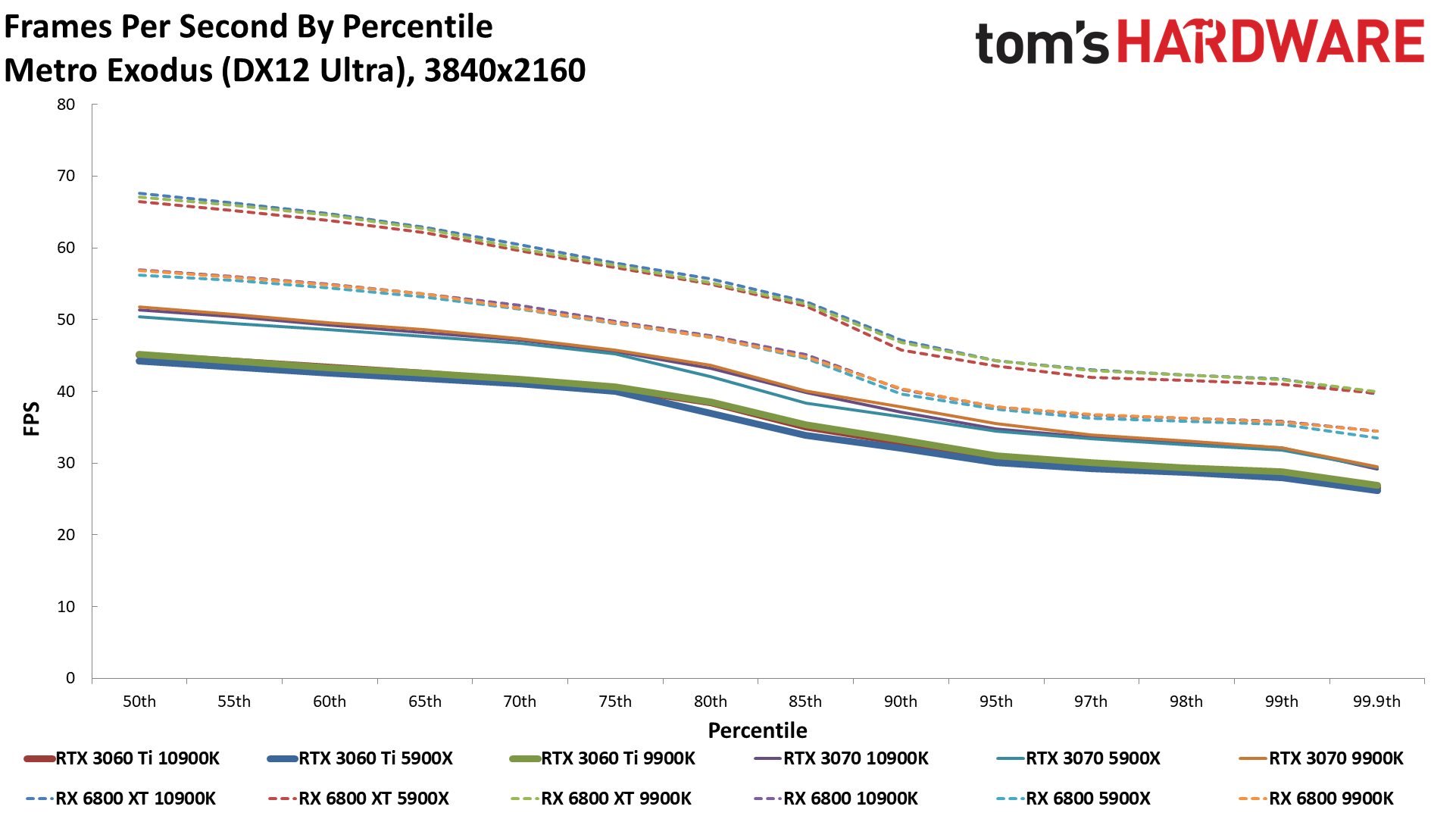
Metro Exodus was one of the first games with ray tracing support, but we're just using the default ultra preset here. It's an Nvidia promoted game, thanks mostly to the RTX enhancements, though the 3080 does come out ahead of the 6800 XT here. The 3060 Ti does fine up to 1440p, but 4K proves to be a bit much.
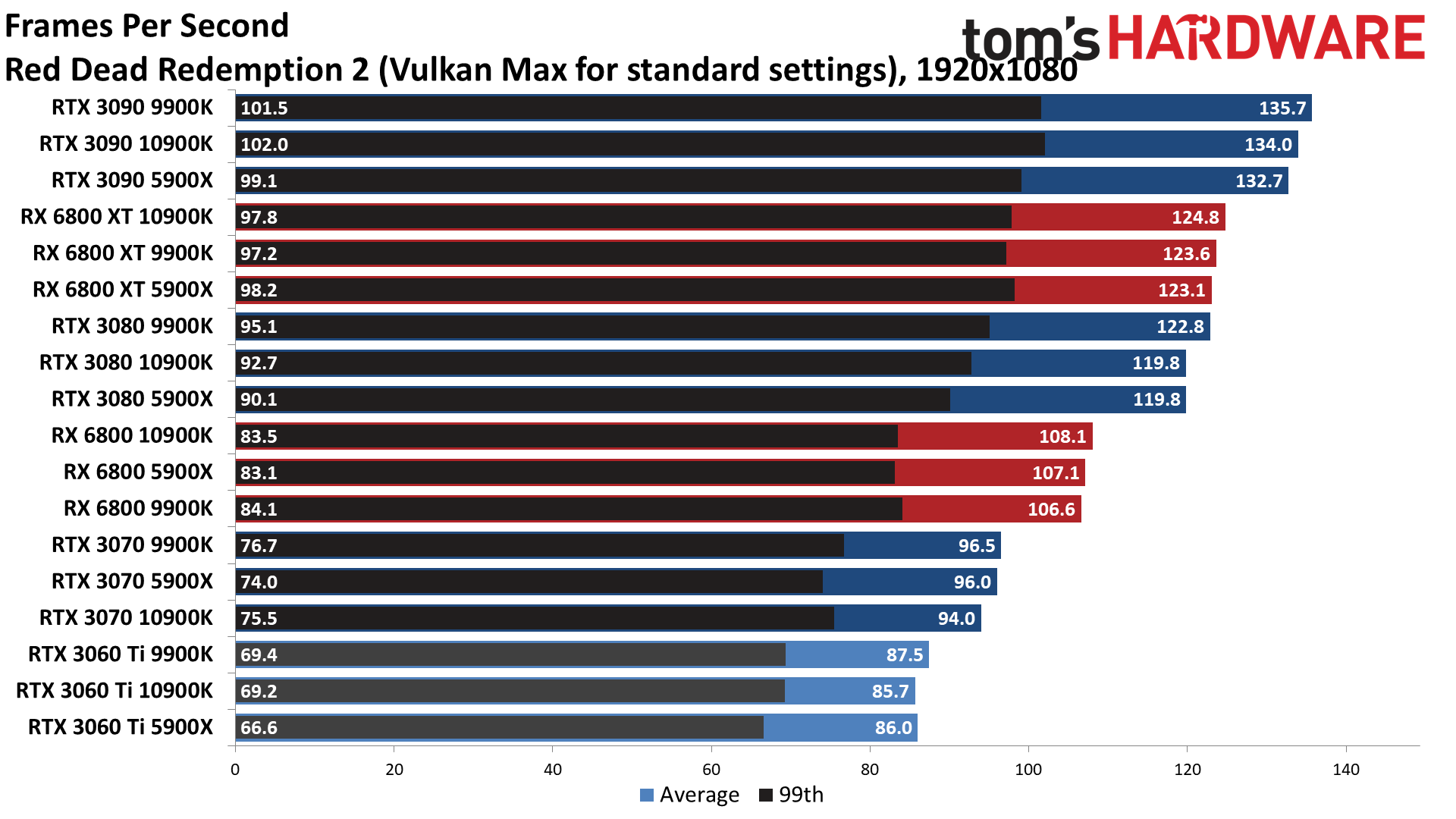
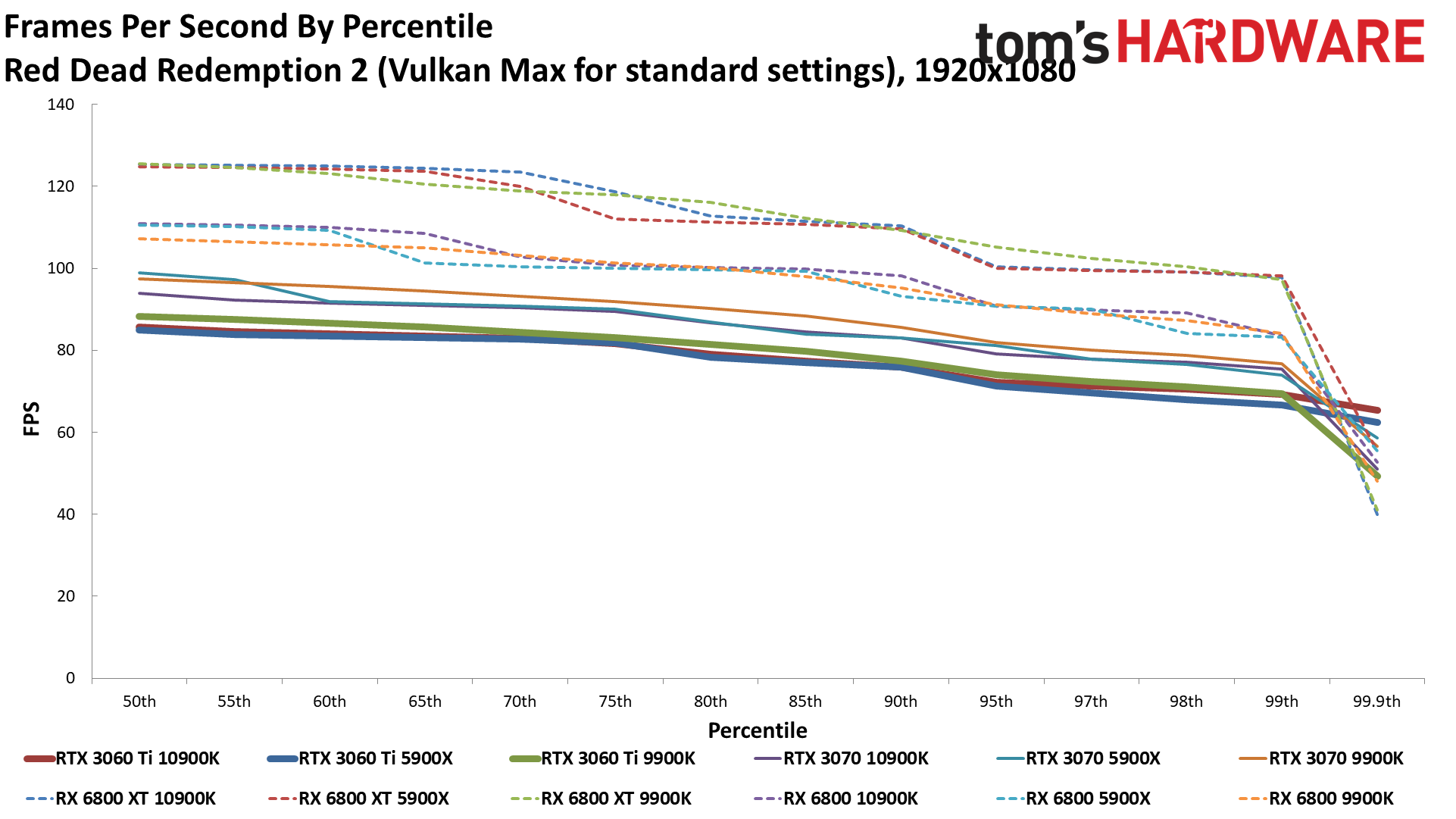
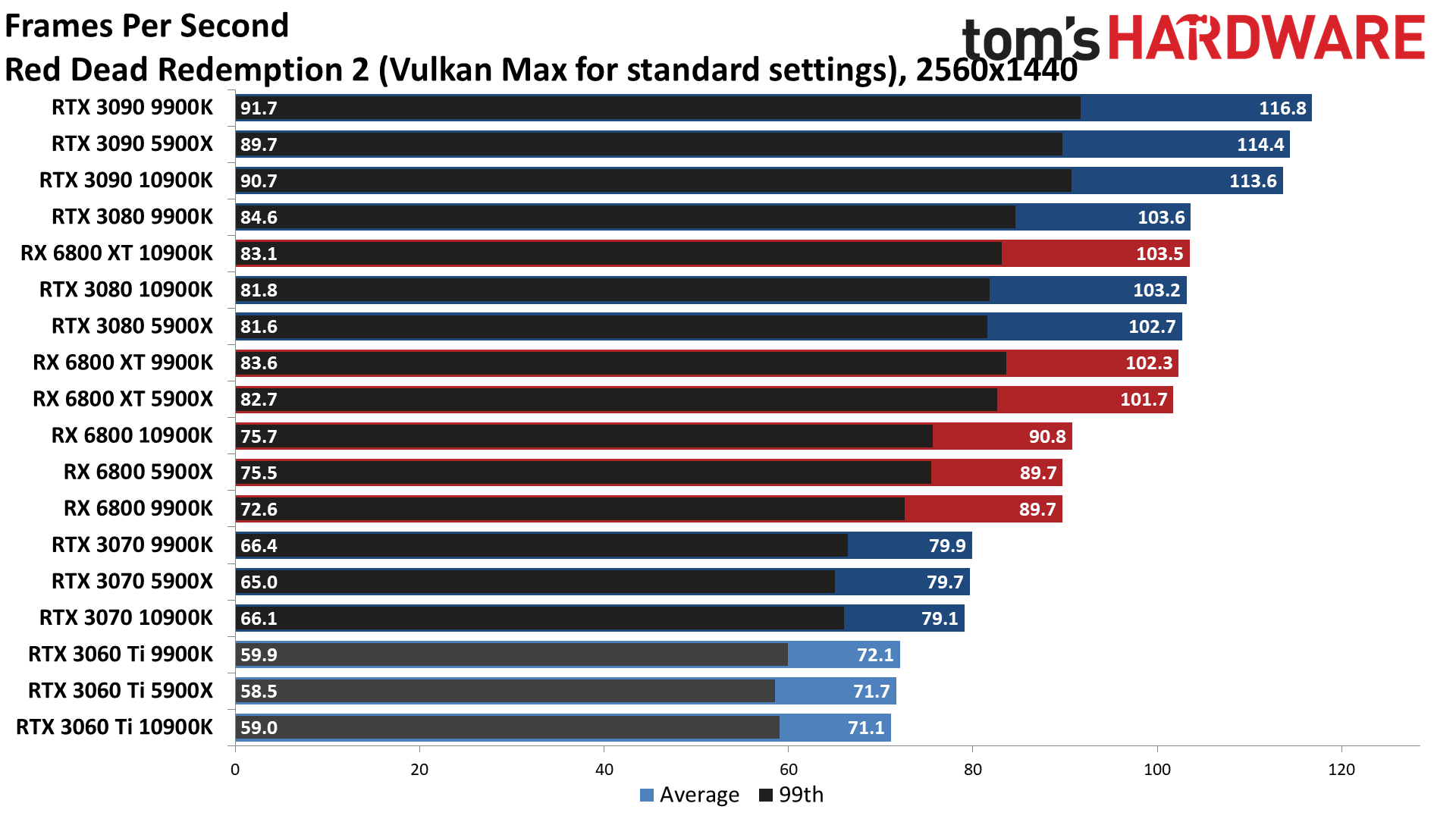
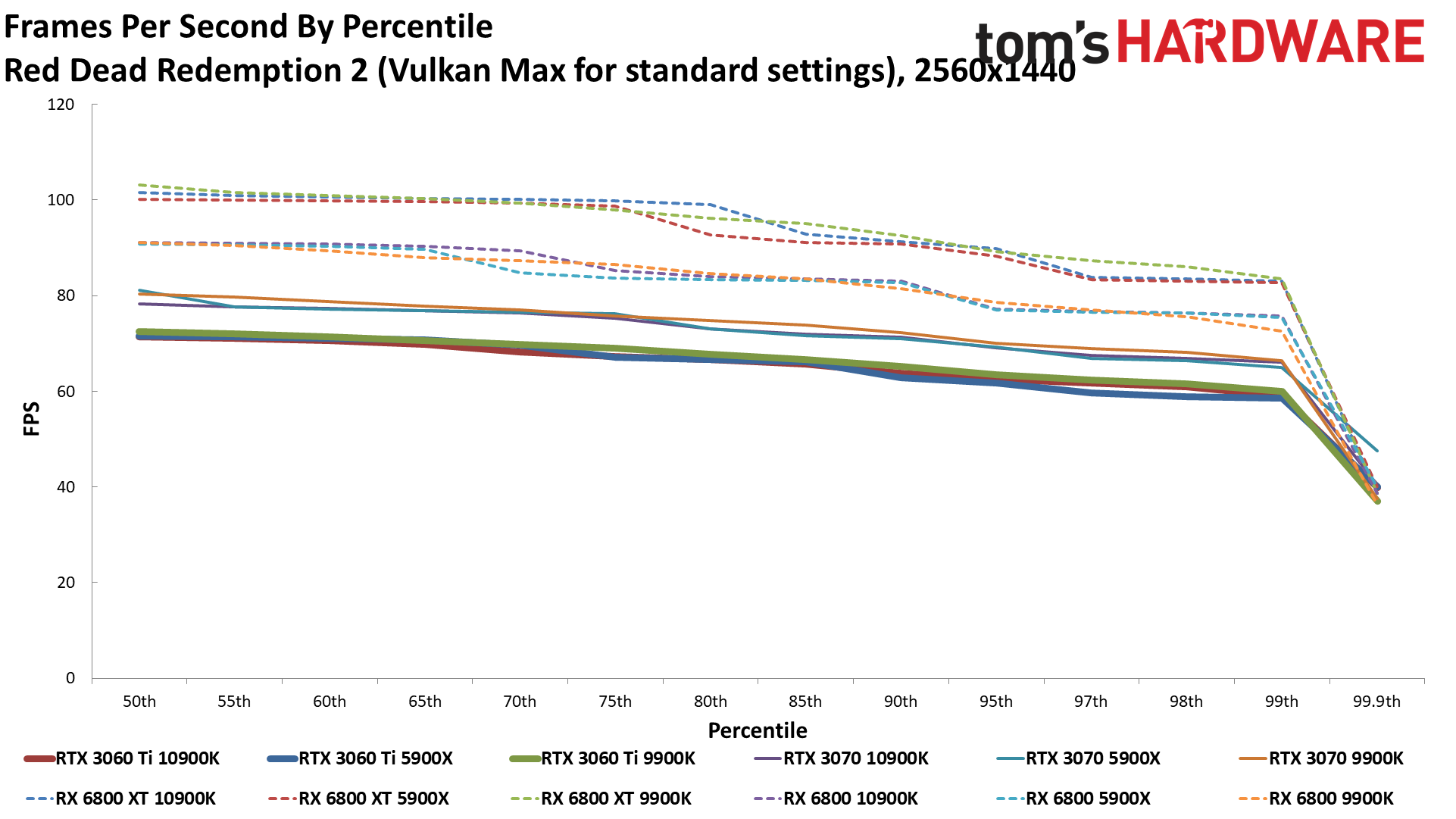
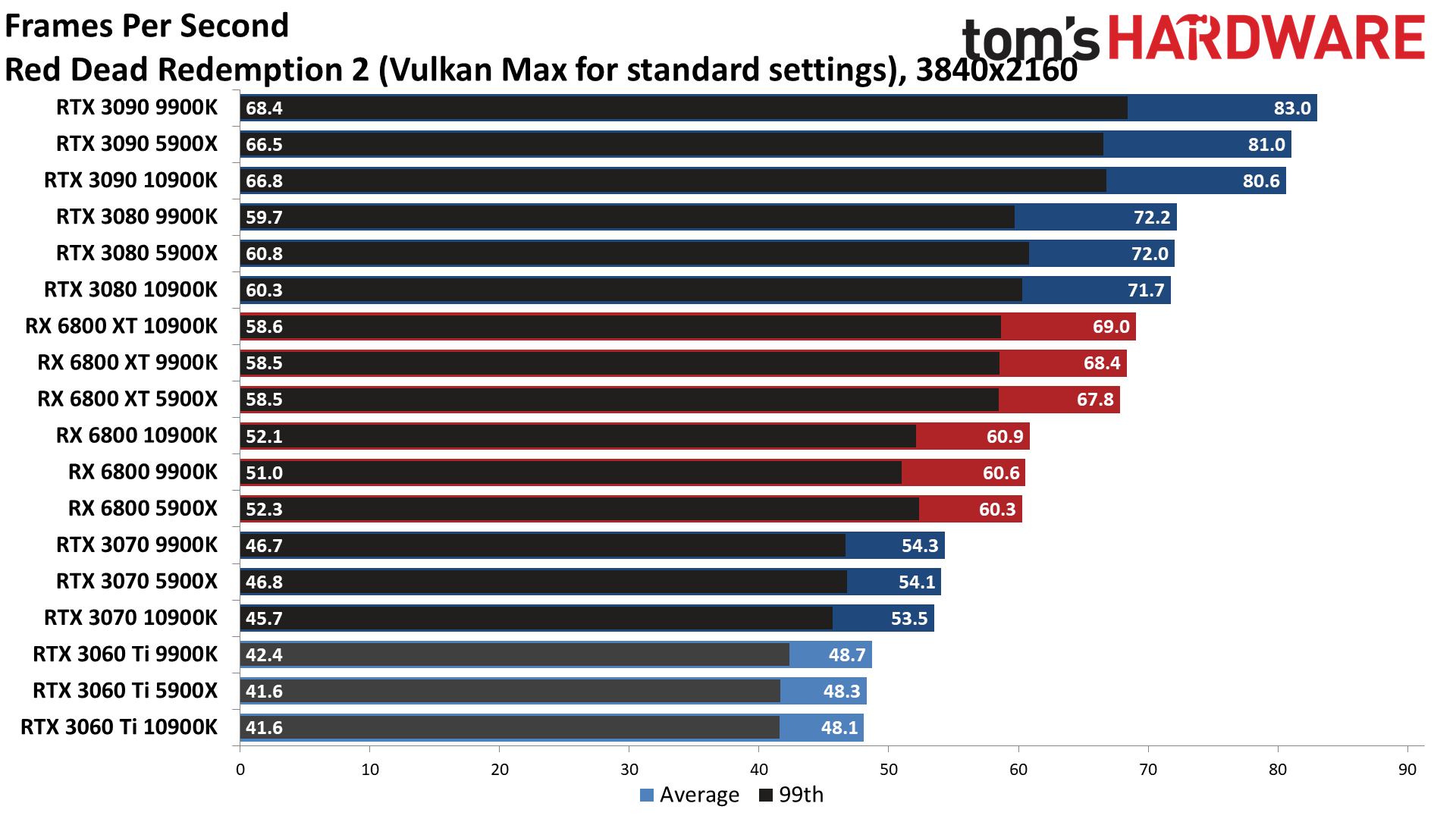
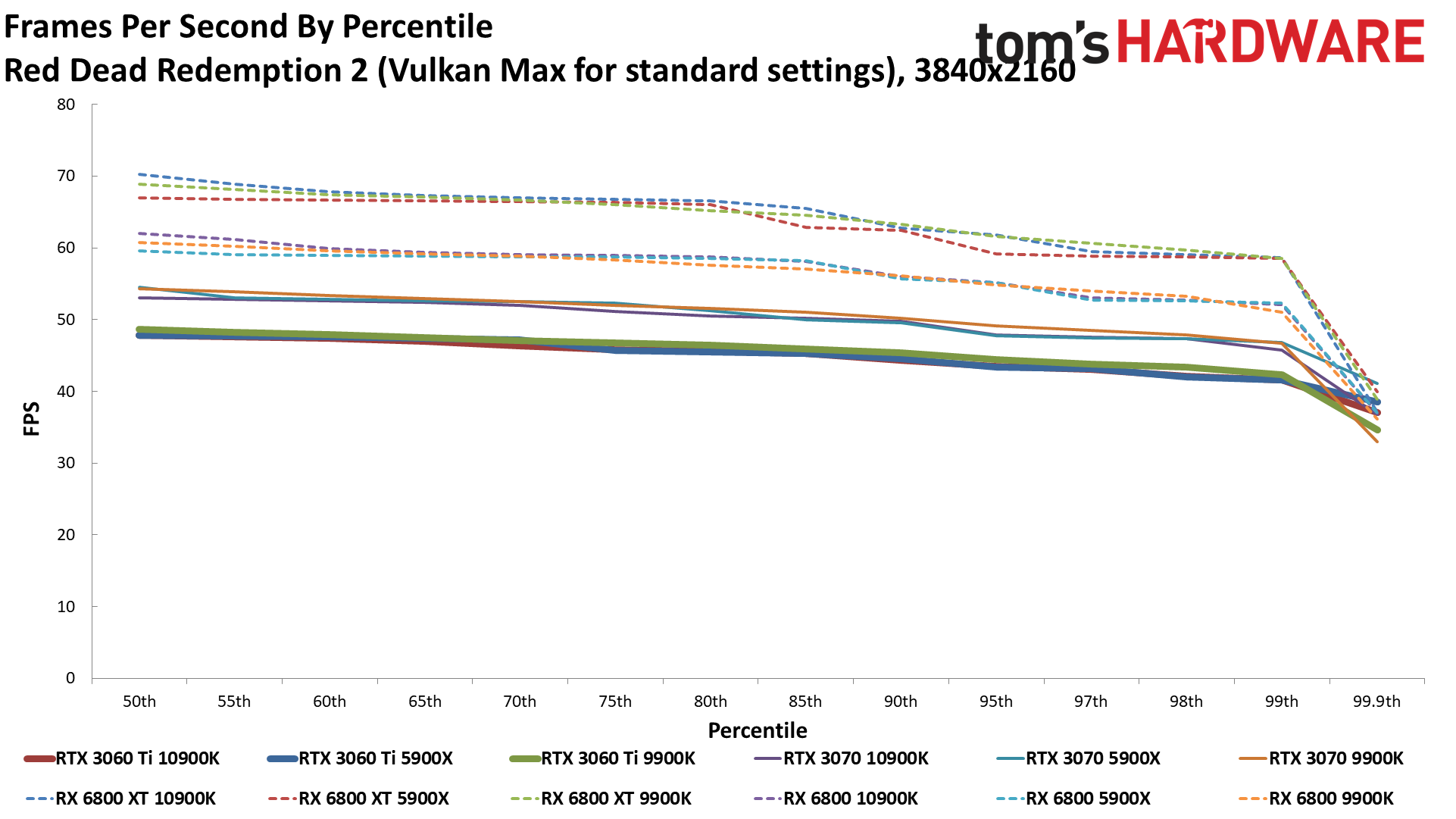
Red Dead Redemption 2 is our first Vulkan API result — it supports DX12 as well, but our previous testing showed that Vulkan performs best in most cases. The GeForce RTX 3060 Ti again does well up to 1440p, but starts to struggle at 4K. The three CPUs all perform similarly, and the lengthy benchmark sequence tends to vary a bit more than in other games, so we wouldn't worry too much about the 1-2 fps difference between runs.
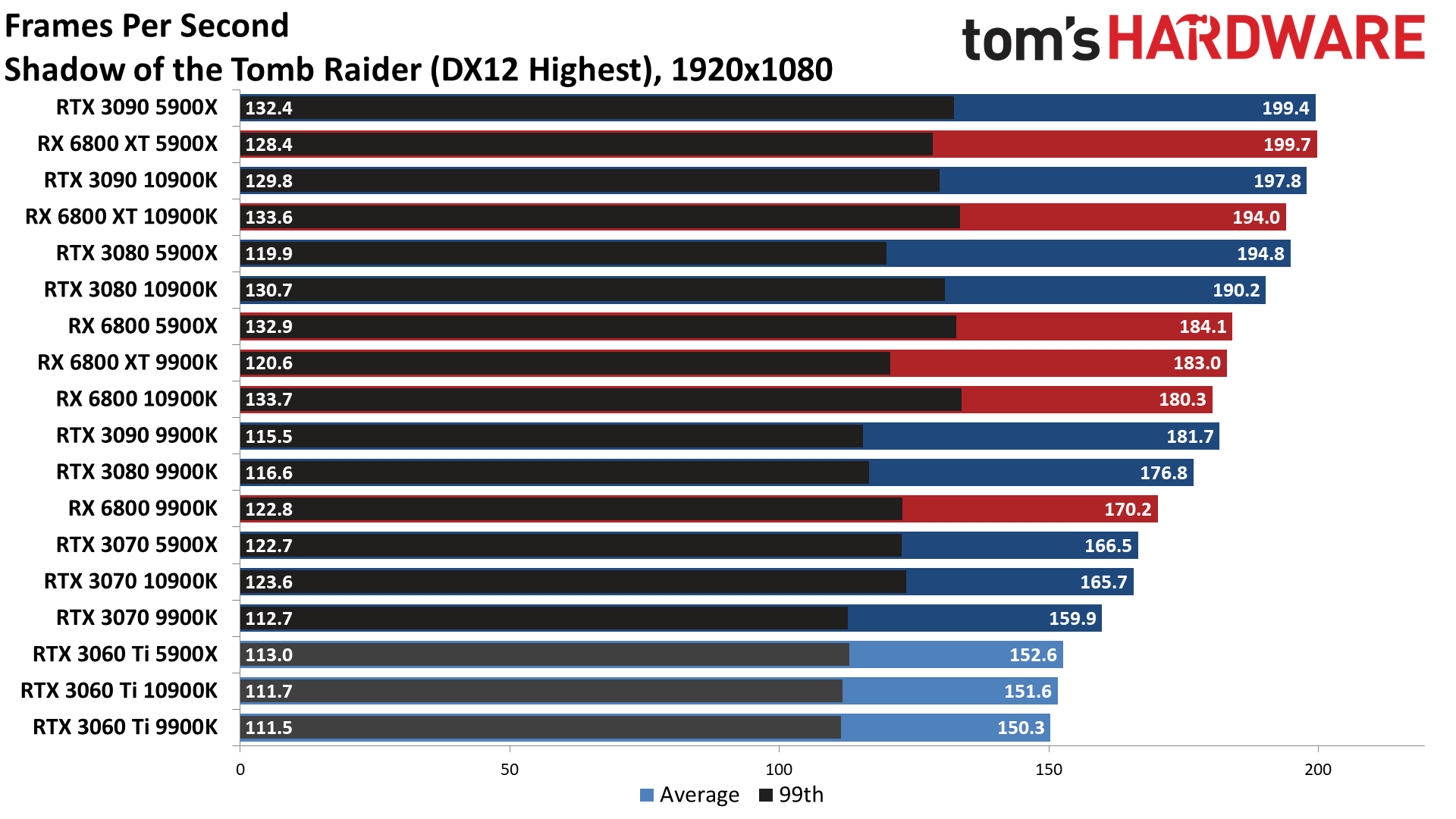
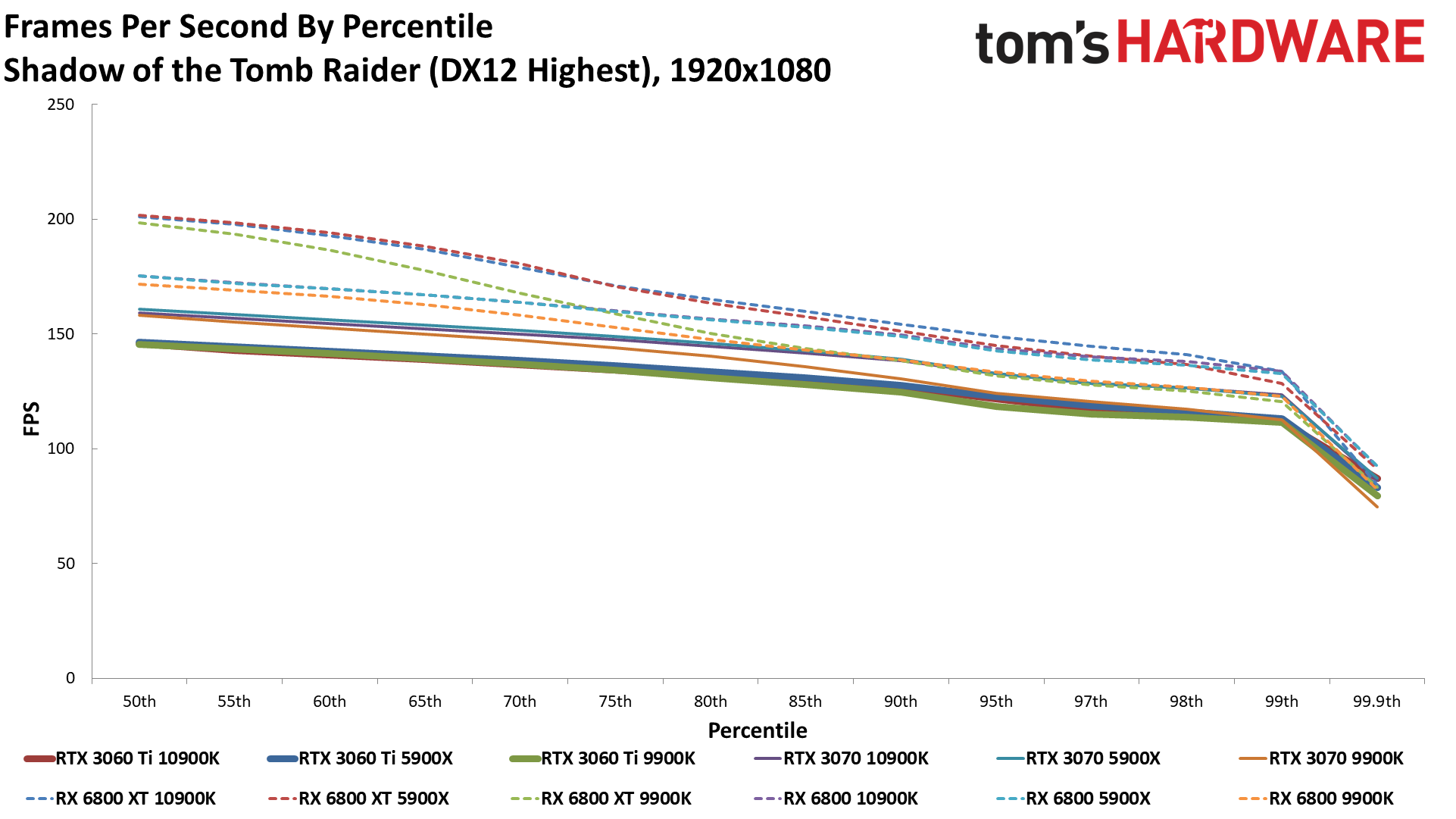
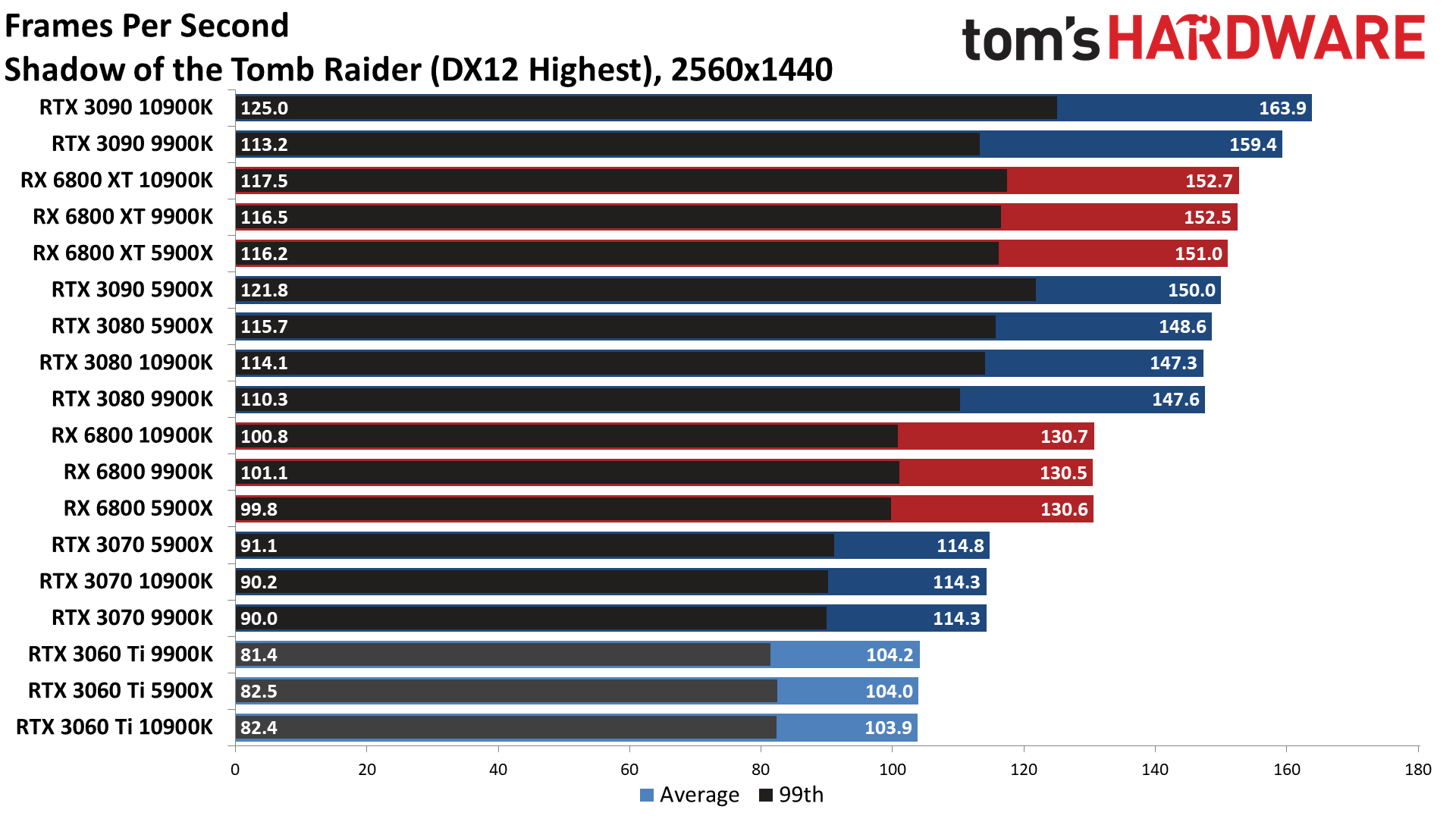
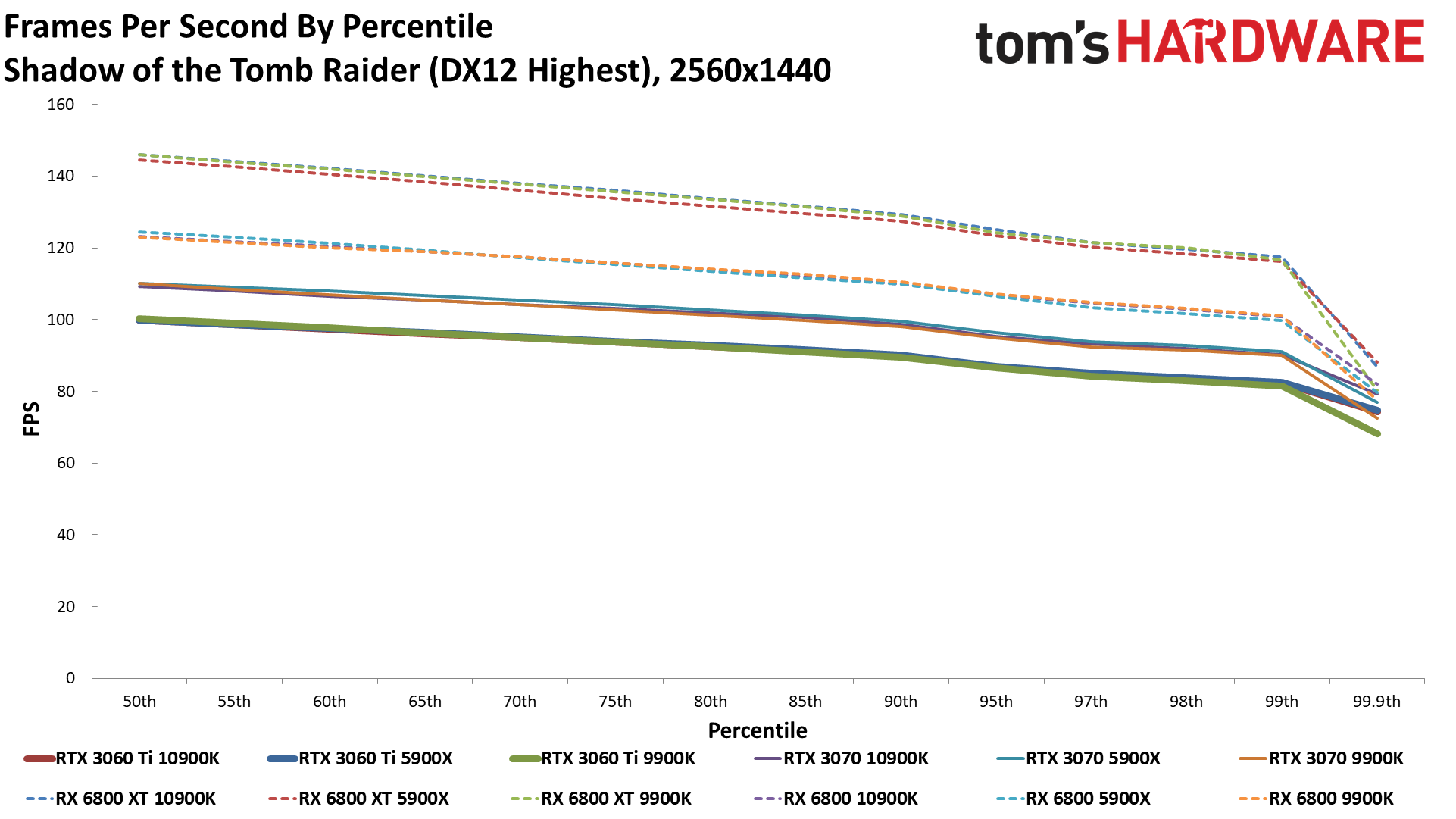
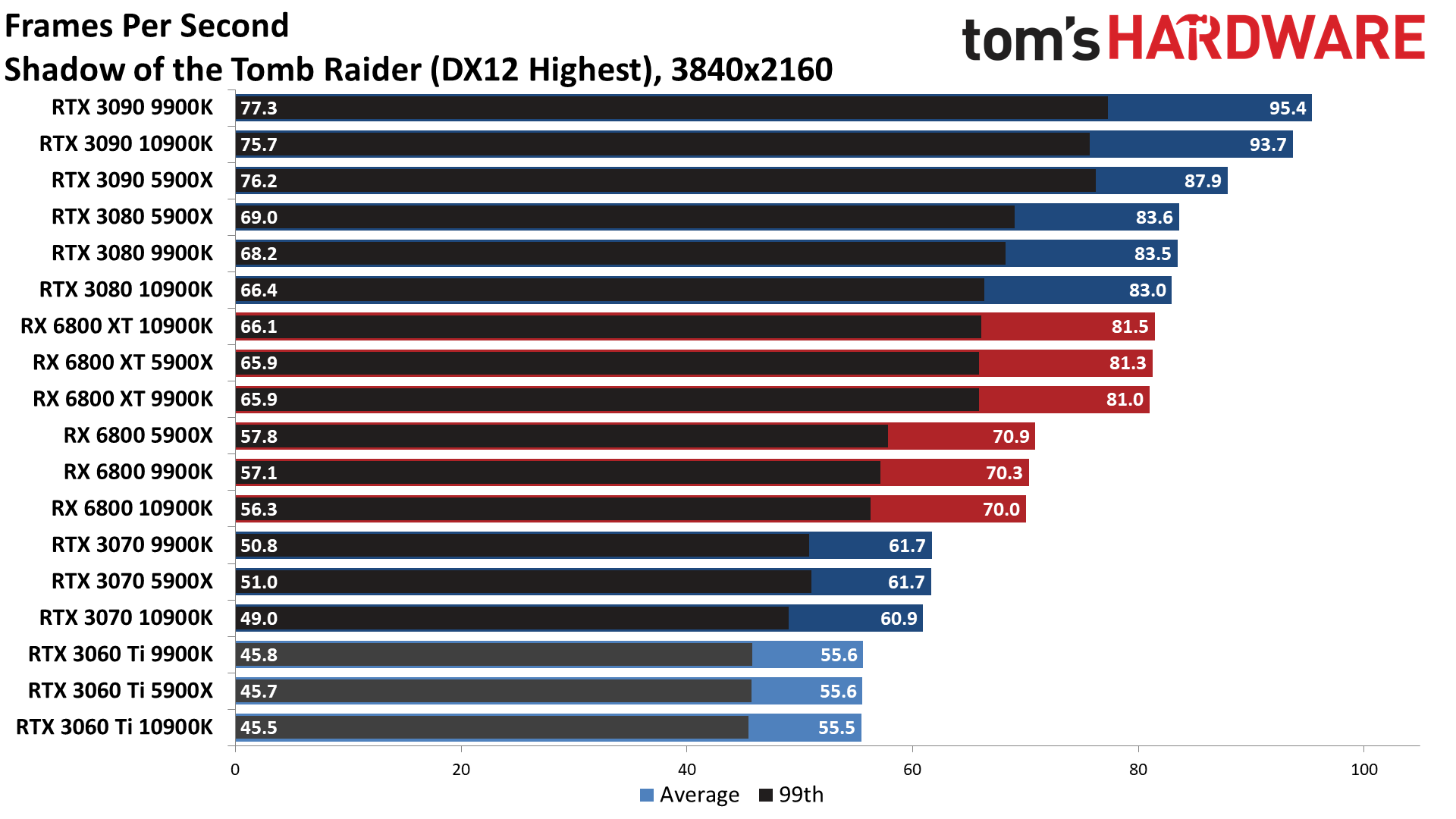
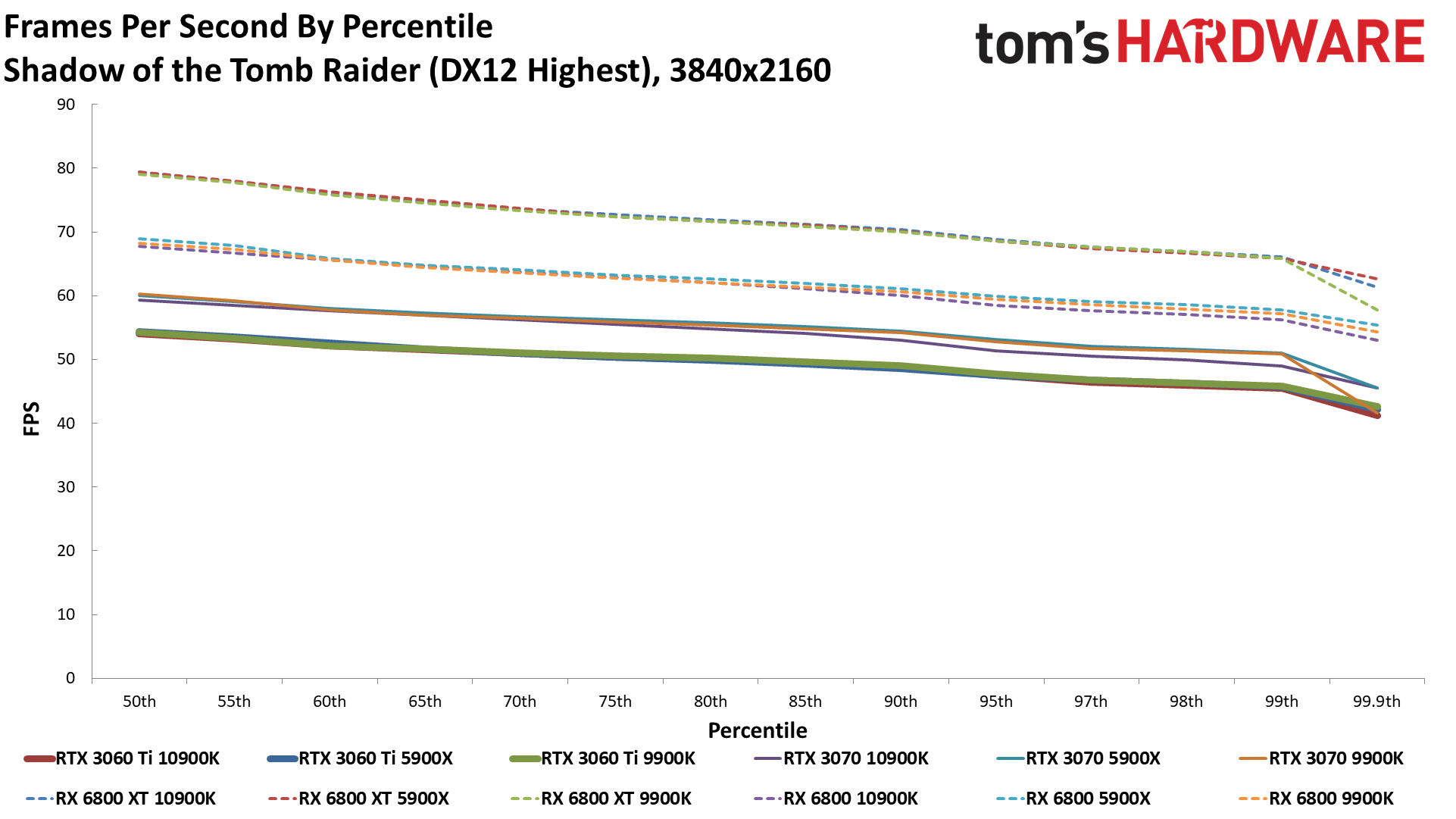
Shadow of the Tomb Raider is another DXR-enabled game that we're testing without ray tracing (but we'll include the RT results below), and it's an Nvidia promoted game thanks to the DXR and DLSS support. There's quite a bit of noise in the charts at 1080p, where the game is mostly CPU limited and the 9900K at least holds back a few of the GPUs. Things settle down at 1440p and 4K, with the 3060 Ti once more coming up a bit short of 60 fps.
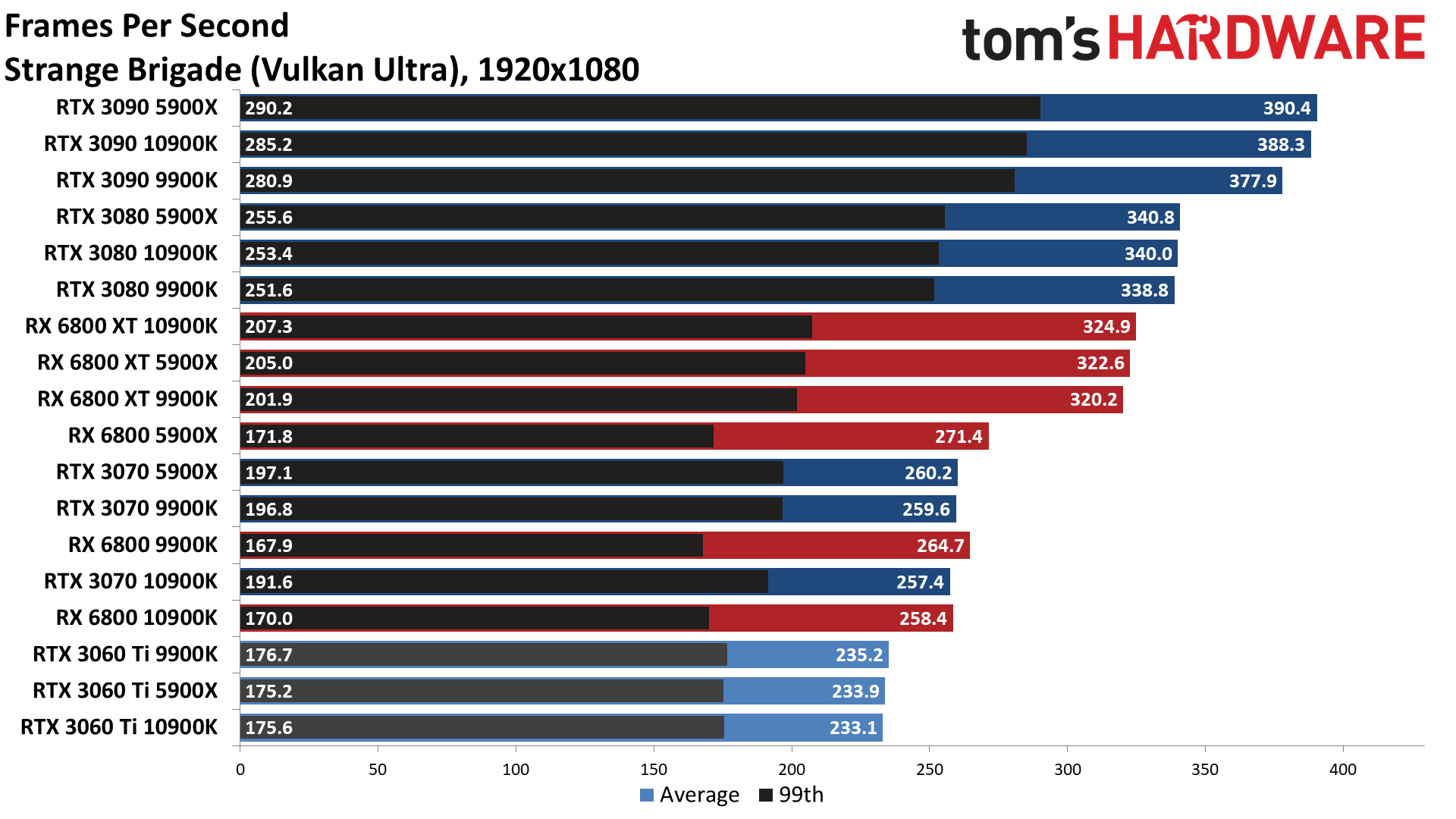
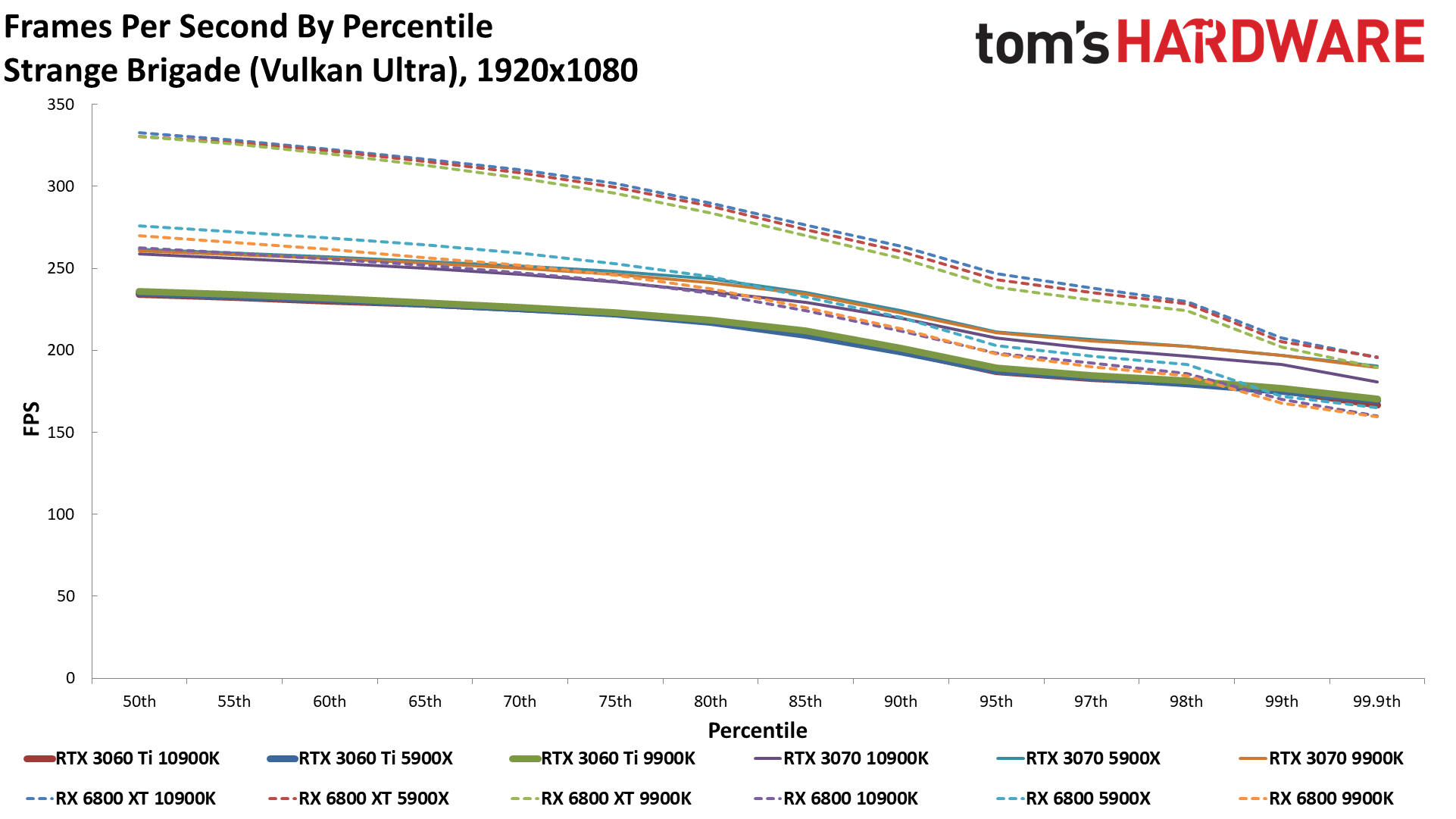
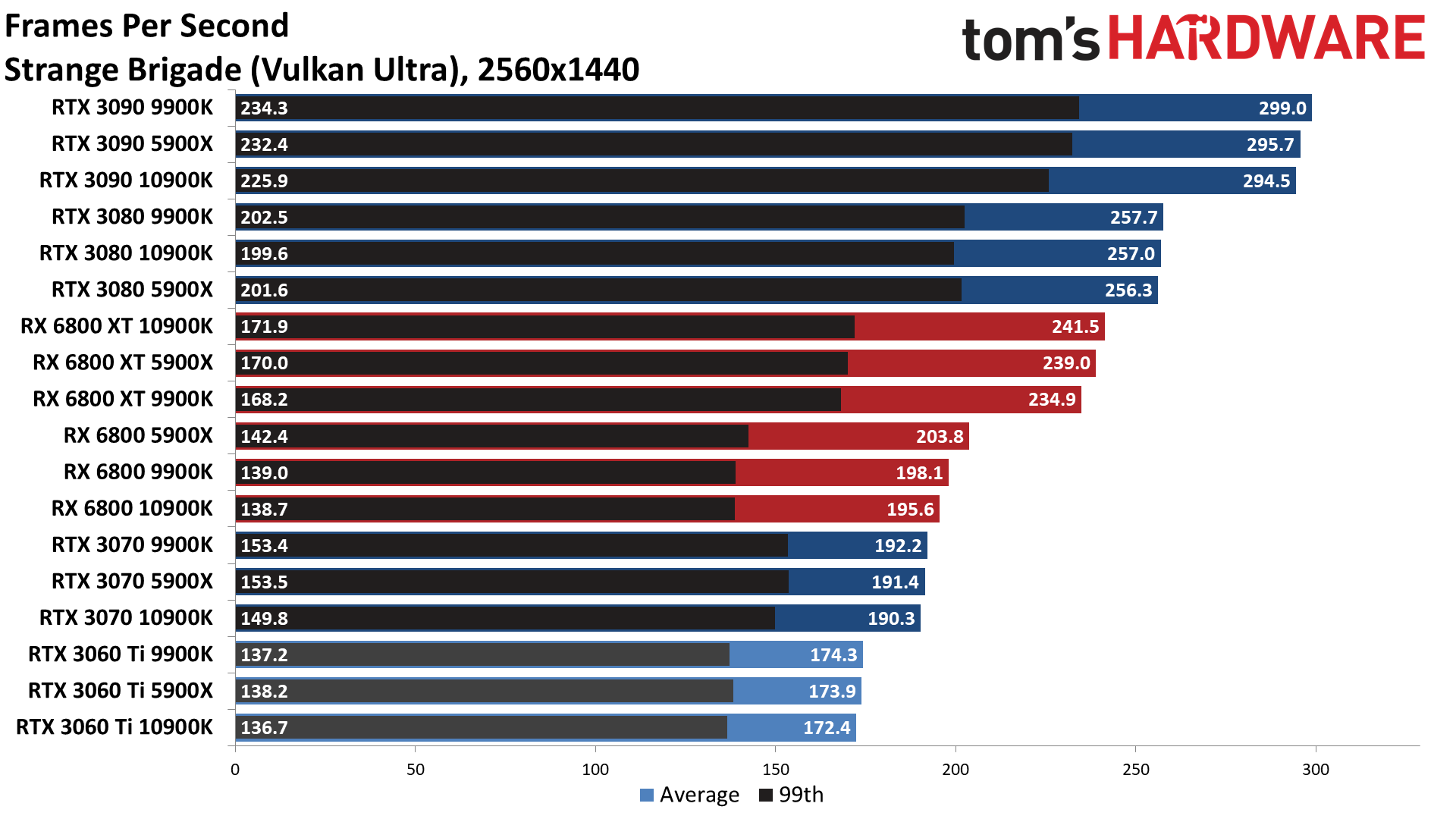
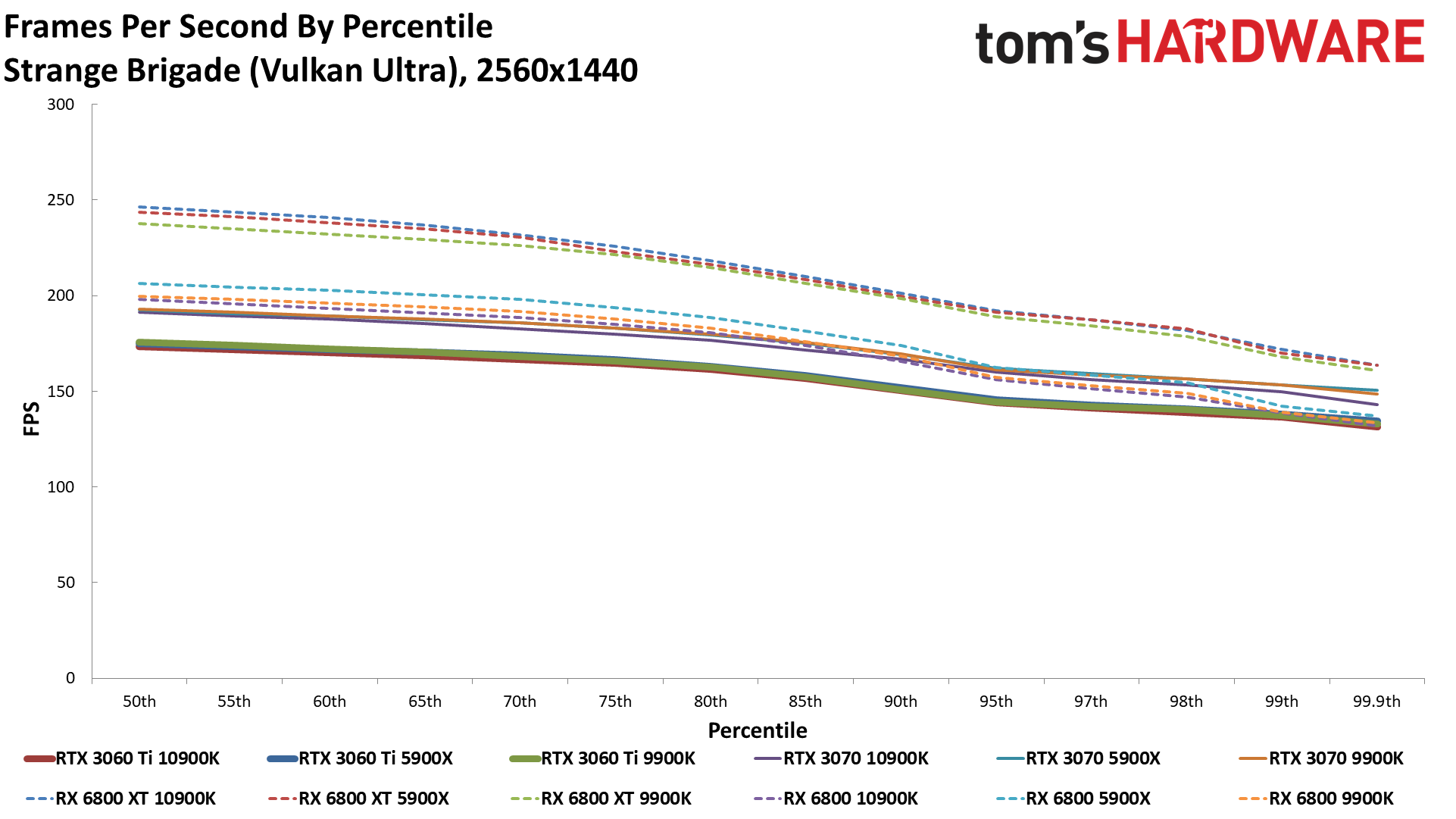
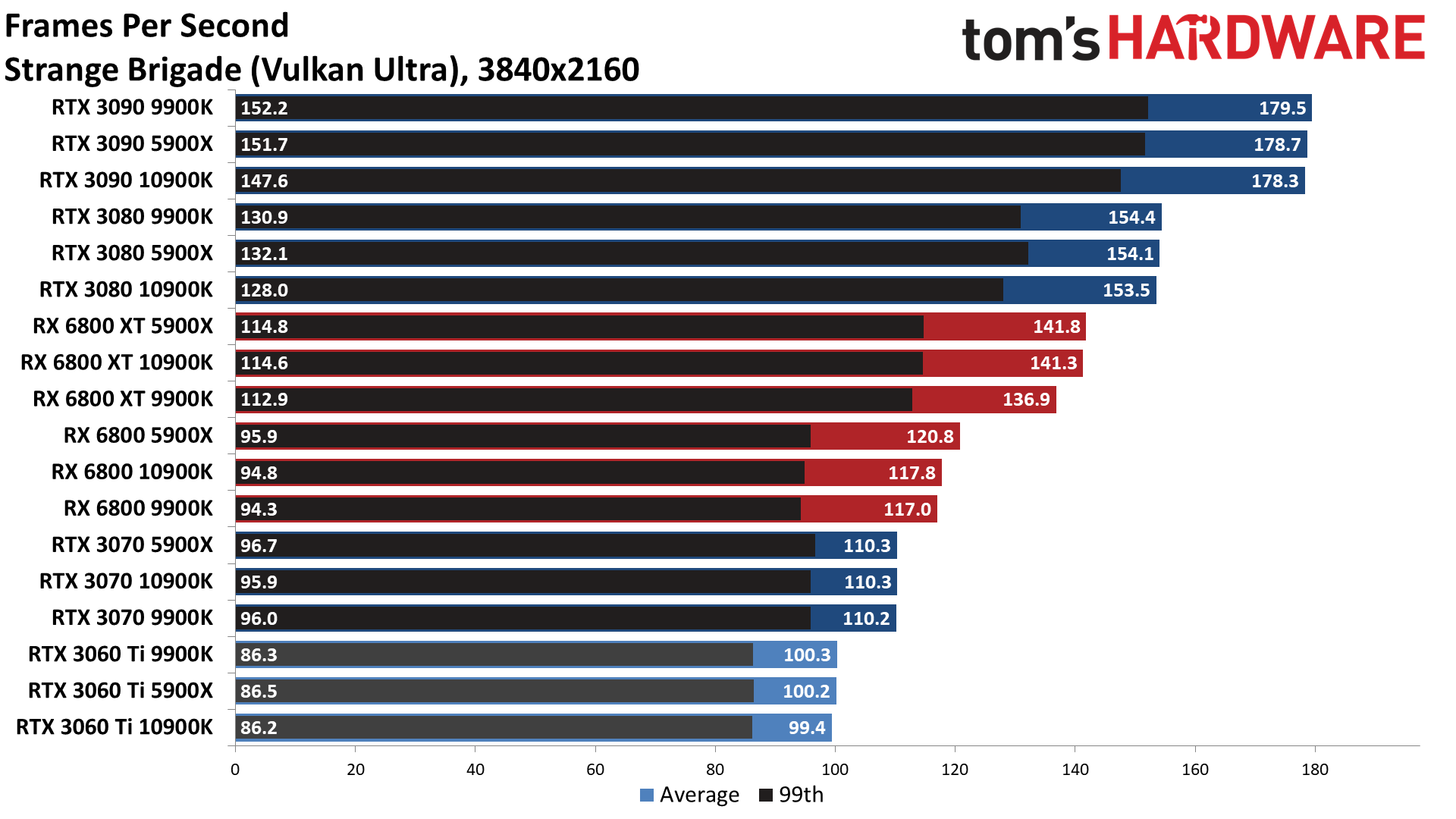
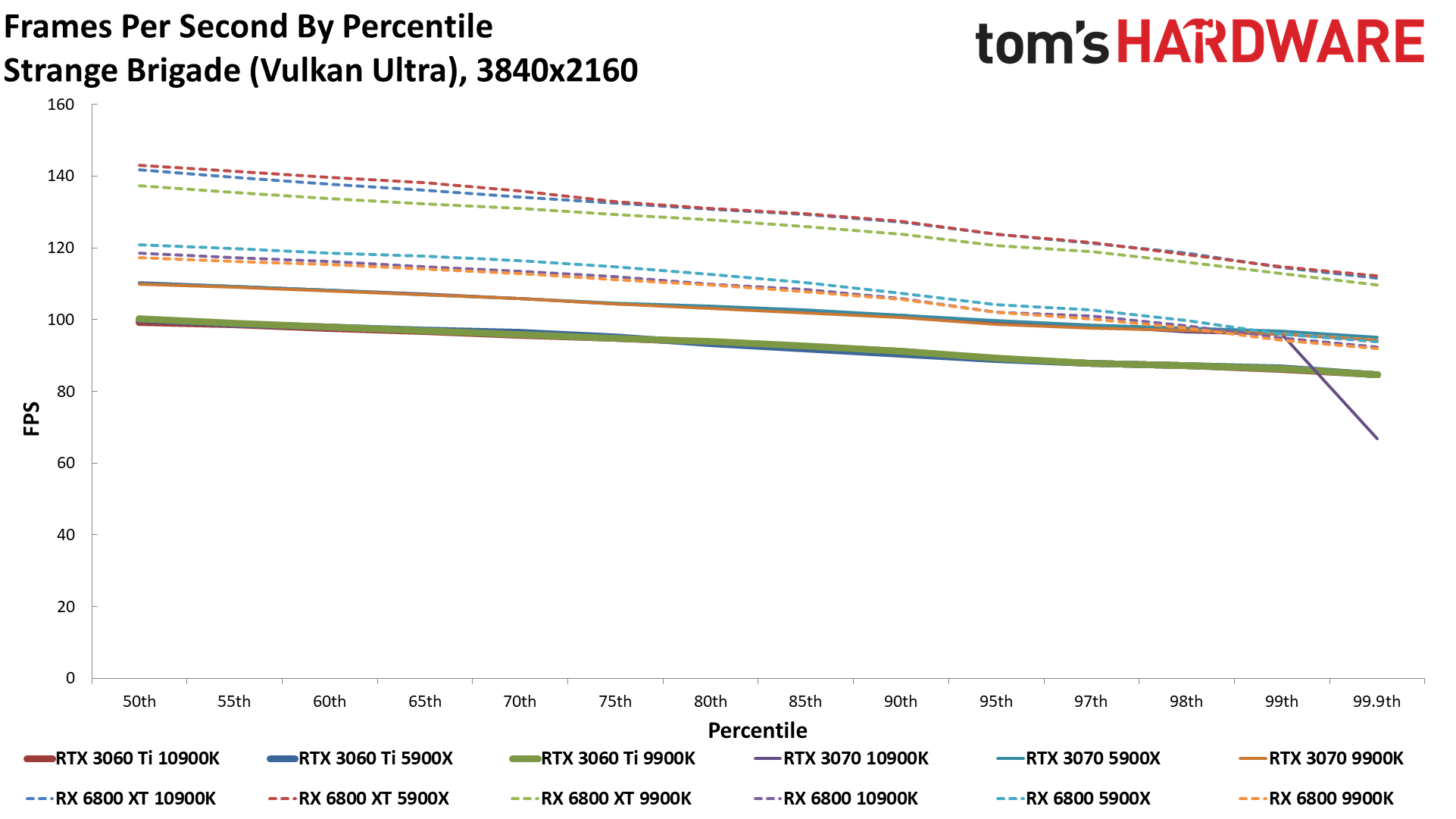
Strange Brigade is our other Vulkan API game, and this time it favors Nvidia's GPUs (even though this is an AMD promotional game). Of course, it's mostly academic as all of the cards hit 100 fps or more even at 4K, and everything is in the 200+ fps range at 1080p.
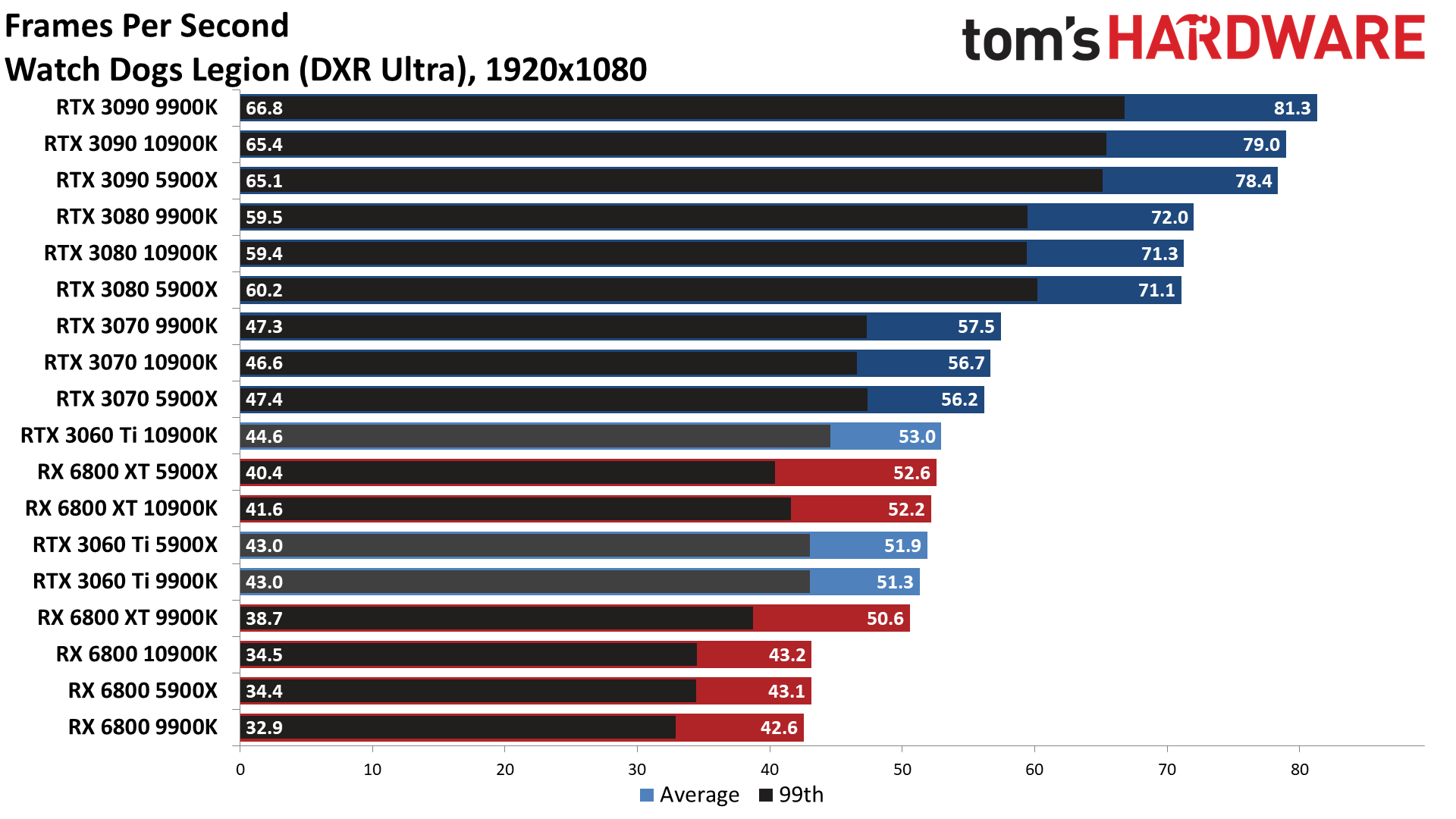
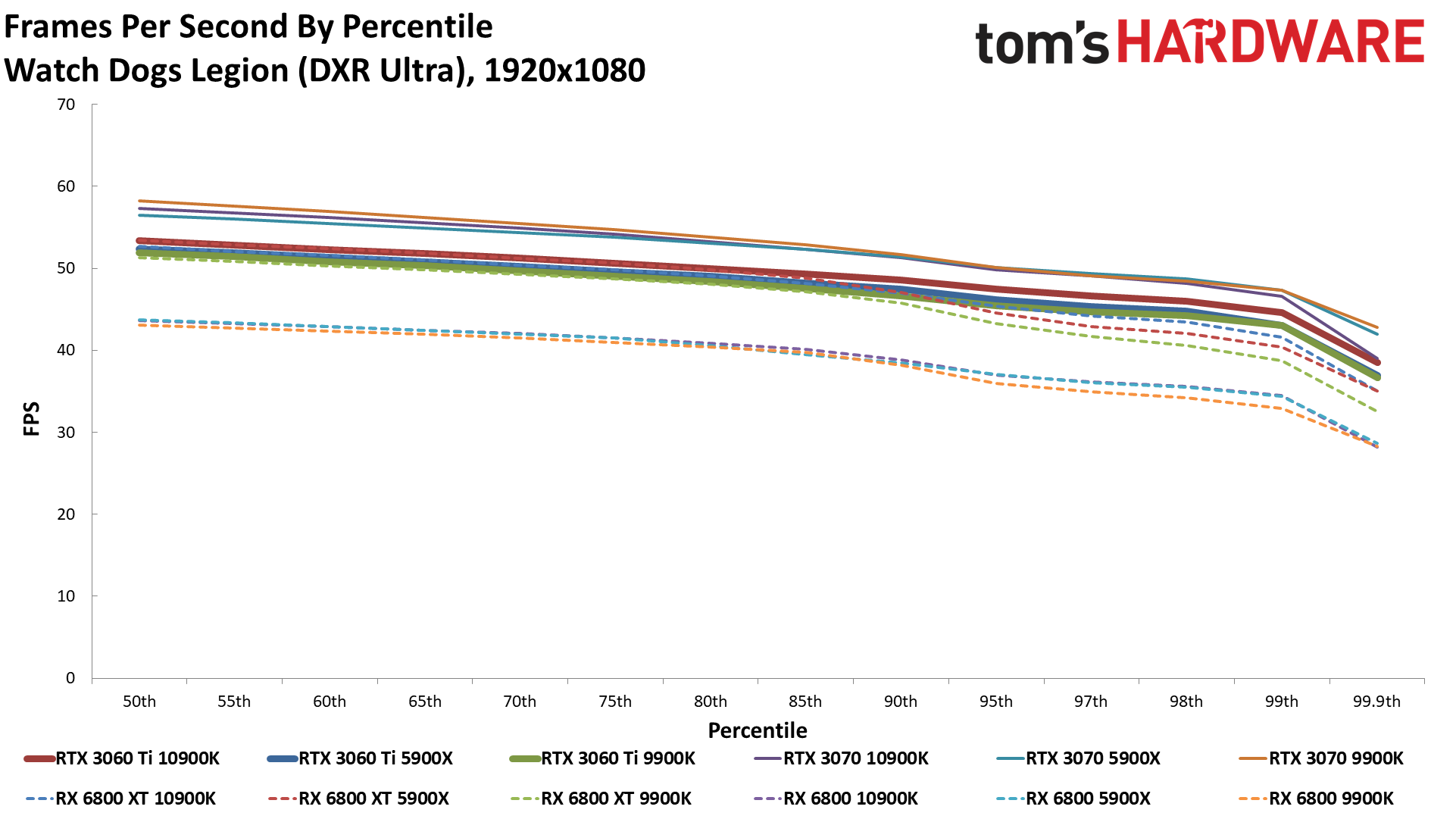
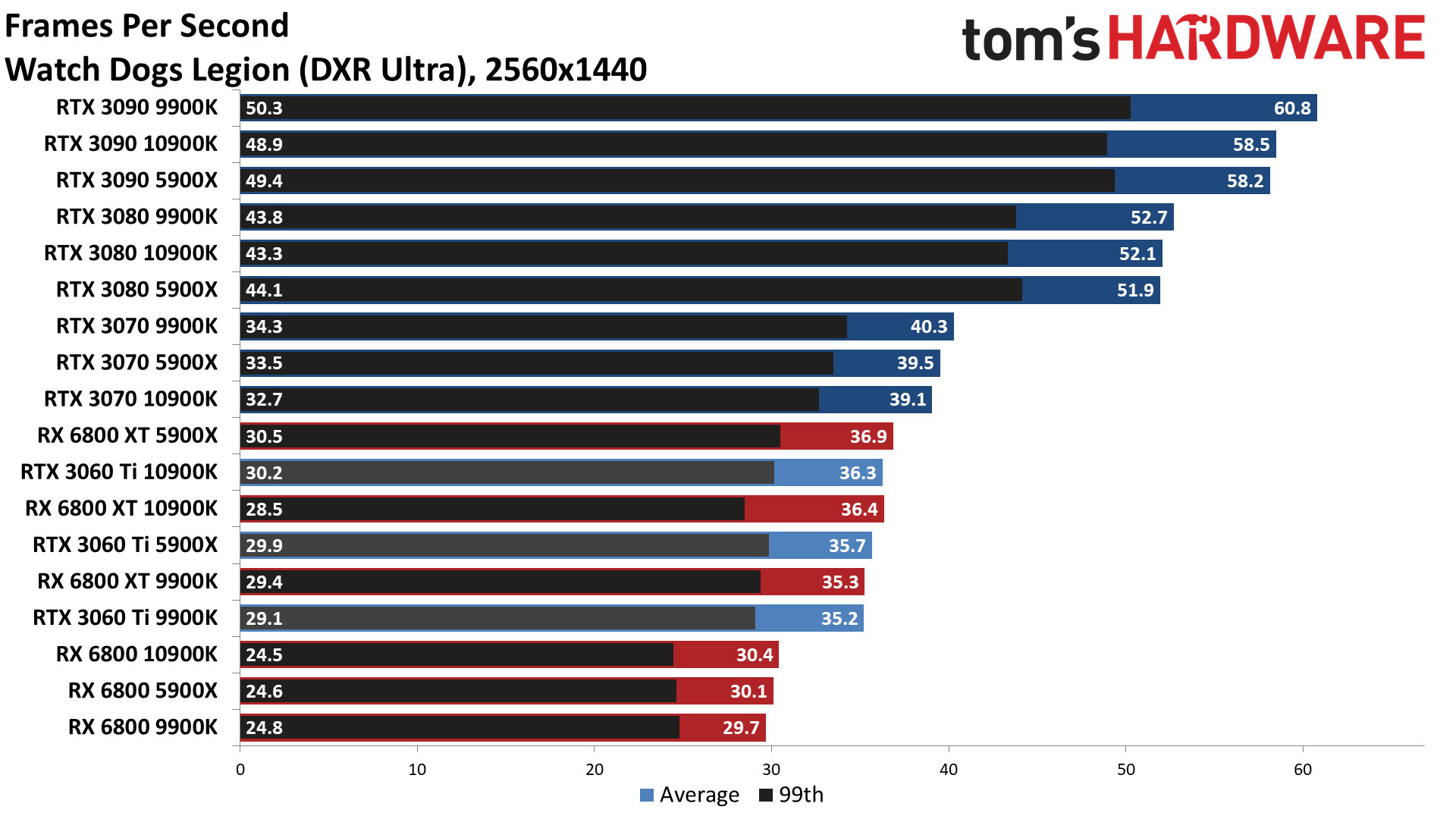
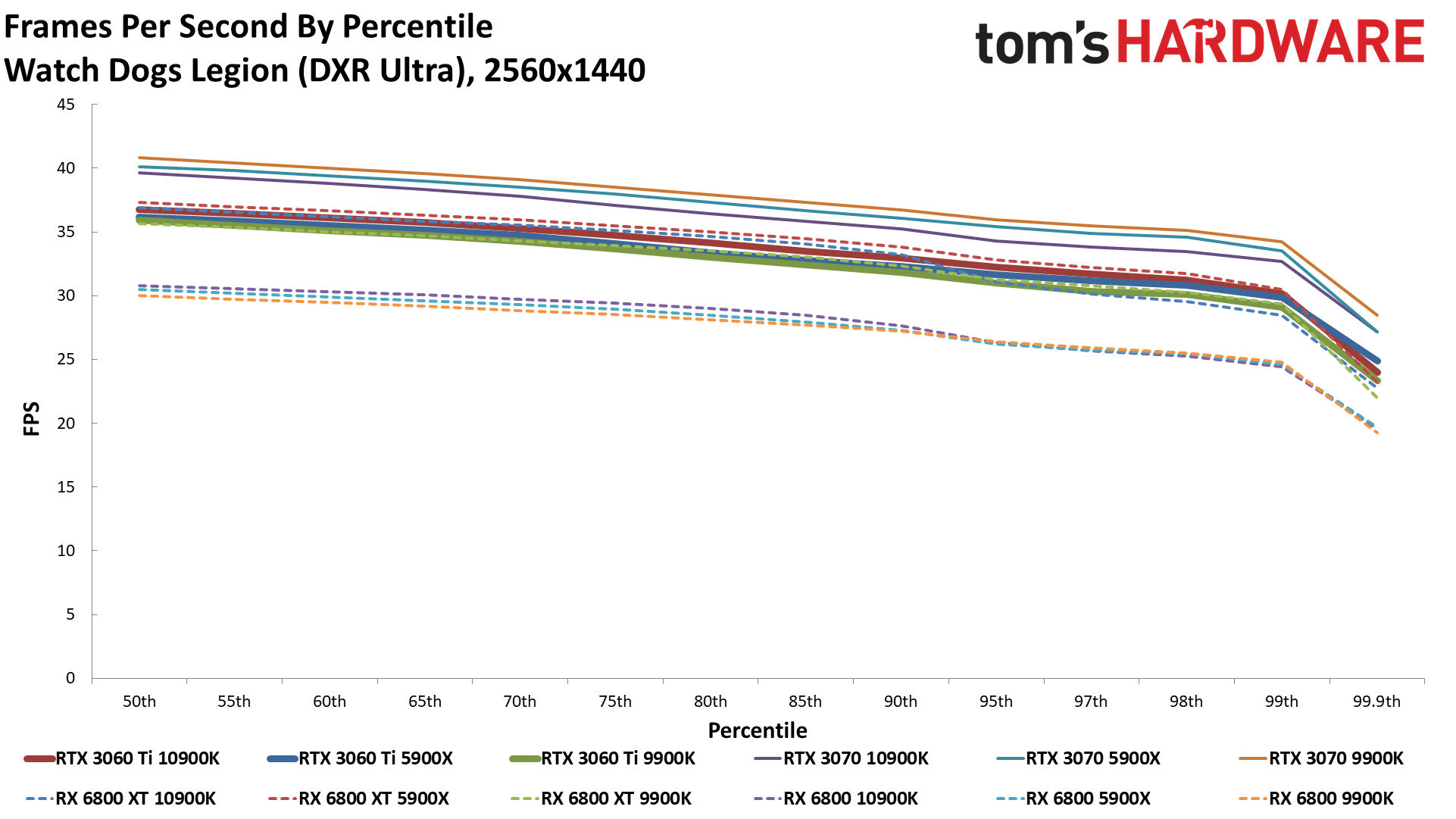
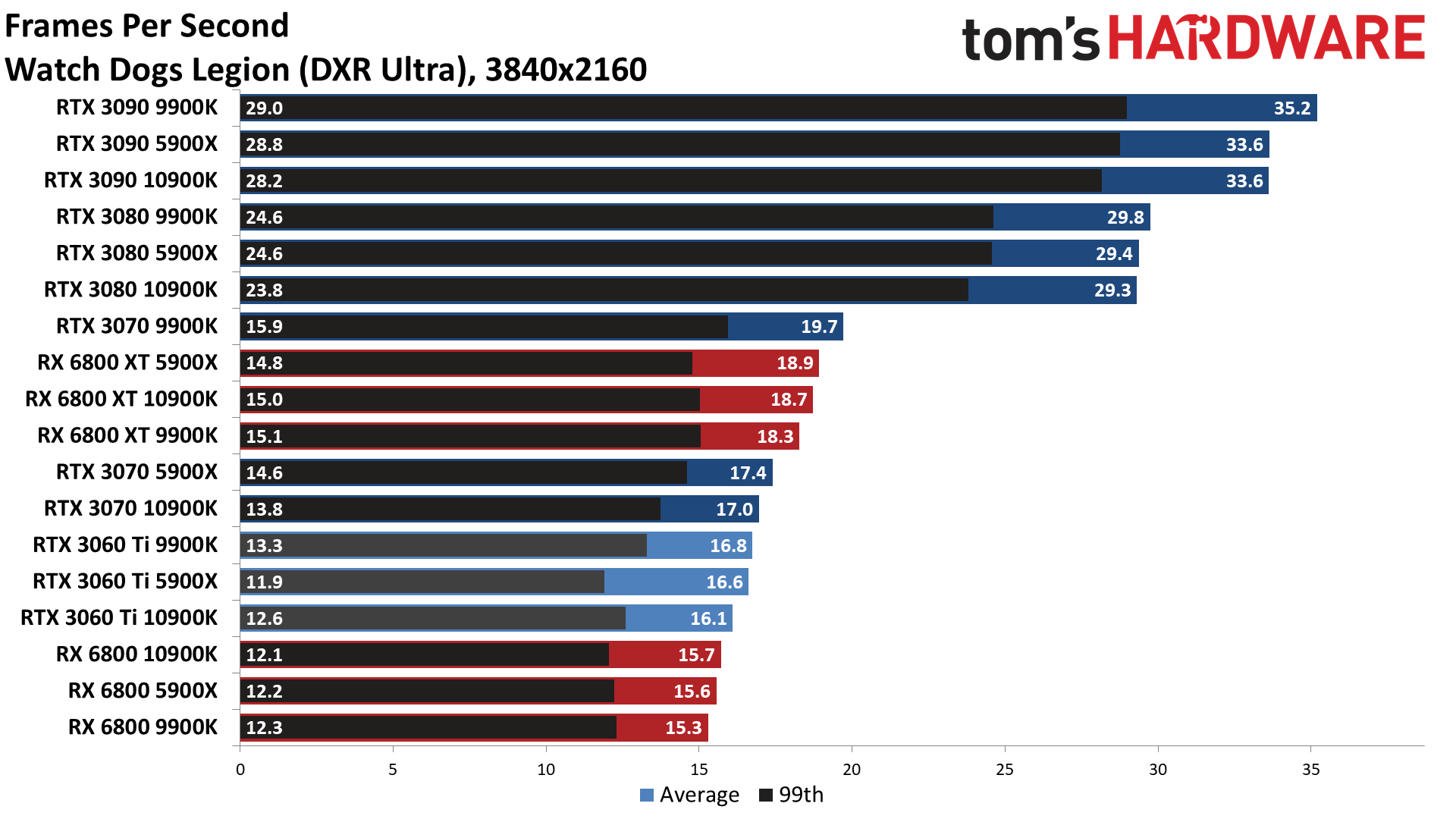
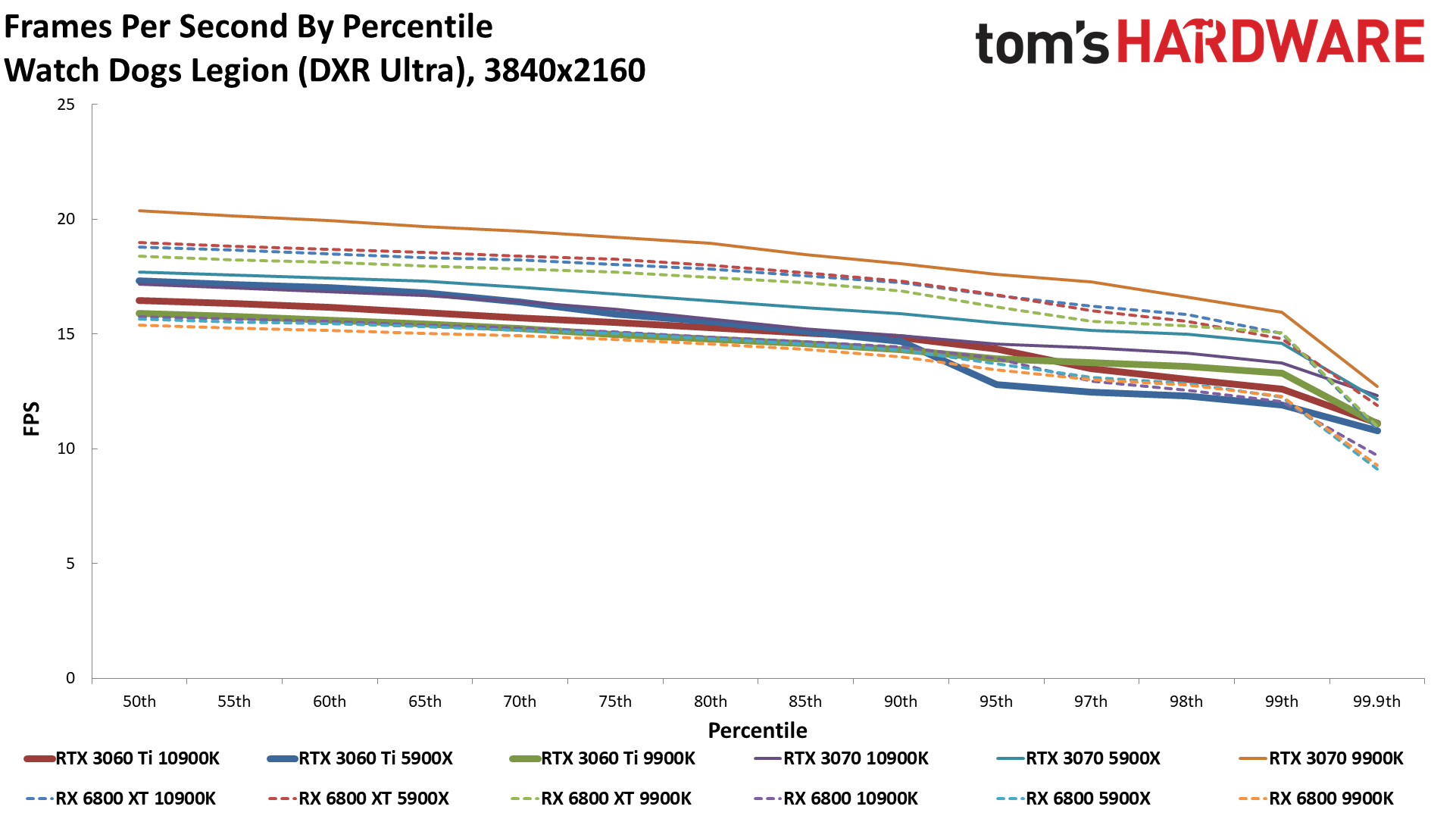
Last but not least, Watch Dogs Legion is our second DXR enabled game for the expanded test suite. This time, we're looking at an Nvidia promoted game, and patches and driver updates have fixed AMD's earlier rendering problems. (At launch, the RX 6800 cards weren't rendering all of the ray tracing effects properly and performed about 40 percent better than the new results shown here.)
With the full DXR rendering now in place, Big Navi doesn't look so hot. In fact, the RTX 3060 Ti basically ties the RX 6800 XT at 1080p and 1440p, and we won't worry much about the 4K results considering nothing is even remotely playable — at least not without DLSS enabled. How does the 3060 Ti with DLSS perform? We'll get to that next.
MORE: Best Graphics Cards
MORE: GPU Benchmarks
MORE: All Graphics Content
Current page: Nvidia GeForce RTX 3060 Ti — Extended Test Suite and CPU Scaling
Prev Page Nvidia GeForce RTX 3060 Ti — 4K Gaming Benchmarks Next Page Nvidia GeForce RTX 3060 Ti — Ray Tracing and DLSS Performance
Jarred Walton is a senior editor at Tom's Hardware focusing on everything GPU. He has been working as a tech journalist since 2004, writing for AnandTech, Maximum PC, and PC Gamer. From the first S3 Virge '3D decelerators' to today's GPUs, Jarred keeps up with all the latest graphics trends and is the one to ask about game performance.
-
JarredWaltonGPU FYI, the initial 3060 Ti review went up on December 1. It was a single monolithic page, for "reasons" related to our CMS and Google. We are now reposting the content in paginated form and redirecting the original article (https://www.tomshardware.com/news/nvidia-geforce-rtx-3060-ti-founders-edition-review), which means no comments get carried over unfortunately. The text and charts have not changed, on any of the reviews. It's just a change in the presentation. The comments from the first version of the article can be seen here:Reply
https://forums.tomshardware.com/threads/nvidia-geforce-rtx-3060-ti-founders-edition-review-ampere-for-only-399.3667330/ -
MihaiPop ReplyAdmin said:The RTX 3060 Ti is affordable and beats the 2080 Super in performance.
Nvidia GeForce RTX 3060 Ti Founders Edition Review: Ampere for Only $399 : Read more
Hi,
How can I buy this in europe?
It's everywhere out of stock. -
Matt_ogu812 ReplyAndrei2k said:Affordable and relative performance is irrelevant if its unavailable.
Exactly my thoughts just like many other of the 3k series of Nvidia GPU's. -
SyDiko ReplyAndrei2k said:its unavailable.
You can buy it from eBay for the hefty price of 1 kidney, so in the authors eyes its available. -
Soaptrail ReplyJarredWaltonGPU said:FYI, the initial 3060 Ti review went up on December 1. It was a single monolithic page, for "reasons" related to our CMS and Google. We are now reposting the content in paginated form and redirecting the original article (https://www.tomshardware.com/news/nvidia-geforce-rtx-3060-ti-founders-edition-review), which means no comments get carried over unfortunately. The text and charts have not changed, on any of the reviews. It's just a change in the presentation. The comments from the first version of the article can be seen here:
https://forums.tomshardware.com/threads/nvidia-geforce-rtx-3060-ti-founders-edition-review-ampere-for-only-399.3667330/
Thank you because i was wondering why this new review which seemed like it was not new. -
jeffredo To coin an old phrase "vaporware" for all intents and purposes. At least until supply actually allows them to be in stock in numbers enough to bring the price down despite miners.Reply -
Unolocogringo Reply
There are lots of cards available if you wish to pay scalper prices for them on ebay, etsy, stockx, gov group, craigslist etc....jeffredo said:To coin an old phrase "vaporware" for all intents and purposes. At least until supply actually allows them to be in stock in numbers enough to bring the price down despite miners.
All at 50-100% mark up from retail prices. -
WarNerve I just came across this "review" for the 3060 Ti.Reply
It says, "The 3060 Ti breaks 60 fps at 1080p native, and DLSS can further improve its performance. At 1440p, DLSS Quality mode still manages a decent 67 fps, and the 3060 Ti continues to lead AMD's options."
I don't know what their talking about. I have a 3060 Ti and at 1080p ,even on High/Ultra settings, I get 144fps on most games. The lowest I've come across so far has been around 80fps. And even without DLSS at 1440p the frames are still around 80-100fps.
Not to mention that the 3060 Ti is not an AMD card. Maybe that's not what the author meant when he said, "the 3060 Ti continues to lead AMD's options.", but that's what that wording means. It means that the 3060 Ti is AMD's best offering. I'm just nitpicking, I know. But it matters. Especially if you're writing a lot of reviews and such.
Edit: I know I'm responding to a fairly old post, but the article that lead me here was one of the top recommendations when I searched for info on Google. So I figure, even if a post is old, it's still relevant if people are still being directed to it. -
JarredWaltonGPU Reply
There are several issues with what you’re saying, mostly to do with reading comprehension. When I say the 3060 Ti “leads AMD’s options,” I obviously mean in the context of this review: the Nvidia 3060 Ti is ahead of AMD’s competing cards.WarNerve said:I just came across this "review" for the 3060 Ti.
It says, "The 3060 Ti breaks 60 fps at 1080p native, and DLSS can further improve its performance. At 1440p, DLSS Quality mode still manages a decent 67 fps, and the 3060 Ti continues to lead AMD's options."
I don't know what their talking about. I have a 3060 Ti and at 1080p ,even on High/Ultra settings, I get 144fps on most games. The lowest I've come across so far has been around 80fps. And even without DLSS at 1440p the frames are still around 80-100fps.
Not to mention that the 3060 Ti is not an AMD card. Maybe that's not what the author meant when he said, "the 3060 Ti continues to lead AMD's options.", but that's what that wording means. It means that the 3060 Ti is AMD's best offering. I'm just nitpicking, I know. But it matters. Especially if you're writing a lot of reviews and such.
Edit: I know I'm responding to a fairly old post, but the article that lead me here was one of the top recommendations when I searched for info on Google. So I figure, even if a post is old, it's still relevant if people are still being directed to it.
That also goes with the FPS metrics. If you play lighter games, you will get higher performance. The “67 fps” refers specifically to a game tested in this review. You quoted one specific sentence that refers to one specific game. That should be enough to give you context:
“Call of Duty: Black Ops Cold War uses ray tracing effects for shadows, with a higher fidelity (and more demanding) result in the previous Modern Warfare (2019) reboot. The 3060 Ti breaks 60 fps at 1080p native, and DLSS can further improve its performance. At 1440p, DLSS Quality mode still manages a decent 67 fps, and the 3060 Ti continues to lead AMD's options. The 6800 XT does squeak ahead at 4K, probably thanks to its 16GB of memory, but we doubt many people are going to want to play multiplayer Call of Duty at 30 fps.”
The data is all there for you to see. If you want to know how the games tested in late 2020 performed on a 3060 Ti, look at the charts. Other games will perform differently. You can look at the current GPU Benchmarks Hierarchy for more recent testing on newer games that didn’t exist when the 3060 Ti came out.